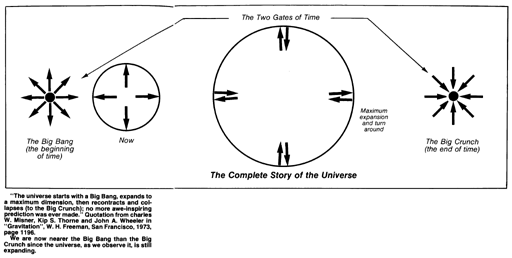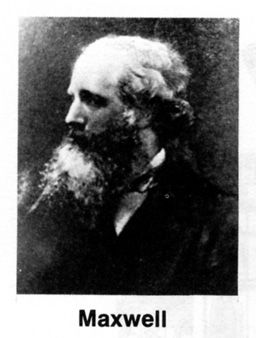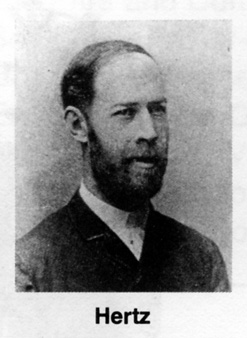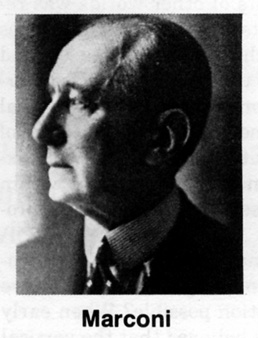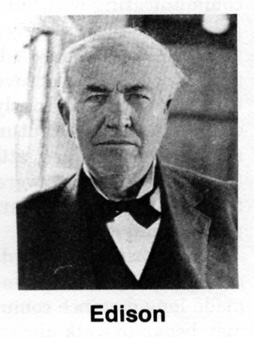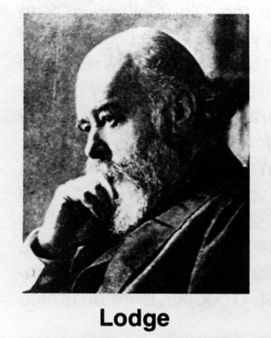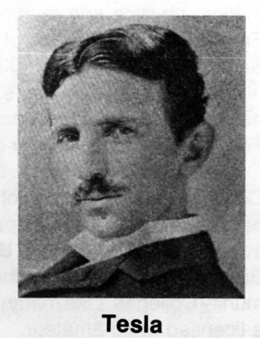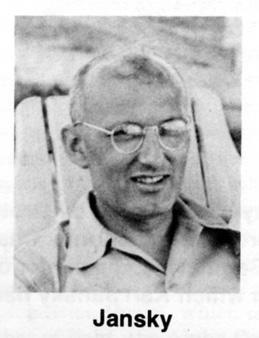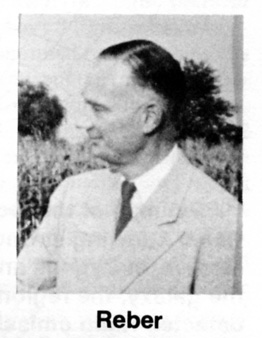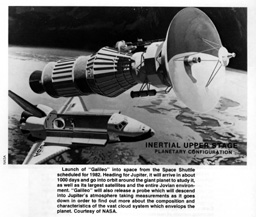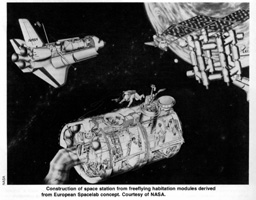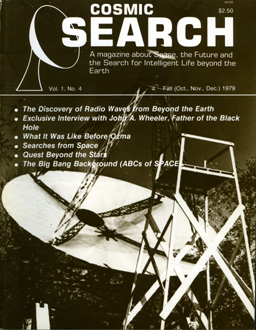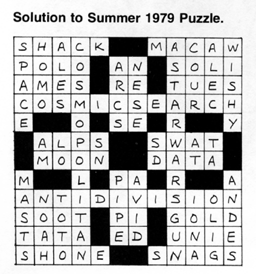![[NAAPO Logo]](../../Images/NAAPOsm.jpg)
North American AstroPhysical Observatory (NAAPO)
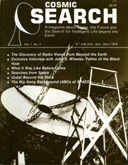
Cosmic Search: Issue 4
(Volume 1 Number 4; Fall (Oct., Nov., Dec.) 1979)
[All Articles & Miscellaneous Items]
|
Webpage Table of Contents (Bookmarks)
(Internal links to items in this webpage)
[Note. Use Back button (or <Alt>+<Left Arrow>) to get back to this Table of Contents after you have clicked on a link and viewed the article.]
Codes Used Below:
P: Starting page of article in magazine; A: Author(s); T: Title of article
FORUM:
From the Big Bang to the Big Crunch
[Article in magazine started on page 2]
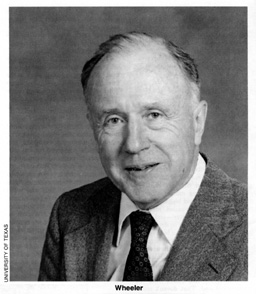 Scientist-philosopher, teacher-cosmologist, father of the Black Hole, Wheeler's thoughts encompass the entire cosmos from the Big Bang to the Big Crunch.
Scientist-philosopher, teacher-cosmologist, father of the Black Hole, Wheeler's thoughts encompass the entire cosmos from the Big Bang to the Big Crunch.
This exclusive interview with John A. Wheeler was made by Mirjana R. Gearhart of COSMIC SEARCH.
COSMIC SEARCH: You have often commented that the greatest discoveries of science are yet to come. What do you have in mind?
Wheeler: To me, the greatest discovery yet to come will be to find how this universe, coming into being from a Big Bang, developed its laws of operation. I call this "Law without Law".* (*Or "Order from Disorder".)
COSMIC SEARCH: Could you explain further?
Wheeler: One of the biggest problems is how to state the problem. It's an old saying that the minute you can state a problem correctly you understand 90 percent of the problem. One of the greatest problems concerns the meaning of measurement or observation. According to quantum theory, measurements can influence what happens. The fact that it is difficult to talk about this problem in an easy way suggests that we have much to learn.
This is a partial response to your question. Putting it another way: How can we possibly imagine the universe with all its regularities and its laws coming into being out of something utterly helter-skelter, higgledy-piggledy and random?
Or, in still another form: If you were the Lord constructing the universe, how would you have gone about it?
COSMIC SEARCH: That certainly is a very deep question.
Wheeler: It's inspiring to read the life of Charles Darwin and think how the division of plant and animal kingdoms, all this myriad of order, came about through the miracles of evolution, natural selection and chance mutation. To me this is a marvelous indication that you can get order by starting with disorder.
COSMIC SEARCH: Do you think there can be any progress on this problem?
Wheeler: One of the conditions, I think, for advance in this field, as in any field, is believing that advance is
possible. What I hope I'm creating is a sense of faith that it can be done. Faith is the number one element. It isn't
something that spreads itself uniformly. Faith is concentrated in a few people at particular times and places. If you can involve young people in an atmosphere of hope and faith, then I think they'll figure out how to get the answer. Faith and hope are absolutely central to everything one does.
You need people who have imagination, daring and the ability to get somewhere. That, to me, is the way research works.
Of course another point to all of this is to keep in touch with key ideas, with what people are doing. Make sure you aren't overlooking something. Here's where it's so important to talk with the young people. Some modest young person comes along with some idea no one else is paying any attention to. His idea may just be the central point.
I'm very fortunate that at Austin, the University of Texas has been willing to finance this kind of work, bringing in two or three people each year for a period of time. So, we'll see what happens.
COSMIC SEARCH: You were a colleague of Albert Einstein. We are celebrating the 100th anniversary of his birth this year. When did you first meet him?
Wheeler: October 1933, the month he took up permanent residence in the U.S. was my first meeting with Einstein. Then in 1953, when I first started to teach relativity at Princeton, he was kind enough to invite me to bring my students around to his house for discussions. So, we sat around the dining room table and his secretary, Helen Dukas, and his stepdaughter,
Margot, brought tea and the students asked him questions.
COSMIC SEARCH: Are there some tenets of his that stand out in your mind?
Wheeler: Yes, his work revolved around three rules which apply to all science, our problems, and times:
1. Out of clutter, find simplicity;
2. From discord make harmony; and finally
3. In the middle of difficulty lies opportunity.
COSMIC SEARCH: You began your work in relativity about that time then?
Wheeler: Yes, it was about the period 1952-53-54-55, Einstein's last four years, when I was just getting into relativity. The thing that really got me into it more than anything else was this concern about what happens to a cloud of matter when it collapses. What's the final state?
I had not yet invented the term "black hole". I hadn't yet realized how important it was to attach a name to this concept.
COSMIC SEARCH: How did you come up with the name "black hole"?
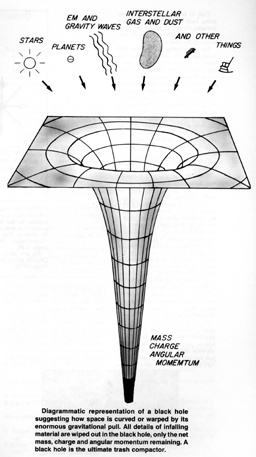 Wheeler: It was an act of desperation, to force people to believe in it. It was in 1968, at the time of the discussion of whether pulsars were related to neutron stars or to these completely collapsed objects. I wanted a way of emphasizing that these objects were real. Thus, the name "black hole".
Wheeler: It was an act of desperation, to force people to believe in it. It was in 1968, at the time of the discussion of whether pulsars were related to neutron stars or to these completely collapsed objects. I wanted a way of emphasizing that these objects were real. Thus, the name "black hole".
The Russians used the term frozen star—their point of attention was how it looked from the outside, where the material moves much more slowly until it comes to a horizon.* (*Or critical distance. From inside this distance there is no escape.) But, from the point of view of someone who's on the material itself, falling in, there's nothing special about the horizon. He keeps on going in. There's nothing frozen about what happens to him. So, I felt that that aspect of it needed more emphasis.
COSMIC SEARCH: A few years ago you asked the question: "Are life and mind irrelevant to the structure of the universe, or are they central to it?" Have you found an answer?
Wheeler: No, I'm one of the most baffled men in the world on this subject. There is a line of investigation involving the anthropic (or man-related) principle—the idea that the universe has to be much as it is or life would be impossible. Not only life as we know it, but any life at all would be impossible. On what else can a comprehensible universe be built but the demand for comprehensibility?
My Princeton colleague, Robert Dicke, expressed it this way:
What good is a universe without somebody around to look at it?
That, to be sure, was an old idea, going back not only to the Bishop Berkeley of the time of Newton, but all the way back to Parmenides, the precursor of Socrates and Plato.
But it was new in the form that Dicke put it. He said if you want an observer around, you need life, and if you want life, you need heavy elements. To make heavy elements out of hydrogen, you need thermonuclear combustion. To have thermonuclear combustion, you need a time of cooking in a star of several billion years. In order to stretch out several billion years in its time dimension, the universe, according to general relativity, must be several billion years across in its space dimensions.
So why is the universe as big as it is? Because we're here!
COSMIC SEARCH: A very interesting view.
Wheeler: You could put it another way: You can say there's an efficiency expert who's come to look over the Lord's shoulder. He says,
"Why, Lord, you're wasting a lot of money on this universe. See, you've put one hundred billion (1011) stars in the Milky Way, and you've put one hundred billion (1011 Milky Ways in the universe—that's ten billion trillion (1022) stars—that's a mighty extravagant way to get one planet (the Earth) with life on it so there'll be somebody around to be aware of this universe. Now, Lord, we efficiency people want to cut you down, but we won't cut you down to one star. Instead of 10 billion trillion stars, we'll cut you down to one hundred billion stars—that's enough to make one galaxy. This will be a great economy move."
The only problem is, according to general relativity, when you cut the amount of mass down by a factor of 100 billion, you also cut the size of the universe down by the same amount, just enough universe for one galaxy. You also cut down the time from the Big Bang to the Big Crunch from 100 billion years to just one year which isn't time enough to evolve even one star, let alone evolve life.
Put it another way. There's no obvious extravagance of scale in the construction of the universe. The efficiency expert would have a right to complain if life had been created on several planets, in several parts of the universe, because then he could say that's more than you really need in order for somebody to be around to be aware of the universe. But, if you have life on one planet only (the Earth), then, it's not obvious that you're being extravagant.
The anthropic principle provides a new perspective on the question of life elsewhere in space. It puts in question the common view that the universe is a big machine; that man is unimportant in the scheme of things; that we're an accidental bit of dust
that doesn't have anything to do with it all. From that point of view, it is not very important whether you're going to have life on a billion planets or on just one planet—or no life at all. Life or no life still wouldn't matter in the scheme of the universe.
But, if we adopt this other perspective that Dicke suggests—the anthropic principle—then it's quite a different assessment that we make. Then the universe has to be such as to permit awareness of that universe; otherwise the universe has no meaning.
The anthropic principle looks at this universe, that universe and the other universe and rules out as mere meaningless machines all those in which awareness does not develop somewhere at some time. Stronger than the anthropic principle is what I might call the participatory principle. According to it we could not even imagine a universe that did not somewhere and for some stretch of time contain observers because the very building materials of the universe are these acts of observer-participancy. You wouldn't have the stuff out of which to build the universe otherwise. This participatory principle takes for its foundation the absolutely central point of the quantum:
No elementary phenomenon is a phenomenon until it is an observed (or registered) phenomenon.
COSMIC SEARCH: You also collaborated with Niels Bohr. Could you tell us about him?
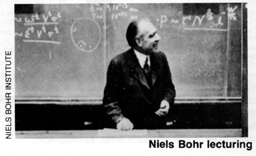 Wheeler: As a student in 1934, I applied for a fellowship to go to Copenhagen to study with Bohr. I remember writing down my reason on the application:
Wheeler: As a student in 1934, I applied for a fellowship to go to Copenhagen to study with Bohr. I remember writing down my reason on the application:
"Bohr sees further ahead in physics than any other man alive".
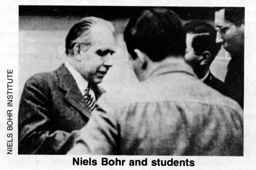 My fellowship was granted and the next year I went to study with Bohr, the great leader of physics and father-figure of all physicists. There in Copenhagen, Christian Møller, just back from Rome, reported Fermi's results on the capture of slow neutrons. Bohr immediately became terribly concerned, and interrupting Møller, talked and talked while walking back and forth. All the while you could see the liquid drop model of the nucleus taking shape right there before your eyes. For him no physics was of any interest unless it yielded some paradox or some beautiful way of seeing things simply.
My fellowship was granted and the next year I went to study with Bohr, the great leader of physics and father-figure of all physicists. There in Copenhagen, Christian Møller, just back from Rome, reported Fermi's results on the capture of slow neutrons. Bohr immediately became terribly concerned, and interrupting Møller, talked and talked while walking back and forth. All the while you could see the liquid drop model of the nucleus taking shape right there before your eyes. For him no physics was of any interest unless it yielded some paradox or some beautiful way of seeing things simply.
I do not remember anyone at Bohr's institute who ever succeeded in finishing a seminar talk, even though he was the invited speaker. He might be able to speak fifteen minutes, but soon Bohr would take over and would use the whole time discussing the meaning of the speaker's results and what they proved or disproved.
COSMIC SEARCH: You were also involved with Bohr later, weren't you?
Wheeler: Yes, I was down at the pier in New York on January 16, 1939, to meet him, and I had hardly said "Hello" when I learned that just before his ship left Copenhagen, he had been told of the discovery of nuclear fission by Hahn and Strassmann. So we dropped everything else and started to work on fission.
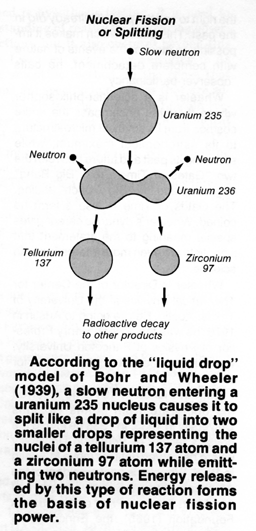 During the war I met Bohr in Washington at the time he was dividing his time between Los Alamos and Washington. He told me confidentially about his discussions with President Roosevelt about the future of nuclear energy. He told me about his efforts to work out some kind of control of nuclear energy after the war.
During the war I met Bohr in Washington at the time he was dividing his time between Los Alamos and Washington. He told me confidentially about his discussions with President Roosevelt about the future of nuclear energy. He told me about his efforts to work out some kind of control of nuclear energy after the war.
Bohr made a great impression on Roosevelt and they had several discussions. The last speech Roosevelt wrote—he died while he was still working on it—had in it some words, quoted by Roosevelt from Thomas Jefferson, about how scientists serve as indispensable means of communication for bringing peace between different countries of the world.
It was enormously impressive to me to see Bohr's courage in facing up to what the great questions were. I can vividly remember him saying to me:
"I must always seem to you like an amateur. But I am always an amateur."
Of course, that is a very modest way of saying that one is a pioneer, an explorer. If you are working on something new, then you are necessarily an amateur.
COSMIC SEARCH: Niels Bohr created one of the world's most influential schools of modern physics in Copenhagen. You, too, have educated many leading physicists, both in nuclear physics and in general relativity, at Princeton. Do you have some
thoughts about educating students?
Wheeler: Shouldn't you rephrase your question? After all, I'm sure that it is really the students who educate me! We all know that the real reason universities have students is to educate the professors. But, in order to be educated by the students, one has to put good questions to them. You try out your questions on the students. If there are questions that the students get interested in, then they start to tell you new things and keep you asking more new questions. Pretty soon you
have learned a great deal.
COSMIC SEARCH: What insights can one gain from the collapse of a star into a black hole as regards the ultimate collapse of the universe?
Wheeler: I would regard the black hole as a here-and-now model for the collapse of the universe. We've come to
recognize that in the typical closed-model universe, a black hole that forms at some point in the history of the universe is not a singularity—a Gate of Time—separate and distinct from the Big Crunch, but is part and parcel of the same thing.
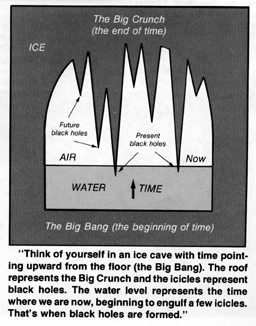 Let me put it this way. If you'll permit, let's imagine ourselves as in an ice cave, and let's think of time as pointing upward from the floor. The floor of ice represents the Big Bang. The roof of ice represents the Big Crunch—and some spikes hanging down, icicles, represent black holes. Think of water gradually filling the cave as it comes up, representing the advance of time. No water, and you're back at the Big Bang; a little water, and you're in the early days of the universe. More water and your time level is where we are now. As the water rises—as time goes on—it engulfs a few of the spikes, the icicles—that's the moment when black holes are formed. Keep the water level going on up and you get to the point where the spikes are completely immersed and the water even reaches to the top of the cave. Then you have arrived at the Big Crunch. From this point of view, you can see that the Big Crunch or final Gate of Time is not distinct in nature from the black hole. They're the same kind of animal. In that sense, learning about a black hole is learning about the final stages of the universe.
Let me put it this way. If you'll permit, let's imagine ourselves as in an ice cave, and let's think of time as pointing upward from the floor. The floor of ice represents the Big Bang. The roof of ice represents the Big Crunch—and some spikes hanging down, icicles, represent black holes. Think of water gradually filling the cave as it comes up, representing the advance of time. No water, and you're back at the Big Bang; a little water, and you're in the early days of the universe. More water and your time level is where we are now. As the water rises—as time goes on—it engulfs a few of the spikes, the icicles—that's the moment when black holes are formed. Keep the water level going on up and you get to the point where the spikes are completely immersed and the water even reaches to the top of the cave. Then you have arrived at the Big Crunch. From this point of view, you can see that the Big Crunch or final Gate of Time is not distinct in nature from the black hole. They're the same kind of animal. In that sense, learning about a black hole is learning about the final stages of the universe.
Although many articles are being written about the outsides of black holes, hardly any deal with the question of what happens inside the black hole, on the way to the Big Crunch. All the indications I can see point to it being the direct opposite of what happens on the outside. The outside settles down to a steady standard condition. If it's perturbed a little bit away
from that ideal state, it once again reverts to the steady condition.
But, on the inside, the condition is the exact opposite, in the sense that if the collapse of matter is not exactly symmetric, then the perturbations from the infalling matter will get worse and worse, and bigger and bigger. There will be so-called "mixmaster" oscillations. Matter—and space geometry as well—will be driven into a gigantic chaos. If, as we believe, the black hole is really part and parcel of the final singularity, then these "mixmaster" oscillations should be a
common property of black holes and the big crunch. We have much to learn from studying this chaos from the theoretical end. That doesn't mean these extreme conditions have no observational consequences; they certainly do.
One might question this point. One might ask, what sense is it to talk about the physics inside a black hole? Who's ever going to fall inside a black hole? But, here we are living inside—if Einstein is correct—a closed universe, and we will eventually head into a Big Crunch ourselves—so the laugh's on us!
COSMIC SEARCH: If that is true—that the last laugh is on us, how does that affect mankind's attitude?
Wheeler: If the universe is only going to last for a finite time, I think it's far too early in the scheme of things to try to draw conclusions about how we should react. We're still so much in the learning phase. We have to keep separate what we're learning from our attitudes.
To me to live a one-life-only in a one-life-only universe provides a poetic parallelism. How precious life is! Every day, every person one meets, every experience—that's all we're going to have. It distresses me that so many people go through life in an alienated spirit, not realizing that this is the only opportunity they have—they'll never have it again.
COSMIC SEARCH: We certainly are at a very important time in mankind's thinking about its place in the universe. Thank you, Professor Wheeler, for sharing with us a glimpse of these great discoveries yet to come.
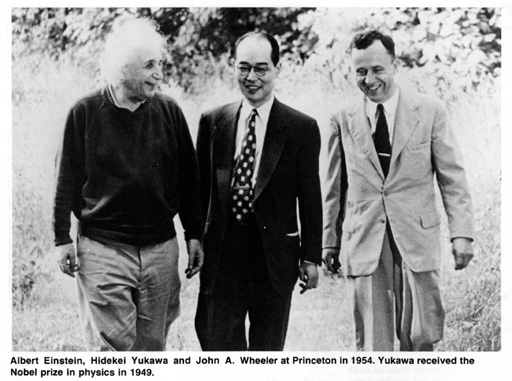

 John Archibald Wheeler has been at the forefront of theoretical physics for nearly five decades. In the 1930's, with
Niels Bohr, he developed the first general theory of nuclear fission. In the 1940's, with a student, Richard Feynman, he discovered a new approach to electrodynamics which has proven to be of great value. In the 1950's he found new solutions to Einstein's gravitational equations of importance in astrophysics. In the 1960s he pioneered studies involving gravitational collapse, neutron stars and Black Holes (a name he invented). More recently Wheeler has proposed and analyzed "delayed
choice" experiments. In them a difference in what one measures on the particle—or photon—now makes an irretrievable difference in what one has the right to say the particle already did in the past. This effect, which makes it impossible to monitor the events of nature with complete detachment, he calls "observer-participancy".
John Archibald Wheeler has been at the forefront of theoretical physics for nearly five decades. In the 1930's, with
Niels Bohr, he developed the first general theory of nuclear fission. In the 1940's, with a student, Richard Feynman, he discovered a new approach to electrodynamics which has proven to be of great value. In the 1950's he found new solutions to Einstein's gravitational equations of importance in astrophysics. In the 1960s he pioneered studies involving gravitational collapse, neutron stars and Black Holes (a name he invented). More recently Wheeler has proposed and analyzed "delayed
choice" experiments. In them a difference in what one measures on the particle—or photon—now makes an irretrievable difference in what one has the right to say the particle already did in the past. This effect, which makes it impossible to monitor the events of nature with complete detachment, he calls "observer-participancy".
Wheeler is a scientist-philosopher whose thoughts encompass the entire cosmos from its smallest microstructure to its astronomical maximum, while spanning its past and future between the two "Gates of Time": the "Big Bang" beginning and the Big Crunch" ending. The Gates of Time is also a term he coined. Wheeler's dynamic career gives special meaning to the statement that scientists are even more interesting than science.
Wheeler is Director of the Center for Theoretical Physics at the University of Texas, Austin. Before going to Austin in 1976, he was the Joseph Henry Professor of Physics at Princeton University, where he had been a faculty member for 38 years.
Born in Florida in 1911, he received his doctorate from Johns Hopkins University in 1933. In 1938 he joined the physics faculty of Princeton University where he served until his move to Austin in 1976. Wheeler is past president of the American Physical Society, recipient of the Albert Einstein Prize of the Strauss Foundation (1965), the Enrico Fermi Award for his work on nuclear fission (presented by President Lyndon Johnson in 1968), the Franklin Medal of the Franklin Institute (1969), and the National Medal of Science (1971), as well as numerous honorary degrees.
He is the author of many scientific articles and author or co-author of six books. His famous, monumental 1280-page text "Gravitation" (1973) was written in collaboration with his former students Kip Thorne and Charles Misner; his most recent, "Frontiers of Time", appeared in 1979.
A man of great modesty, Wheeler radiates a contagious enthusiasm coupled with a charming informality. He has a fondness for paradox as epitomized by: "We will first understand how simple the universe is when we recognize how strange it is".
Wheeler on Science:
- "The greatest discoveries are yet to come."
- "What good is a universe without somebody around to look at it?"
- "There's no obvious extravagance of scale in the construction of the universe."
- "If you're working on something new, then you are necessarily an amateur."
- "So, why is the universe as big as it is? Because we're here!"
- "Learning about a black hole is learning about the final stages of the universe."
- "You have to keep separate what we're learning from our attitudes."
- "We will first understand how simple the universe is when we recognize how strange it is."
- "The real reason universities have students is to educate the professors. "
- "You need people who have the imagination, daring and ability to get somewhere. That is the way research works."
- "No elementary phenomenon is a phenomenon until it is an observed phenomenon."
|
|
Letters
By: Editors
[These letters in the magazine were found on pages 9 & 10]
I think COSMIC SEARCH is one of the best journals I have ever read. All the articles are very interesting. It is a bestseller in our library. Congratulations to you and a long life to this excellent magazine.
Dr. Hans-Ulrich Keller
Director, Stuttgart Planetarium
Germany
The third issue of COSMIC SEARCH is the best yet. How do you do it? Your material is so readable and yet accurate scientifically.
Professor Raymond M. Bell
Washington and Jefferson College
Washington, Pennsylvania
I am writing for permission to reprint parts of the ABCs section of COSMIC SEARCH. We are enthusiastic, highly-impressed new subscribers to your magazine.
Susan Moger, Editor
Dept. of Technology and Society
State University of New York at Stony Brook
The publication of COSMIC SEARCH is an historical event. My sincere congratulations.
Florin Gheorghita
Atanasie, Romania
Congratulations on the launch of a most impressive and timely new magazine, COSMIC SEARCH.
Louis Berman
Astronomy Department
University of San Francisco
Author of "Exploring the Cosmos", Little Brown and Co., Boston, 1973
Your magazine is fantastic!
Chuck Harrington
Hermosa Beach, California
It's refreshing to read a responsible publication concerned with such an extremely exciting topic.
Robert Morton
Los Angeles, California
Here is my donation which I hope will help keep your magazine in business. I have enjoyed the three issues you have sent me and am sure they will be worth their weight in gold some day.
Paul Simons
Sheboygan, Wisconsin
I am completely satisfied with the first three issues of COSMIC SEARCH. Although I am only an interested bystander in SETI, I find the articles presented at a level that is comprehensible and very thought provoking. I am a terrestrial microwave
link engineer and along this line I would like to see quasi-technical/photo essay articles on some of the larger radio telescopes. Enclosed is a donation for publication support.
David M. Laida
Sierra Vista, Arizona
To Paul Simons and David Laida
Thank you very much for your donations. Your gifts are tangible evidence that you want the magazine to succeed. This is of great encouragement to us and we will try even harder to keep going.
COSMIC SEARCH
I can't express in words just how excited I am about COSMIC SEARCH. Already it has helped me enormously with a major term paper concerning the search for extraterrestial life and I count the days until I receive my next issue!
Tom Peirce
Hightstown, New Jersey
I am in receipt of my second copy of COSMIC SEARCH which I have found to be exactly the kind of magazine I have always wanted to subscribe to.
Phillip W. Morris
Dallas, Texas
Keep up the good work.
Charles P. Callihan
Riverside, California
Let me commend you on COSMIC SEARCH. I know all too well what it takes to get such a publication into production. Nevertheless, everything seems top-notch to me. Your articles, illustrations and other material are right on target. I think there certainly should be a market for such a publication as yours, aimed at the layman. I have found that the general public is much interested in the subject matter but, unfortunately, gets mostly a lot of hokum instead.
A hearty huzzah to all of you for your good work with the magazine. I look forward most eagerly to te issues to come.
Frank Stilley
Glen Oaks, New York
Author of "The Search—Our Quest for Intelligent Life in Outer Space", G. P. Putnam's Sons, New York, 1978.

In regard to the item on page 35 of the Summer 1979 issue of COSMIC SEARCH concerning "Doppler-independent Selective Heterodyne Radiometry for Detection of Remote Species", the word "specie", as we all know, is coined money. And the detection of remote species (typically with the implicit goal of bringing it nearer) is, therefore, one of the primary tasks of any director of a research group. We fear, however, that nefarious means are herein contemplated. Apparently the authors have in mind (probably illicit) monitoring, by selective heterodyne techniques, of such conversations among high government officials as may be carried by microwaves (for example, from earth station to satellite and back) and may pertain to available funding. The need for Doppler-independence suggests they contemplate including conversations from mobile (automobile and aircraft-borne) officials in their efforts. I trust this explanation will enable you to make use of similar techniques to improve the financial position of the SETI effort!
Virginia Trimble
Department of Physics
University of California at Irvine
I have enjoyed your COSMIC SEARCH magazine. Keep up the good work.
Eytan Wronker
Jamaica, New York
A long wait was made worth it when my first two copies of COSMIC SEARCH arrived two weeks ago. It is a magnificent magazine and my copies are already looking the worse for wear after being shown around to everyone I have seen since.
While I was waiting for COSMIC SEARCH to arrive I became involved in helping Mr. John Prytz of Canberra campaign for an Australian SETI programme by writing to some of our Federal politicians. Luckily, two issues of COSMIC SEARCH arrived together in time for me to show them to everyone whom I have approached to sign Mr. Prytz's petition in support of SETI. You may like to know that out of 120 people (mostly non-academics) only 10 have not been interested, and 12 have taken copies of the petition themselves to help collect signatures! This shows that probably most people would support SETI if they knew
about it. The problem is how to get access to a large section of the public! However, I am going to keep on trying and am eagerly looking forward to the next issues of COSMIC SEARCH.
Jane L. Brooks
Millswood, South Australia
Assuming life exists in space, the new science of exobiology was founded.
Now we can go a step further. Since science today assumes a very large number of extraterrestrial civilizations and accepts the existence of extraterrestrial consciousness, I suggest we establish exopsychology, the science of extraterrestrial consciousness.
A. Hedri, M.D.
Zurich, Switzerland
Your interpretation of "E pluribus unum" is literally correct, "One of many". However, it loses entirely the true sense of the motto, which is that we have made one thing, The United States, out of many things, the individual states.
If CETI is ever established, even one way, it may help the nations of the earth to become "E pluribus unum".
Arthur J. Morgan
New York, New York
Thanks for COSMIC SEARCH. I love it.
Michael H. Elliott
Van Nuys, California
Your magazine is a great concept and plan.
Malcolm H. Bremer, M.D.
Houston, Texas
Your journal is most exciting in its concept and excellent in its execution. Since you are publishing such a well-done journal on a shoestring, my astonishment and congratulations grow. Your magazine is unique too—a compendium of cosmological thought, with an eye toward developing a humanistic view and expectation in the astro-sciences.
Deborah F. Wiech
New York, N.Y.
I find COSMIC SEARCH fills a distinct void in the overall area of Space Biology. Keep up the good work.
J. Richard Keefe, Ph.D.
School of Medicine
Case Western Reserve University,
Cleveland, Ohio
I am a most enthusiastic subscriber to COSMIC SEARCH and am also an equally enthusiastic amateur radio astronomer fortunate enough to have a 25-ft. paraboloid and an antenna farm of yagis connected to low noise 600-900 MHz equipment in the
Florida Everglades.
We are presently embarking on a three-year program centered specifically on an attempt to receive and process anomalous pulses in this part of the radio spectrum. What we lack in sophistication of equipment, we make up with unlimited time because our
equipment when completed will operate 24-hours-a-day with little attention.
I thought you might be interested to hear that amateurs as well as professionals have an interest in such work.
Robert M. Sickels, Director
Fox Observatory,
Ft. Lauderdale, Florida
Congratulations on your excellent publication. I find your "Off the Shelf" feature extremely useful for tracking down reading material.
A. S. Furzer
London, England
I must take issue with the suggestion that microwave solar power satellites should not be built lest they interfere with astronomical observations.
The construction of such satellites would require space capabilities of a high order and would promise a rich economic return (If no return were foreseen they would not be built). A fraction of that capability and return could be devoted to SETI and astronomy in general. A space-borne, properly-shielded receiver would be subject to far less interference from earth than any possible earth-based system. Let us not contend amongst ourselves when we have so much in common, and when there are so many
who oppose both the use of space and its scientific study.
Doug Hensley
Member, L-5 Society
SETI is Communication
I find your (SETI) work utterly fascinating, and perhaps the single most exciting direction of inquiry I have been exposed to at the Ohio State University. I refer here not to the objective facts or possibilities of your findings, necessarily. I rather wish to emphasize the human communication implications of what you are doing. My major motivation for interest in inter-national or cross-cultural studies has always been that it helps to expand our range of the possibilities for mutual understandings among humans in other settings. The kind of research you are involved in extends the possibilities of human understanding far beyond the possibilities in cross-national encounters, and, accordingly, greatly extends the possible educational value for human communication.
From a letter from Professor Robert Monaghan of the Department of Communication at the Ohio State University to John Kraus expressing appreciation for showing a university class in International Broadcasting the O.S.U. radio telescope and describing the SETI research being conducted with it.
|
Editorial: Grand Designs of the Past, Present and Future
By: John Kraus
[Article in magazine found on page 11]
The future will be unimaginably different from even our best predictions, but we can help to shape that future by what we choose to do today.
What are we choosing today? What are the Grand Designs or Visions of mankind? Space colonization, interplanetary and interstellar travel and the search for intelligent life beyond the earth qualify as Grand Designs for the future. Interest and enthusiasm for such ideas may be high but without sufficient sustained financial support nothing significant may materialize and man will become a recluse in a little corner of our galaxy.
What were some of the Grand Designs of the past? The Dark Ages of Western Europe, spanning a thousand years, ended because of the Grand Designs of explorers and pioneers like Columbus and Gutenberg. The darkness of the Dark Ages was in the minds of men until Columbus and Gutenberg illumined their intellects with new vistas and ideas.
Today, a half millennium later, we like to consider ourselves "enlightened" and "advanced", yet, ironically, today's world
still bears many of the marks of a feudal society of the Dark Ages with military might the dominant factor except that we
now count our strength in intercontinental ballistic missiles instead of knights in saddle. Also many of our business, industrial and labor organizations act with singular self-interest in the manner of the feudal barons of old.
What are the Grand Designs of today which will challenge us to look beyond our crises of the moment? They are the Grand Visions of the Gerard O'Neills, the Buckminster Fullers, the Jacques Cousteaus, the Carl Sagans, the John Wheelers and the Arthur Clarkes. We need the bold visions of persons like these to provide mankind with a true cosmic awareness of its place in the universe and to help chart its course into the future.
JOHN KRAUS
|
My Brother Karl Jansky and his Discovery of Radio Waves from Beyond the Earth
By: C. M. Jansky, Jr.
[Article in magazine started on page 12]
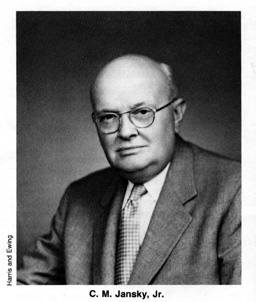
From an after-dinner address by C. M. Jansky, Jr., at the 94th meeting of the American Astronomical Society, Columbus, Ohio, March 23, 1956.
The photographs with this article, not otherwise credited, are by courtesy of Mary Jansky Striffler, sister of Karl Jansky, and Marguerite Jansky Froscher, daughter of C. M. Jansky, Jr.
 Karl Guthe Jansky was born on October 22, 1905, in what was then the Territory of Oklahoma where his father, Cyril M. Jansky, was Dean of the College of Engineering at the University of Oklahoma at Norman. Dean Jansky, born in Wisconsin of Czech immigrants, had started teaching at the age of sixteen. He was a teacher throughout his active life, retiring as Professor of Electrical Engineering at the University of Wisconsin. Karl Jansky's mother, nee Nellie Moreau, was of French and English parentage.
Karl Guthe Jansky was born on October 22, 1905, in what was then the Territory of Oklahoma where his father, Cyril M. Jansky, was Dean of the College of Engineering at the University of Oklahoma at Norman. Dean Jansky, born in Wisconsin of Czech immigrants, had started teaching at the age of sixteen. He was a teacher throughout his active life, retiring as Professor of Electrical Engineering at the University of Wisconsin. Karl Jansky's mother, nee Nellie Moreau, was of French and English parentage.
Although already a graduate of Valpariso University, about 1902 father Jansky decided that he should have more education. Therefore, he resigned his position as Superintendent of Public Schools in a small Michigan town and entered the University of Michigan. Here he obtained both graduate and post graduate degrees in Physics and Electrical Engineering. By this time there were two children in the family—I, the oldest, and a second son.
While at the University of Michigan, father Jansky worked under and became a great admirer of Dr. Karl Guthe, a German-American physicist and a member of the faculty of the University of Michigan. In 1904 both Dr. Guthe and our father became members of the staff of the United States Bureau of Standards at Washington at the time this institution was founded. In 1905 the family moved from Washington, D.C. to Norman, Oklahoma. When a third son was born shortly after reaching Oklahoma he was named after Dr. Karl Guthe, the scientist and teacher whose guidance had meant so much to his father.
I have gone into some detail with respect to this family history to show that the perseverance with which Karl Guthe Jansky accumulated scientific data, and the objectivity and creative ingenuity he demonstrated in making the fundamental discovery upon which the Science of Radio Astronomy is based, were not accidental. His family life and background contributed much. Even his name, Karl Guthe, preserves that of a great physicist and outstanding teacher.
After three years in Oklahoma the family moved to Madison, Wisconsin, where father Jansky became a member of the faculty of the University of Wisconsin. Here Karl Jansky received his public school and his university education. He received his Bachelor of Science degree in Physics in 1927. He was graduated with honors having been elected to membership in Phi Beta Kappa, Phi Kappa Phi and Phi Sigma Phi. Nine years later he received the Master's degree in Physics from the same institution.
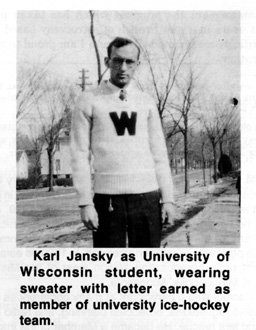 Karl Jansky was no bookworm. He was an excellent tennis player and an outstanding star on the University of Wisconsin's ice hockey team. Later, while with Bell Telephone Laboratories, he became the table tennis champion of Monmouth County, New Jersey.
Karl Jansky was no bookworm. He was an excellent tennis player and an outstanding star on the University of Wisconsin's ice hockey team. Later, while with Bell Telephone Laboratories, he became the table tennis champion of Monmouth County, New Jersey.
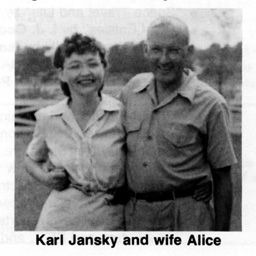 It is unrealistic and, therefore, unscientific to underestimate the impact of the element of chance on human destiny or as a factor affecting man's acquisition of knowledge concerning the universe in which he lives. This in no way detracts from the credit due those who take the fullest advantage of the opportunity chance affords. When Karl Jansky applied for a position with Bell Telephone Laboratories in 1928 he was at first turned down for physical reasons. It so happened that ten years previously I had been a member of the staff of the Bell System Laboratories and more recently, while a member of the faculty of the University of Minnesota, I had spent summers at the Laboratories. Therefore, by chance, I happened to be in a position to argue with members of the personnel department, with whom I was well acquainted, that Karl Jansky was a good risk. This may have had some small influence in the Laboratories' decision to hire him. Certainly, Bell Telephone Laboratories and the world of science never had reason to regret this decision.
It is unrealistic and, therefore, unscientific to underestimate the impact of the element of chance on human destiny or as a factor affecting man's acquisition of knowledge concerning the universe in which he lives. This in no way detracts from the credit due those who take the fullest advantage of the opportunity chance affords. When Karl Jansky applied for a position with Bell Telephone Laboratories in 1928 he was at first turned down for physical reasons. It so happened that ten years previously I had been a member of the staff of the Bell System Laboratories and more recently, while a member of the faculty of the University of Minnesota, I had spent summers at the Laboratories. Therefore, by chance, I happened to be in a position to argue with members of the personnel department, with whom I was well acquainted, that Karl Jansky was a good risk. This may have had some small influence in the Laboratories' decision to hire him. Certainly, Bell Telephone Laboratories and the world of science never had reason to regret this decision.
Again the element of chance enters into the picture. This was the assignment of Karl Jansky to the Bell Laboratories' field station at Cliffwood, New Jersey, and the decision of his supervisors to assign to him a project involving studies of certain radio propagation phenomena.
All of these factors, such as basic elements of character, inherent abilities, family environment, scholastic environment, the course of study in college, the choice of a life work, the choice of an employer, the assignment to a specific project, had a vital influence upon what followed. The stage must be set before the play can begin.
Karl Jansky's work from 1928 to 1932, leading to the discovery which laid the foundation for the science of radio astronomy, contains many lessons for those of us in the fields of either pure or applied science, and particularly for students or young people who hope to become scientists.
Karl Jansky was given the task of studying certain factors affecting the operation of Bell System transoceanic radiotelephone circuits. It is important to note that this was an applied scientific project with a very practical objective, namely, improvement in transoceanic radiotelephone service.
I used to tell my students in radio engineering at the University of Minnesota that a radio circuit consists of three parts—(1) a radio transmission installation, (2) a radio receiving installation, and (3) a transmission medium which carries signals from the transmitter to the receiver. Man can and has throughout the years made remarkable progress in the development and improvement of radio transmitters and receivers and radio transmitting and receiving antenna systems. However, he can do nothing to modify the characteristics of the transmission medium. He must use this medium as nature gives it to
him. Nevertheless, he can by field study and scientific analysis of the results obtain valuable information on what the transmission medium does to his radio signal and the types of static and noise affecting his use of it.
In 1928, one year after receiving his bachelor's degree, Karl Janksy began his studies of the radio transmission medium and specifically of static and interference noises. While some of his work was done on long wavelengths of the order of 4000 meters, of particular concern to radio astronomy are his studies on 14.6 meters (20.5 megahertz). These required instrumentation and it is important to note that in the late 1920's and early 1930's adequate instrumentation for his project, and particularly for wavelengths as short as 14.6 meters, involved many new and unsolved problems.
Every scientific worker makes use of the results obtained by others who have gone before and of advice and help from co-workers. Karl Jansky had much help from the results of past research work and from other engineers in Bell Telephone Laboratories. This in no way detracts from the credit due him for his scientific discovery. Rather, it extends credit to those who by advice and counsel contributed to the final result.
 About March 1929, Karl Jansky began the design of a 14.6 meter rotatable, directional antenna system and the development of the associated receiving apparatus. Construction of the antenna was started in August 1929. At the same time he was still working on the study of static on long wavelengths. In 1930, the Laboratories' field station with which he was connected was moved from Cliffwood to Holmdel, New Jersey. Therefore, it was not until the fall of 1930 that the 14.6 meter rotatable antenna and its associated receiving and recording equipment were in good working order. Next came the long period of time devoted to the unimpressive, prosaic and laborious taking of data, that is, data on the characteristics and intensity of static received on 14.6 meters as a function of two variables—(a) time, and (b) direction.
About March 1929, Karl Jansky began the design of a 14.6 meter rotatable, directional antenna system and the development of the associated receiving apparatus. Construction of the antenna was started in August 1929. At the same time he was still working on the study of static on long wavelengths. In 1930, the Laboratories' field station with which he was connected was moved from Cliffwood to Holmdel, New Jersey. Therefore, it was not until the fall of 1930 that the 14.6 meter rotatable antenna and its associated receiving and recording equipment were in good working order. Next came the long period of time devoted to the unimpressive, prosaic and laborious taking of data, that is, data on the characteristics and intensity of static received on 14.6 meters as a function of two variables—(a) time, and (b) direction.
I wish to dwell for a moment on the subject of data taking. It is one thing to sit at a desk and on the basis of information
and data gathered by others hypothesize with respect to the laws of nature. It is another to design, develop and build apparatus and equipment and then to embark upon a long, tedious program of taking accurate, dependable data on what actually takes place. There are some who look upon data taking as beneath the dignity of true scientists preferring to leave this detailed work to assistants. I do not wish to disparage the value of theory and speculation as necessary elements in any scientific study but rather to emphasize that Karl Jansky's work demonstrates how essential is the accumulation of adequate, accurate data. This is as true with respect to studies of radio propagation phenomena as it is in astronomy.
A fair share of my life as a radio engineer has been devoted to the field study of the radio propagation medium. I subscribe to a philosophy of approach with respect to work in this field of science. If an objective scientist takes sufficient data and then without the prejudice of preconceived theories or hypotheses analyzes the results, somehow nature's laws will become almost self-evident. The scientist's problem is to recognize basic facts even though they are obscured by a wealth of extraneous material, and then to apply creative imagination in their interpretation. This Karl Jansky did.
"Karl Jansky's paper, "Electric Disturbances Apparently of Extraterrestrial Origin", is in effect a wedding ceremony. It weds the science of astronomy and the science of radio and electronic engineering, tying them together by inseparable bonds."
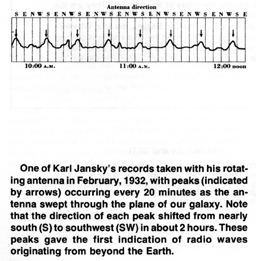 In a paper titled, "Directional Studies of Atmospherics at High Frequencies", presented at Washington, D.C. in April 1932 before the International Scientific Radio Union, Karl Jansky described his equipment and classified the types of static he was receiving on 14.6 meters into three distinct groups. The first group he described as static from local thunderstorms, and the second as static from thunderstorms some distance away. Then he stated, "the third group is composed of a very steady hiss static the origin of which is not yet known." While he speculated on the possible source of this new type of static, it is important to note his comment that "the data as yet only cover observations taken over a few months and more observations are necessary before any hard and fast deductions can be drawn."
In a paper titled, "Directional Studies of Atmospherics at High Frequencies", presented at Washington, D.C. in April 1932 before the International Scientific Radio Union, Karl Jansky described his equipment and classified the types of static he was receiving on 14.6 meters into three distinct groups. The first group he described as static from local thunderstorms, and the second as static from thunderstorms some distance away. Then he stated, "the third group is composed of a very steady hiss static the origin of which is not yet known." While he speculated on the possible source of this new type of static, it is important to note his comment that "the data as yet only cover observations taken over a few months and more observations are necessary before any hard and fast deductions can be drawn."
I am not concerned here with specific dates. They are all a matter of record. What is important is the long period of time devoted to the accumulation of data on static as received on 14.6 meters as a function of time and direction and the creative interpretation of this factual evidence. Before the Washington meeting of the International Scientific Radio Union held in April 1933, Karl Jansky presented his paper in which he stated his conclusion as to what the data showed. The title of this paper is, "Electrical Disturbances Apparently of Extraterrestrial Origin". Note the use of the word "apparently". This illustrates a modesty which I am sure astronomers, physicists and all true scientists both understand and appreciate.
In his paper Karl Jansky set forth with reasonable accuracy, considering the limitations of his antenna, the point of origin of the extraterrestrial hiss static he was receiving. I will quote from the paper:
"In conclusion, data have been presented which show the existence of electromagnetic waves in the earth's atmosphere which apparently come from a direction that is fixed in space. The data obtained give for the coordinates of this direction a right ascension of 18 hours and a declination of -10 degrees.
"The experiments which are the subject of this paper were performed at Holmdel, N.J. (Latitude 40°22'N and Longitude 74°10'W)
during the year 1932."
Now, I am an electronic engineer and not an astronomer. My comments must be taken with this limitation in mind. I look upon Karl Jansky's paper, "Electric Disturbances Apparently of Extraterrestrial Origin", as a classic. It is in effect a wedding ceremony. It weds the science of astronomy and the science of radio and electronic engineering. It ties these sciences together by inseparable bonds.
My collegiate studies were in a field of pure science, namely, physics. Then I became a teacher of an applied science, namely, radio and electrical engineering. In my teaching days when I was perhaps more willing to generalize than now, I used to define a pure scientist as one who if he saw a practical application of what he was doing somehow felt contaminated by commercialism and an applied scientist as one who if he could not see a practical application of his work would lose interest. Is it not true that there exists no definitive boundary between pure and applied science? The discovery of extraterrestrial noise came as a result of a research program originally directed to a very practical end.
Naturally, I had at least a limited appreciation of what was going on in Karl Jansky's mind in the early 1930's when he was gathering large amounts of data and also trying to figure what the data meant. I remember well when he started the study of the basic principles of astronomy, a field of science in which he had had no previous training. He felt this necessary if he were to interpret the mass of factual information he was collecting. I find his description of astronomical coordinates as lucid as anything on the subject I have read elsewhere. Very probably this is because my training and experience had been in the same field of science as was his, namely, physics and electronic engineering.
I recall among other things that after Karl Jansky concluded that his hiss static came from the center ofthe Milky Way he went back and tried correlating the data he had taken some time previously. At first it looked as though in some instances no correlation existed. Then suddenly he realized that some of these early data had been recorded using daylight saving time. When he applied the correction, he found these previous data tended to still further support his discovery.
Karl Guthe Jansky died in Red Bank, New Jersey, in February 1950 at the age of forty-four. In the trying period that followed his death I told the members of his family that his contribution to basic science was such that the full value of his discovery would not be recognized for at least half a century. How wrong can a man be! Here just six years later I find myself before a group of astronomers, physicists and radio engineers far more competent than I, viewing with amazement the progress which has taken place in recent years in a new branch of astronomy based upon a scientific discovery made by a man I am proud to say was my brother.
|
The jansky
|
|
The unit used by radio astronomers for the strength (or flux density) of radio sources is the jansky (symbolic form, Jy). The
jansky is equal to one-hundredth of one trillionth of a trillionth of a watt per square meter per hertz. In scientific symbolic notation this is expressed
1 Jy = 10-16 W m-2 Hz-1
Note that in accordance with the SI (System International) notation, the unit jansky is not capitalized when written out but
it is capitalized in its symbol form (Jy). This convention is followed whenever a unit is named after a person. Thus, we have the watt (symbol W), the hertz (symbol Hz), both named after persons, but the meter (symbol m) because the meter is not named after a person. Typical strong radio sources have strengths of 10 to 100 janskys (10 Jy to 100 Jy) while weaker ones are measured in thousandths of a jansky or millijanskys (symbol mJy).
|

 C. M. Jansky, Jr. (1895-1975) was born in Barry County, Michigan. After receiving the B.S. and M.S. degrees in physics from the University of Wisconsin in 1917 and 1919, respectively, he taught radio communications and electronics at the University of Minnesota from 1920 to 1929, becoming associate professor of radio engineering. In 1920 he established the first radio broadcasting station west of the Mississippi River at Minneapolis, Minnesota.
C. M. Jansky, Jr. (1895-1975) was born in Barry County, Michigan. After receiving the B.S. and M.S. degrees in physics from the University of Wisconsin in 1917 and 1919, respectively, he taught radio communications and electronics at the University of Minnesota from 1920 to 1929, becoming associate professor of radio engineering. In 1920 he established the first radio broadcasting station west of the Mississippi River at Minneapolis, Minnesota.
Mr. Jansky was a participant at many conferences dealing with radio regulations, broadcast planning, and radio navigation and sea rescue. He became a Member of the Institute of Radio Engineers (now Institute of Electrical and Electronic Engineers) in 1918, being made a Fellow Member in 1928. He was President of the Institute in 1934 and a member of its Board of Directors from 1929 to 1942. He was senior partner of the firm of Jansky and Bailey, consulting radio engineers, of Washington, D.C.
|
What It Was Like Before Ozma
By: Louis Berman
[Article in magazine started on page 17]
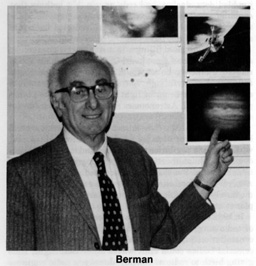 The search for extraterrestrials has quite a history prior to the advent of Project Ozma in 1960. Long ago, the idea of communicating with inhabitants of other worlds was regarded as fantasy, forever unattainable. But as telescopes grew in size and knowledge of the heavens increased, and as our technology improved, the time at last seemed opportune to consider seriously the problem of extraterrestrial communication. A century or more ago, in the absence of adequate techniques, attempts to communicate with extraterrestrial beings were confined to modest goals within the solar system and Mars was selected as the most appropriate candidate.
The search for extraterrestrials has quite a history prior to the advent of Project Ozma in 1960. Long ago, the idea of communicating with inhabitants of other worlds was regarded as fantasy, forever unattainable. But as telescopes grew in size and knowledge of the heavens increased, and as our technology improved, the time at last seemed opportune to consider seriously the problem of extraterrestrial communication. A century or more ago, in the absence of adequate techniques, attempts to communicate with extraterrestrial beings were confined to modest goals within the solar system and Mars was selected as the most appropriate candidate.
Let us first ask: How did humans acquire their speech-making ability and the knack of making artifacts that have made long-distance communication possible? When early man began to walk upright, it is believed that the vertical position of his head on top of his neck gradually caused the air passages in the throat to change so that he could form words rather than sounds. This would not have been possible in a four-legged creature whose head hangs in a horizontal position.
When humans learned to manipulate their hands for tool-making and other purposes, the part of the brain that controls hands grew stronger and larger. Now it happens that this part of the brain lies next to the part that controls speech. As man's manipulative dexterity grew he developed a larynx and vocal organs that aided in the production of speech. An explanation of why apes can't talk is that they haven't used their hands in the variety of ways humans do, and this could be one of the reasons their brain capacity does not match ours.
With the ability to communicate, man in time learned how to pass information on to others separated at some distance from him. There are a number of older ways by which messages can be relayed from one place to another:
Smoke signals
Beating of drums
Sounds from bugles and firearms
Yodeling
Wigwagging
Carrier pigeons
Semaphores
Heliograph by day
Light and fires by night
Flash lamps using Morse code
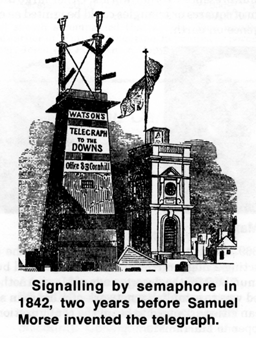 Some of these are still in use.
Some of these are still in use.
In the nineteenth century interest in extraterrestrial communication took a quantum jump. In their book* (*"Intelligence in the Universe" Prentice-Hall, 1966) MacGowan and Ordway recall some of the schemes proposed for alerting other worlds to the existence of life on the earth. Three examples are as follows:
Around 1820 Karl Gauss, the celebrated German mathematical astronomer, proposed planting parallel wide strips of pine forest in Siberia to enclose a huge right-angled triangle with wheat growing inside as contrast to the green of the trees in summer while in winter snow inside would stand out from the trees.
In 1840 Joseph von Littrow, Director of the Vienna Observatory, suggested digging a circular ditch 30 kilometers in diameter in the Sahara desert. After filling the ditch with water, kerosene would be poured on top and lit to signal our presence to other worlds. Other large ditches in the form of squares or triangles could be ignited as a sign of intelligence on earth.
In 1869 Charles Cros of France conceived the idea of constructing a huge mirror to focus sunlight and burn out simple numbers on the desert sands of Mars. Another plan proposed was to establish a network of mirrors in selected European cities arranged to beam the configuration of the Big Dipper to Martians.
While the Europeans were hatching geometrical and mechanical schemes to alert other worlds of our presence, other developments were taking place that were to have a profound effect on the progress of long-distance communication. First came the invention of wire telegraphy by Samuel F. B. Morse who transmitted a message in 1844 from Washington to Baltimore before an assembled U.S. Congress. Next came the revelation by Heinrich Hertz in 1888 that electric waves could be propagated in space without wires, as predicted by Maxwell's theory of electromagnetic radiation fifteen years earlier, and in 1901, Guglielmo Marconi succeeded in transmitting a signal by wireless telegraphy across the Atlantic from Cornwall, England, to Newfoundland.
It was natural to inquire whether the sun might be capable of emitting electromagnetic energy in the form of radio waves. Arthur E. Kennelly, whose name is associated with the Kennelly-Heaviside ionospheric layer, wrote a letter in 1890 to Director Holden of the Lick Observatory suggesting that waves longer than light waves might be coming from the sun but nothing was done. However, both Thomas Edison and Sir Oliver Lodge carried out experiments to detect radio waves from the sun without success.
One experimenter whose bold imagination carried him farther than the rest was Nikola Tesla, the eccentric electrical pioneer. He set up equipment in his laboratory near Pikes Peak, Colorado in 1899 to "talk to the planets" as he expressed it. His apparatus consisted of a large primary coil 23 meters in diameter and a 1 meter copper ball mounted on top of a 60 meter mast. He sent powerful alternating surges of electricity into the copper ball and into the ground, believing that the magnetic field of the Earth would increase the power of the signal. Although incandescent lights were set glowing 40 kilometers away, he was unable to detect any extraterrestrial response. Somewhat later, he claimed to have picked up interplanetary signals directed by intelligent control.
In 1921 Marconi reported that he had detected pulsed long-wavelength extraterrestrial signals while aboard his experimental communications yacht, Elettra (named after his wife).
Davis Todd, Professor of Astronomy at Amherst College, proposed operating a radio set from a dirigible 3000 meters above the ground for communicating with Martians in the belief they were capable of tuning in on our broadcast stations. In August 1924 when Mars was closest to the earth at 60 million kilometers Todd arranged to have the U.S. Government turn off its high-powered transmitters for five minutes before each hour between August 21 and August 23. During these silent periods he used a receiver tuned to a wavelength between 5 and 6 kilometers to record on tape any signals coming through. All he and listeners throughout the country could pick up was a potpourri of jumbled dots, dashes, and code groups, but nothing that could be ascribed to an extraterrestrial source. We know today that such very long waves are reflected back into space and could not have penetrated to the ground.
Todd also proposed filling a 15 meter bowl with mercury at the bottom of an abandoned Chilean mine shaft. When rotated the heavy liquid would form a natural parabolic reflector. A powerful light source placed at its focus would send an intense beam of light to Mars when the planet passed overhead. Astronomers ridiculed it as a hare-brain scheme.
If hypothetical Martians launched probes in orbit around Earth at the same distance as our weather satellites, and with the same resolution, they would find it hard to obtain evidence of human artifacts from photographs, at least in the short run. But if the probes carried short wave radio receivers, the presence of life on the earth would be immediately detectable because our earth is a very noisy planet at radio wavelengths.
 In 1932 came the serendipitous discovery by Karl Jansky of radio waves from the center of the Milky Way in the constellation Sagittarius. Here was the first evidence that celestial bodies could emit waves other than light, thus giving birth to radio astronomy. Jansky, a radio engineer at the Bell Telephone Laboratories in New Jersey, had been assigned the task of identifying the static noises plaguing trans-Atlantic radio telephone communications. He constructed a 30 meter antenna system tuned to 14.5 meters. It was mounted on a rotatable wooden frame which rolled on four wheels running on a circular track (see photo to the right; from inside back cover). He employed a very sensitive receiver coupled to a continuous recorder. In addition to registering the crackling noises arising from local and distant thunderstorms, he later succeeded in singling out a weak static noise that was hardly distinguishable from the receiver's internal noise. In headphones he could hear a faint hissing whenever the antenna pointed toward the direction of Sagittarius in the sky.
In 1932 came the serendipitous discovery by Karl Jansky of radio waves from the center of the Milky Way in the constellation Sagittarius. Here was the first evidence that celestial bodies could emit waves other than light, thus giving birth to radio astronomy. Jansky, a radio engineer at the Bell Telephone Laboratories in New Jersey, had been assigned the task of identifying the static noises plaguing trans-Atlantic radio telephone communications. He constructed a 30 meter antenna system tuned to 14.5 meters. It was mounted on a rotatable wooden frame which rolled on four wheels running on a circular track (see photo to the right; from inside back cover). He employed a very sensitive receiver coupled to a continuous recorder. In addition to registering the crackling noises arising from local and distant thunderstorms, he later succeeded in singling out a weak static noise that was hardly distinguishable from the receiver's internal noise. In headphones he could hear a faint hissing whenever the antenna pointed toward the direction of Sagittarius in the sky.
In 1933 Jansky published his results in the Proceedings of the Institute of Radio Engineers but they received little attention. Another paper published in Popular Astronomy attracted scant attention by astronomers who were too preoccupied with optical astronomy and who knew little or nothing about radio techniques. When Jansky died at the age of 44 in 1950, his obituary in the magazine Science consisted of a very short paragraph without any mention of the potentialities of his discovery.
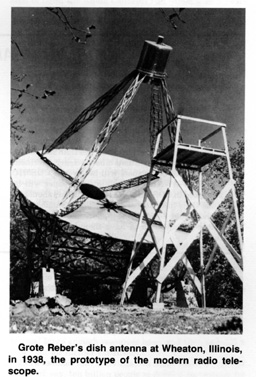 It remained for the radio engineer, Grote Reber, to carry on where Jansky had left off. In 1937 Reber constructed the first large parabolic radio dish, 10 meters in diameter, in his back yard at Wheaton, Illinois. This radio telescope operated at a wavelength of about 2 meters and could distinguish more detail than Jansky's antenna. After several years of observing Reber was able to put together a map of the radio sky (see below right) which revealed the presence of several discrete radio sources as well as the diffuse radio emission coming from the direction of the center of the Milky Way, previously discovered by Jansky. His results, published in 1940 in the Proceedings of the Institute of Radio Engineers and in the Astrophysical Journal, attracted the attention of a few astronomers but World War II intervened and many astronomers became involved in the war effort.
It remained for the radio engineer, Grote Reber, to carry on where Jansky had left off. In 1937 Reber constructed the first large parabolic radio dish, 10 meters in diameter, in his back yard at Wheaton, Illinois. This radio telescope operated at a wavelength of about 2 meters and could distinguish more detail than Jansky's antenna. After several years of observing Reber was able to put together a map of the radio sky (see below right) which revealed the presence of several discrete radio sources as well as the diffuse radio emission coming from the direction of the center of the Milky Way, previously discovered by Jansky. His results, published in 1940 in the Proceedings of the Institute of Radio Engineers and in the Astrophysical Journal, attracted the attention of a few astronomers but World War II intervened and many astronomers became involved in the war effort.
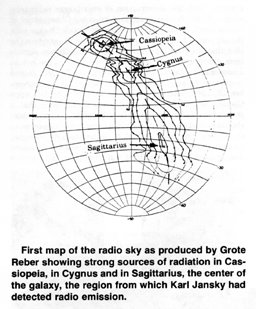 However, some serendipitous radio astronomy observations occurred during the war. Late in February 1942 the 5 meter wavelength British early-warning radar system overlooking the English channel suddenly became inoperative because of a very strong noise-type signal. Enemy jamming was suspected but further investigation by British radio physicist J. S. Hey identified the sun, then undergoing a flare outburst, as the source of the noise. Later a radar installation used to detect incoming V-2s picked up radio noises from various celestial sources. This information was kept confidential until after the war. When the war ended in 1945, radio engineers, physicists and astronomers rapidly expanded the field of radio astronomy with the construction of ever larger radio telescopes. At the National Radio Astronomy Observatory in Green Bank, West Virginia, scientist Frank Drake, with the support of Director Otto Struve, began to entertain the idea that the time was ripe to look for intelligent signals from outer space although many scientists were not so disposed and some were scathingly critical. The idea gained respectability with the historic publication in the September 19, 1959, issue of Nature of an article by Giuseppe Cocconi and Philip Morrison who recommended that a search for intelligent signals from beyond the solar system should be instituted with existing large radio telescopes in the microwave region around 21 centimeters wavelength. At that time the largest radio telescope was the 76 meter dish at Jodrell Bank, England, but its director, Sir Bernard Lovell, expressed no enthusiasm in using it to search for extrasolar intelligence. He later changed his mind about the Cocconi-Morrison suggestion, but the telescope was never used in that capacity. This is where COSMIC SEARCH comes in and takes over the story in its first issue of January 1979.
However, some serendipitous radio astronomy observations occurred during the war. Late in February 1942 the 5 meter wavelength British early-warning radar system overlooking the English channel suddenly became inoperative because of a very strong noise-type signal. Enemy jamming was suspected but further investigation by British radio physicist J. S. Hey identified the sun, then undergoing a flare outburst, as the source of the noise. Later a radar installation used to detect incoming V-2s picked up radio noises from various celestial sources. This information was kept confidential until after the war. When the war ended in 1945, radio engineers, physicists and astronomers rapidly expanded the field of radio astronomy with the construction of ever larger radio telescopes. At the National Radio Astronomy Observatory in Green Bank, West Virginia, scientist Frank Drake, with the support of Director Otto Struve, began to entertain the idea that the time was ripe to look for intelligent signals from outer space although many scientists were not so disposed and some were scathingly critical. The idea gained respectability with the historic publication in the September 19, 1959, issue of Nature of an article by Giuseppe Cocconi and Philip Morrison who recommended that a search for intelligent signals from beyond the solar system should be instituted with existing large radio telescopes in the microwave region around 21 centimeters wavelength. At that time the largest radio telescope was the 76 meter dish at Jodrell Bank, England, but its director, Sir Bernard Lovell, expressed no enthusiasm in using it to search for extrasolar intelligence. He later changed his mind about the Cocconi-Morrison suggestion, but the telescope was never used in that capacity. This is where COSMIC SEARCH comes in and takes over the story in its first issue of January 1979.

 Louis Berman is adjunct professor of astronomy at the University of San Francisco. He has taught courses in mathematics, physics and astronomy at the City College of San Francisco and the history of rocketry at the State University of San Francisco. Born in 1903 in London, England, he received his bachelor's and master's degrees at the University of Minnesota (1925, 1927) and his doctorate as a Lick Observatory Fellow from the University of California at Berkeley (1929).
Louis Berman is adjunct professor of astronomy at the University of San Francisco. He has taught courses in mathematics, physics and astronomy at the City College of San Francisco and the history of rocketry at the State University of San Francisco. Born in 1903 in London, England, he received his bachelor's and master's degrees at the University of Minnesota (1925, 1927) and his doctorate as a Lick Observatory Fellow from the University of California at Berkeley (1929).
The second edition of Dr. Berman's textbook, "Exploring the Cosmos", with co-author John C. Evans, has been used as the background text for a 39-part TV series on introductory astronomy entitled: "Project: Universe", produced for the Public
Broadcasting Service by the California Consortium of Community Colleges. Like many other SETI people, Berman is also a licensed radio amateur.
|
A Hymn to Life in the Universe
By: Don Lago
[Article in magazine started on page 21]
In the heart of the desert, where sand and rock and bare dirt might seem to be all that Earth can aspire to become, there yet stands a small tower of life. Its firm stalk rises out of the broken ground, supporting a structure of living cells whose intricate order contrasts sharply with the crudeness of the desert around it. Among the stones whose rugged shapes contain—as though they were the planet's memory—the imprint of a billion years, the plant's cleanness of form makes it seem an alien presence.
Strange things are happening here, things the desert could never understand. The leaves receive the same light that bakes the scattered stones, but instead of throwing its heat away each night the plant keeps the sun for itself. Rain pounds the indifferent dirt and seeps away, but roots grasp for all the water they can hold. Wind easily swirls clouds of sand from the desert floor, but the leaves remain bound to the plant and only flap in the wind-the green flags of the nation of life.
Though the plant might not seem to belong here, the desert was yet the womb from which it was born. Life was as much an expression of the desert as was sand or stone. If life defies chaos, it is yet created from it. This is the paradox of all life, not only in the desert, but in the whole universe as well, for what was the universe but a wilderness whose forces surged back and forth with a massive crudeness, tossing stars around as if they were grains of sand upon the wind, recklessly grinding out planets, and everywhere pouring energy into a void that will only swallow it forever. Yet from out of this barbaric prodigality arise worlds on which infinitely delicate forms will grow.
The plant in the desert was not as alone as it might seem, for nearly the whole planet from which it grew was covered with life; the desert was a small remnant of wilderness that life had been unable to fill. Yet though the planet was swarming with life it was still as small and fragile amid the raw intensity of the stars as the plant was amid its own desert of sand and stone.
The plant holds out its leaves to meet the streaming sunlight, absorbing into its millions of cellular sponges an infinitesimal amount of the massive energy the sun disgorges into space. The leaves open their doors to the swarming photons, yet in filling itself with the chaos of the universe the plant does not become chaos, but through the strange alchemy of life transforms it into order. The plant turns the light into itself, funneling it into the swirling patterns of the cells, where all the molecules and organelles of life float upon the strength of its flow, moving in their intricate currents and crosscurrents as long as the river of light flows through them. The plant was a handful of Earth dancing about on a whirlwind of captured light, moving in patterns that captured more light and kept the dance intact.
Life absorbed and transmuted chaos from the land as well as from the sky. The plant contains the desert, though you wouldn't recognize the desert within the plant. It had merged with the flow of life and begun working with an artistry it had never known before.
"If life defies chaos, it is yet created from it. This is the paradox of all life."
The plant was compacted from the molecules scattered across the ground and flying loose in the wind, formless and wild, moving with that massive ocean ofdesert sands whose waves required a thousand years to swell and crest and disappear. From out of this slowly undulating land, moving with its ponderous and ancient pulse, a swifter metabolism arose and drew the formless desert into itself, setting it flowing in graceful and elaborate forms, letting matter that had once been stone dance among the rocks, like a beautiful song coming from the otherwise rough and inarticulate desert.
The plant has also drawn the desert's water into life. For millions of years thunderstorms savagely battered the ground, carving into the rock until gullies and canyons swirled across the desert floor. The frost of a million winters penetrated the rocks and cracked and shattered them, leaving the stones with twisted faces or standing in precarious arches. Yet the water that inflicted this crude surgery on the land now joined the most delicate structure on the planet, a form that grew and changed shape from within, directed by its own inner craftsmanship.
 Wind too had yielded its fury to the needs of life. The air had roamed wildly over the land, madly stirring the dust and scattering the clouds, yet now some of its molecules left that world for one that contained its own landscape of winds, a self-contained whirlwind that sucked in matter and twirled it into greater and greater order, up the winding staircase of DNA, up the interwoven patterns of cells, up to the superstructure of leaves and roots. The molecules that could only riot across the land began a fine weaving and interweaving with other molecules that had come out of the same chaos, together producing the matchless fabric of life.
Wind too had yielded its fury to the needs of life. The air had roamed wildly over the land, madly stirring the dust and scattering the clouds, yet now some of its molecules left that world for one that contained its own landscape of winds, a self-contained whirlwind that sucked in matter and twirled it into greater and greater order, up the winding staircase of DNA, up the interwoven patterns of cells, up to the superstructure of leaves and roots. The molecules that could only riot across the land began a fine weaving and interweaving with other molecules that had come out of the same chaos, together producing the matchless fabric of life.
This is the power and the paradox of life, to arise from chaos and contain chaos without becoming chaos, to draw the rest of the world into its dance, converting a small patch of the wilderness of the universe into a skilled and majestic flow. This power lay hidden within matter for billions of years as stars formed their furious circles, yet in an isolated spot the storm calmed and allowed life to arise, containing the chaos that had contained it for billions of years, taming the storm that would not let it free, taking the raw energies of the universe and making from them something beautiful and alive, turning the electricity surging in every atom into consciousness, and the air flying wild above the naked earth into song.
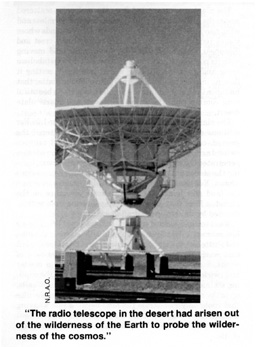 In the distance beyond the desert plant stood another structure whose form revealed it to be a work of life. It too was a leaf, pointing towards the sky to absorb the energies of the stars. Yet this leaf was vastly larger than those of the plant, and was composed not of the whirling molecules of cells, but of firm steel. The plant captured energy in chloroplasts, while the metal leaf used a more massive form of electronics. The plant only wanted to fill itself with the sun, but the larger leaf wanted to absorb the energies of the farthest galaxies, many of them so old that they had died a billion years before, leaving only their electromagnetic ghosts to haunt the universe.
In the distance beyond the desert plant stood another structure whose form revealed it to be a work of life. It too was a leaf, pointing towards the sky to absorb the energies of the stars. Yet this leaf was vastly larger than those of the plant, and was composed not of the whirling molecules of cells, but of firm steel. The plant captured energy in chloroplasts, while the metal leaf used a more massive form of electronics. The plant only wanted to fill itself with the sun, but the larger leaf wanted to absorb the energies of the farthest galaxies, many of them so old that they had died a billion years before, leaving only their electromagnetic ghosts to haunt the universe.
The leaves made of cells and the leaf of metal tapped the same wilderness of energy, yet for different purposes. The plant wanted the energy for itself, while the metal was only meant to funnel it onward into something else. The leaves fed the plant's hunger to maintain its form and grow, but the metal fed a kind of hunger the plant could never feel within itself, a hunger not of body but of mind, not the elemental drive of plants to fill out their structure and rise into the potential form contained within their seed, but the conscious need of a mind to fill its own empty spaces. Both plant and mind sought to fill themselves with the universe, yet one wanted to subdue the light while the other wished to be illuminated by it. Plants sought the light to power the dance within their cells, but the energy falling into the human brain set off activity far out of proportion to its faint quanta, for man sought it not to add kinetic fire to his cells, but to energize his mind with a far different kind of power. For man the energy contained a new dimension, one that plants could not perceive, but one as necessary to build the order of the human mind as light was to feed the expanding architecture of plants. Man sought to catch the rain of cosmic energy for what it revealed of the universe, to feed his hunger for understanding.
This hunger was born out of the same primeval dance occurring in every cell of the plant, and though the human mind had vastly transcended the simple weaving together of molecules, it still carried on life's work of making order out of the chaos around it. Man emerged into a world swarming with bewildering events and tried to find patterns in them. He watched the rising moon and noticed how it matched the rising tides; he watched the changing seasons and noticed how they matched the changing sky. He
held a fossil in his hand and glimpsed the history of his planet. He watched the animals around him and saw that they shared many of the same emotions he felt within himself. He studied a falling object and guessed the nature of the force guiding the planets in their flight. He saw a seed become a tree and a baby become an adult, marveled at the force at work within wood and flesh, and looked into the blackness of the universe and wondered if this force was also at work among the stars.
To help him order the world in his mind man has had to order the world with his hands, lifting tons of metal out of the ground where it lay for millions of years and shaping it into sensitive machines. The radio telescope in the desert had arisen out of the wilderness of Earth to probe the wilderness of the cosmos.
From the desert of his own planet man studies the desert of space, absorbing into his giant leaf the raw energies wafting through the cosmos. He sees the turmoil in every star and the massive violence in every galaxy. He witnesses the birth pangs and the death throes of stars, the fertile clouds of condensing gas from which stars are born and the novas that mark their passing. He listens to the heartbeats of pulsars and plots the wild dance of binary stars. He sees the universe in all its contrasts, from the savage profusion of quasars to the unquenchable hunger of black holes, from the swarming crowds of stars in the center of galaxies to the empty void between them. He watches the massive storms raging all across the universe and feels the winds of radiation pouring from them into space.
And yet, from out of this chaos man still hoped to detect an energy whose pulse could not be born in any star. At night humans would look upon the universe and feel sure that it was there, somewhere in the darkness and racing towards them, blindly searching out the stars, passing unheard over planets of naked desert and planets of ice, passing comets that couldn't recognize its meaning, sweeping through the sea of futile energy disgorged by the stars, mingling with the energies of a billion stars yet not being lost, spreading across the galaxy like ripples in a lake, like the first light of a brave new star.
Someday this wave would find Earth and man. It would ring in his radio telescopes with an order so clear and delicate that man could be sure it had arisen not from the heart of any star, not from the wild blasts of novae or pulsars, not from the fury of quasars or black holes, but from the same force throbbing in his own cells and every cell on Earth, the only force in the universe able to create such order.
Then man would know beyond any doubt that somewhere else in the universe the dance of life had started and triumphed, drawing the chaos around it into its flow and giving it form, crafting energy out of its rawness until it glowed with wisdom and called across the void between the stars for someone to share its wonder.

A biographical sketch of Don Lago appeared in the March 1979 (vol. 1, no. 2) issue of COSMIC SEARCH in connection with his article, "Circles of Stone and Circles of Steel", which was the first winner of a COSMIC SEARCH AWARD.
|
CETI FOCUS OF SPECIAL ISSUE
By: Editors
[Article in magazine is located on page 24]
A special CETI issue of Acta Astronautica has just been issued. The International Academy of Astronautics is the professional organization behind the journal, Acta Astronautica, and special CETI Sessions have been held at their Annual Meetings of the Internationational Astronautical Federation since 1972. The special CETI issue contains papers from the most recent meetings, and given below for the information of COSMIC SEARCH readers, and through the courtesy of the editors of the Acta Astronautica special issue, is the Foreword prepared by John Billingham and Rudolf Pešek.
John Billingham and Rudolf Pešek
This Special Issue of Acta Astronautica is devoted to the subject of Communication with Extraterrestrial Intelligence (CETI).* (*The term CETI has been used for many years as a generic title for all aspects of Communication with Extraterrestrial Intelligence. The term SETI was introduced in the United States in 1976 to reflect the widely held view that the primary endeavor should be a Search for Extraterrestrial Intelligence.)
The appearance of this volume is a reflection of a steadily growing interest in the possibility that intelligent species may be widely distributed in the Universe. This hypothesis is based on major advances over the past twenty to thirty years in the sciences of astrophysics, astronomy, planetary formation, exobiology and biological evolution. To make a long story short, it is now believed that planets are the rule rather than the exception, that life will arise in suitable planetary environments, and that in many cases life will evolve to the stage of intelligence, given several billion years of comparative stability of the planetary environment.
The crucial question is immediately apparent. Is there any way in which we can establish communication with other civilizations? The probability of the existence of a second intelligent species in our own solar system is vanishingly small. Hence we are driven to examine possibilities for interstellar communication. It transpires that advances in communication theory and technology over the last decade or two do indeed offer some reasonable approaches to the formidable problems involved.
Thus the development of a scientific basis for the evolution of intelligence is proceeding in parallel with the emergence of technologies which allow our first attempts at interstellar communication. In both areas the challenge has been seized by a small but growing number of investigators of widely differing disciplinary backgrounds. The papers in this volume are the results of a rich variety of approaches to the challenge.
CETI was introduced to the International Academy of Astronautics by Rudolf Pešek of Czechoslovakia in 1966. The First International Review Session on CETI took place in 1972 as a part of the XXIIIrd Annual Meeting of the International Astronautical Federation. In subsequent years the CETI Review Session has been a regular feature of the program. In 1977 the Program Committee approved the introduction of a second CETI Review Session in response to increasing interest in the subject.
This volume contains most of the papers presented at these Review Sessions in 1975, 1976 and 1977. It contains also a paper on a design concept for a large space radiotelescope, by V. I. Buyakas and several other Soviet authors from the Space Research Institute, USSR Academy of Sciences, which was presented in another session at the 1977 IAF meeting. We have introduced one further paper. It is the first part of a recent publication entitled "The Search for Extraterrestrial Intelligence: SETI"
prepared for the NASA Ames Research Center by a team of U.S. Scientists under the chairmanship of Philip Morrison. We feel it is of interest because it represents an up-to-date condensation of many of the fundamental questions and conclusions about SETI at this time.
On the whole, the papers in this volume deal with concepts and studies related to the science, technology, and observational techniques of CETI. Indeed, they include prominent papers by Soviet authors dealing with searches that have actually been carried out. One of the papers, by Pešek, is a summary of major CETI activities in science technology and other areas during the years 1966 through 1976. Finally, we have included one or two papers dealing with some very advanced concepts of communication.
We consider it an honor to have been involved in the publication of this Special Issue of Acta Astronautica. We hope that this volume will serve as a useful store of knowledge about some of the CETI activities in recent years. And we trust it will stimulate debate on the complex and important issues involved for years to come.
The CETI issue is published in two parts in journal form, and is available in book form. Ordering information is:
Special CETI (Communication with Extraterrestrial Intelligence) issue of Acta Astronautica
Book #ISBN 024727XH
Cost: $35.00
Order from:
Pergamon Press
Maxwell House
Fairview Park
Elmsford, NY 10523
Pergamon Press
Headington Hill Hall
Oxford OX3 OBW
ENGLAND
|
ABCs of Space
By: John Kraus
[Article in magazine started on page 25]
A. The Doppler Effect (Wavelengths are relative. The Red Shift)
When a rapidly moving vehicle passes with its horn sounding, there is an abrupt decrease in the pitch of the horn. This is the Doppler effect, first described by Christian Johann Doppler of Vienna in 1842.
A decrease in pitch (or frequency) corresponds to an increase in wavelength. Thus, a receding object has a longer wavelength (or lower frequency) than when it is approaching. The effect can be observed for sound waves, water waves and electromagnetic waves (light and radio waves).
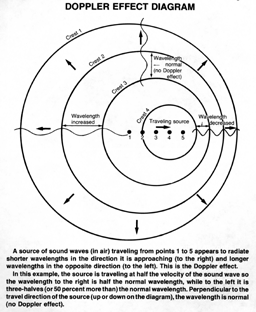 Referring to the Doppler Effect Diagram, suppose a source of waves is moving to the right. When it was at position 1, it sent out the crest of a wave, by the time the source reached position 2 it sent out another crest and so on. By the time it reached position 5, the previously emitted crests had expanded to the circles shown. The wavelength (or crest to crest) distance is less in the direction toward which the source is traveling (to the right) and greater in the direction from which it is receding (left). This is the Doppler effect. Perpendicular to the direction the source is traveling, the wavelength is normal (no Doppler effect). Suppose that the source is sending out a sound wave in air at middle-C. Then an observer to the right hears high-C (wavelength halved), while an observer to the left hears F-below-middle-C (wavelength 50 percent longer).
Referring to the Doppler Effect Diagram, suppose a source of waves is moving to the right. When it was at position 1, it sent out the crest of a wave, by the time the source reached position 2 it sent out another crest and so on. By the time it reached position 5, the previously emitted crests had expanded to the circles shown. The wavelength (or crest to crest) distance is less in the direction toward which the source is traveling (to the right) and greater in the direction from which it is receding (left). This is the Doppler effect. Perpendicular to the direction the source is traveling, the wavelength is normal (no Doppler effect). Suppose that the source is sending out a sound wave in air at middle-C. Then an observer to the right hears high-C (wavelength halved), while an observer to the left hears F-below-middle-C (wavelength 50 percent longer).
As explained in ABCs for the Summer 1979 issue, chemical elements have characteristic spectral lines at specific optical wavelengths so that an astronomer can tell what elements are present in a star. However, if the star is receding (or approaching) these lines will be shifted to longer (or shorter) wavelengths by the Doppler effect.
If the star is rotating, a line is broadened from its normal condition because ome of the light comes from parts of the star which are moving away and some from parts which are approaching. From the amount of the broadening, conclusions may be drawn about the star's rotation.
About 1930, Edwin Hubble of the Mount Wilson Observatory deduced from spectra of distant galaxies that their light was Doppler shifted to longer or redder wavelengths by an amount which increased with the distance of the galaxy. This red shift of the light from the galaxies indicated that they were rushing away from us at velocities which increased with their distance. This led to the idea of an expanding universe and by an extrapolation backwards in time to its origin from an initial explosion or "big bang" from which it has been expanding ever since.
Summary:
- The Doppler effect is useful for determining the velocity of approach or recession of moving objects.
- Wavelengths are stretched out or longer when a wave-producing object is receding.
- Wavelengths are compressed or shorter when a wave-producing object is approaching.
- The wavelength of light from distant galaxies is increased making it redder. This red shift of the light indicates that the galaxies are receding.
B. The Big Bang Background (3 degrees)
As discussed in the previous section on the Doppler effect, the discovery that the universe was expanding led to the idea that in the distant past the entire universe was in a super compact (high density) state and that its expansion began abruptly with an enormous explosion popularly called the "big bang".
In the 1930s and 40s George Gamow and others outlined a history of the universe: Beginning with the big bang, a fireball of intense radiation blasted outward at the speed of light. Initially this primordial fireball had a temperature of billions of degrees. As it expanded it cooled down. Refinements of Gamow's original idea have led to present theories that put the temperature of the primordial fireball at the time of the explosion (time zero) at a trillion degrees or more. Cooling was rapid at first, decreasing billions of degrees in a matter of seconds. With passage of time, cooling became more gradual. After about 15 billion years (or now), it has reached a value of about 3 degrees celsius above absolute zero as determined by Arno Penzias and Robert Wilson of the Bell Telephone Laboratories in 1965 (see COSMIC SEARCH for March 1979, Vol. 1, No. 2, page 32).
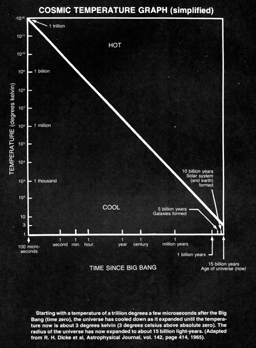 The change in the temperature of the universe with time is shown in the accompanying Cosmic Temperature Graph. The present age of the universe is taken as 15 billion years, with galaxies forming 5 billion years after the big bang (time zero) and the solar system (with the earth) forming 10 billion years after time zero (see the Cosmic Calendar).
The change in the temperature of the universe with time is shown in the accompanying Cosmic Temperature Graph. The present age of the universe is taken as 15 billion years, with galaxies forming 5 billion years after the big bang (time zero) and the solar system (with the earth) forming 10 billion years after time zero (see the Cosmic Calendar).
The 3 degree sky background which Penzias and Wilson measured with their radio telescope at a wavelength of 7.4 centimeters establishes a limit to the sensitivity of radio telescopes as discussed in ABCs in the March 1979 issue of COSMIC SEARCH. This 3 degree background temperature covers the entire sky.
We have evolved from cinders of the fireball. As we now look skyward we see the cooled remnant of the primordial fireball in every direction. From this fireball the whole universe, as we know it, has evolved. We are, like a phoenix, creatures born of a fireball.
Summary:
- The universe began with the explosion of a primordial fireball (the "big bang") about 15 billion years ago.
- Galaxies formed about 10 billion years ago.
- The solar system (with the earth) formed about 5 billion years ago.
- At the time of the big bang the fireball temperature was trillions of degrees.
- Now, 15 billion years later, the temperature of the universe (or remnant of the fireball) is 3 degrees celsius above absolute zero.
C. All Things both Great and Small: A Chart for Everything in the Universe
[Caption (in bold) for Mass-Size Chart below]
A chart for everything in the universe from a tiny atomic nucleus to the largest galaxy to the universe itself.
Each point indicates the mass of an object (in kilograms) and its size (in meters). The (average) density of the object is also indicated in terms of the density of water (heavy slant line), densities being greater to the left of this line and less to the right.
Note that the universe during its evolution progressed from a high density to a low density while a gas and dust cloud (protostar) during its evolution into a star and finally a black hole progresses from a low density to a very high density. (Adapted from J. D. Kraus, "Radio Astronomy", McGraw-Hill, 1966).
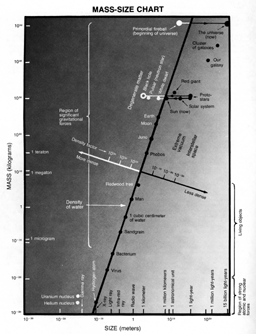 Everything in the universe from enormous galaxies to tiny atoms has a size, which can be expressed as a maximum length or diameter and a mass. The accompanying Mass-Size displays objects from a helium nucleus to clusters of galaxies and the universe itself, each point on the chart indicating the mass of an object (in kilograms) and its size (in meters).
Everything in the universe from enormous galaxies to tiny atoms has a size, which can be expressed as a maximum length or diameter and a mass. The accompanying Mass-Size displays objects from a helium nucleus to clusters of galaxies and the universe itself, each point on the chart indicating the mass of an object (in kilograms) and its size (in meters).
On the assumption that the object is spherical or cubical, the size dimension is indicative of its volume. The ratio of the mass to the volume of an object is a measure of its density. Thus, a cubic meter of air has a mass of about one kilogram but a cubic meter of lead has a mass 10,000 times as much, so, relatively speaking, air is said to have a low density while lead has a high density. Water is intermediate with a density about 800 times that of air but one eleventh that of lead. From the position of an object on the chart its (average) density can be inferred. Thus, the chart also serves as a Density Diagram for everything in the universe. Objects on the slanting line have the density of water with densities increasing to the left of the line and decreasing to the right. Atomic nuclei and degenerate matter in the form of neutron stars and black holes have the greatest density of anything in the universe while galaxies or the universe itself have the lowest densities, being equivalent on the average to an extreme vacuum.
There is a tendency for large objects to have a lower density and small objects a higher density. The earth and living objects are in between with densities near that of water.
The region of stars and planets, which is of particular interest to SETI, occupies only a small part of the diagram. The figure is constructed with logarithmic scales so that the enormous ranges of mass, size and density are greatly compressed.
Summary:
- Black holes have enormous densities.
- A pulsar (neutron star) is almost as dense, a thimble full weighing as much as 10,000 Empire State Buildings.
- Galaxies have low densities.
- The earth and living objects are in between.

Cosmic Calendar
| 15 billion BC | Universe began (BIG BANG) |
| 10 billion BC | Our galaxy formed |
| 5 billion BC | Solar system (sun, earth and other planets) formed |
| 2 million BC | Homo sapiens emerged |
| 5000 BC | Writing invented |
| 1888 AD | Hertz produced radio waves |
| 1903 AD | Letter "S" sent by radio waves across Atlantic Ocean by Marconi |
| 1959 AD | Cocconi and Morrison proposed SETI |
| 1960 AD | First attempt to detect extraterrestrial civilizations by Drake |
| 1979 AD | First issue of COSMIC SEARCH |
Distance Table
Distances in light travel time (approx.)
| Earth to moon | 1 second |
| Earth to sun | 500 seconds (8 min.) |
| Sun to Mars | 12.5 minutes |
| Sun to Jupiter | 40 minutes |
| Sun to Pluto | 5.5 hours |
| Solar system diameter (at orbit of Pluto) | 11 hours |
| Sun to nearest star | 4 years |
| Sun to center of galaxy | 30,000 years |
| Diameter of galaxy | 100,000 years |
| Distance of Andromeda galaxy | 2 million years |
| Distance to "edge" of universe | 15 billion years |
To convert light travel time to kilometers multiply travel time in seconds by velocity of light (300,000 kilometers per second).
|
Quest Beyond the Stars: Are We Alone?
By: Jesco von Puttkamer
[Article in magazine started on page 30]
This article is the second of two articles by Jesco von Puttkamer; the first, "Extraterrestrial Life: Where Is Everybody?", appeared in the Summer 1979 (vol. 1, no. 3) COSMIC SEARCH. His biographical sketch accompanied that article. This issue's article appeared earlier in "Future" magazine. Reprinted by permission of the author, Jesco von Puttkamer, Copyright © 1979.
"It is both timely and feasible to begin a serious search for extraterrestrial intelligence."
This quotation from a recently released NASA report is one of the major conclusions of a feasibility study on the Search for Extraterrestrial Intelligence (SETI), supported by a committee of distinguished scientists headed by Philip Morrison, a noted physicist at the Massachusetts Institute of Technology. The report proposes a seven-year program of progressive radio search for other civilizations in the universe based on present-day detection equipment. If there are radio signals coming toward our solar system from intelligent and communicative creatures in space, sooner or later a program like SETI should detect them.
The dream of communicating with species other than humans is one of the oldest of mankind. From the childhood enchantment of Dr. Doolittle to today's wondrous explorations into communication with primates and dolphins, and to the speculations and fantasies of science fiction, in which the notion of contact with extraterrestrial intelligences is solidly (and, lately, lucratively) entrenched, humans have always found great excitement and, yes! hope in the idea of exchanging knowledge with others, be it as teacher of less developed or student of more advanced species. Now, with the new revolution in scientific thinking regarding the plentitude of other planetary systems and the frequency of occurrence of intelligent life in the universe, science is seriously gearing up to tackle the problem of seeking other civilizations in space, saying, in effect, "We are not alone."
The idea of establishing radio contact with interstellar races by first searching for microwave signals using the radio-astronomy technology available to us was introduced to the scientific community in 1959 by Morrison and another physicist, Giuseppe Cocconi, in Nature magazine (see COSMIC SEARCH, January 1979). One year later, the radio-astronomer Frank Drake pointed a 27-meter antenna for about four weeks at two nearby stars, Epsilon Eridani and Tau Ceti, both about 11 light-years distant, searching for signs of intelligence. Named Project Ozma, the pioneering first attempt at SETI failed to detect signals though—which isn't too surprising in view of the brief, almost cursory nature of the search (see COSMIC SEARCH, January 1979). Since then, there have been other searches but the number of stars examined so far isless than one-tenth percent of the number that would have to be investigated to stand a reasonable statistical chance for discovering another civilization.
As I noted in the Summer 1979 issue of COSMIC SEARCH, the Milky Way galaxy may, at this instant, be the home of as many as one million civilizations at or beyond mankind's present level of development* (* A case could also be made for the opposing view, in which intelligent life is sparse in the universe: If the average lifetime of a technological civilization is much shorter than the assumed ten million years, we are practically alone; if the start-up and evolution of life happened later and slower than assumed, we may be standing in the morning light of the universe, among the very first of intelligent races.). With 200 billion potentially suitable stars in the Galaxy, there is a chance of 1 in 200,000 for each star to harbor one or more planets, and as many stars would have to be examined one by one. Less than 200 have been, so far.
There are billions of other galaxies in the observable universe, strewn through billions and billions of light-years. All of them may be cradles of life forms and intelligent races-billions of them. But the distance between us and them makes it highly unlikely that we'll ever receive signals from them unless it's from some hypothetical ultra-civilization that is so immensely far advanced beyond our level of development that its manifestations may appear to us as "cosmic wonders". To engage in a radio dialogue with such far-distant races of beings is out of the question. A two-way radio signal to even the galaxies closest to Earth, the Magellanic Clouds (at 200,000 light-years) and M31 in Andromeda (1.8 million light-years), would require 400,000 years and 3.6 million years, respectively.
Within our own Galaxy, too, distances beyond 1000 light-years will make two-way exchange unlikely. Civilizations are interested in microwave radio communications probably only for limited time. By the time the receiving race has answered the signal, more than 2000 years later, the supercivilization might have passed on to an advanced state beyond the communicative phase. Our main interest, at first, will therefore be on regions in space not over 1000 light-years away.
Star distribution varies widely throughout the flattened disk, nucleus and halo of our Galaxy, which measures 100,000 light-years in diameter, but the average separation between stars in the neighborhood of our Sun is about 7 light-years (i.e., one star in about 343 cubic light-years)* (* See Glossary for definition of light-year.). In a volume with a 1000 light-year radius around the Sun, therefore, there are sprinkled about 10 to 12 million stars. Assuming one third of them to be on the Main Sequence of the Hertzsprung-Russell diagram, thus having the "right" age, and half of these to be binary or multiple stars, of which only 10% may be suitable for a planet, we are left with 2.2 million suns which may have at least one planet with life.
Assuming further that one million supercivilizations are randomly distributed in the Galaxy, there should be about 55 of them within 1000 light-years from Earth. If all of them are radiating signals at us, we must investigate 40,000 stars to have a fair statistical chance of detecting a single extraterrestrial message—but the probability of being successful would still be only 63 percent. To raise our chances to 95 percent, the number of stars to be checked increases to 120,000. But if only 20 of the 55 civilizations are transmitting, it would have to be 330,000 stars.
Supercivilizations may be "talking" to each other across cosmic distances, but unless their communication beam is tightly bundled and Earth, on an extremely improbable chance, happens to come into the line-of-sight, we could not hope to detect other races by the "leakage" from their routine radio chatter at the longer distances.
But if "they" are the kind of creatures who—like humans—need and enjoy communicating, we could expect them to set up a beacon transmitting "call" signals, to facilitate the problem of initial acquisition by the hoped-for partner. The main dilemmas of SETI are that we don't know at what frequency in the radio spectrum to listen, and in what direction to point the antenna. Since the transmitting race is faced with the same questions, it may decide to set up continuous transmissions of sufficiently wide-bandwidth signals in all directions in space (isotropic), rather than a narrow-band, highly directional beam.
But such a "simple" omnidirectional beam requires tremendous transmitter power, and only a truly advanced supercivilization may be able to afford the energy expenditure—on the order of ten billion trillion (1022) watts—to transmit over a distance of 1000 light-years for nondirectional reception. This is about 3 billion times the total current power consumption of all mankind (about 7 trillion watts).
Speculations about such ultra-advanced civilizations, thought out by brilliant minds, have found their way into the scientific literature. The Soviet astrophysicist Nikolai Kardashev, for example, has boldly classified hypothetical advanced technological races in the universe in three categories according to the amount of energy they are capable of harnessing: Type I, at a level near that of our present-day Earth civilization, controlling about 7 trillion (7 x 1012) watts; Type II, civilizations capable of capturing and using the entire energy output of their central star, assumed to be of the power of our Sun (400 trillion trillion watts); and Type III, ultra-civilizations that command the energy of an entire galaxy, some trillion trillion trillion (1037) watts.
While we should be able to detect the signals of any Type II civilization in our Galaxy and those of Type III races anywhere in the universe, even without knowing beforehand where to look, if they use their tremendous power to transmit continuously in all directions, the omnidirectional beacon over distances less than 1000 light-years would require much lower power levels, on the order of a billion (109) watts. This would be within the capability of even Type I civilizations, but the need for high directivity of our receiving antennas in order to pick up these signals forces us into a serial search mode, in which one star is examined at a time. Earlier, we have seen that from 120,000 to 330,000 stars (perhaps even more) would have to be investigated within 1000 light-years for a 95 percent chance of success. If we spend 15 minutes with each star, the total search, not counting nonproductive "set-up" and "down" times, will take anywhere from four to ten years.
The second major problem of SETI, finding the wavelength or frequency of the putative signal, can be alleviated by using multi-channel receivers employing digitally "smart" multi-channel spectrum analyzers that listen to millions of narrow frequency bands at a time. Metaphorically, the classical needle-in-the-haystack dilemma of SETI, thus, becomes less formidable by having millions of hands to help sift through the hay. And we can try to "second-guess" the other civilization's transmitting logic in selecting most promising "universal" frequency regions.
In 1971, a study group under Bernard Oliver, sponsored by the NASA-Ames Research Center, proposed Project Cyclops, a large ground-based phased-array radio telescope of 10 kilometers diameter, consisting of 1026 dish antennas each 100 meters across, all electronically steered by a complex computer system. Cyclops could detect a billion watt beacon at a mind-staggering distance of 1000 light-years if it is sending in the cosmic "quiet zone" of the microwave spectrum, or leakage signals from a Type I race to 100 light-years. The wavelength range preferred for the search, originally proposed by Cocconi and Morrison, lies between 17 and 21 centimeters (1400 and 1727 megahertz). The region has been called the "water hole" because it is
bounded by the spectral lines of the water components hydrogen and hydroxyl (the OH ion), and it is hoped (perhaps, chauvinistically and erroneously) that other civilizations, dependent on water presumably as much as we are, might broadcast their signals in that range to facilitate the search. At these frequencies, Cyclops could detect a signal as weak as one photon per second per square kilometer.
"The dream of communicating with other species is one of the oldest of mankind."
Cyclops may also be built in space or on the backside of the moon, but because of its high price tag (ranging up to $10 billion depending on its evolutionary growth over the years), the more recent SETI study set its sights much lower. It is proposing a more modest project, starting with existing antennas and working itself up to larger ground- or space-based systems if it should become necessary to widen and deepen the search. The task would be rendered manageable by the development of multi-channel spectrum analyzers for, initially, examining a million and later a billion frequency "slices" simultaneously. As its name implies, SETI will limit itself to basic reconnaissance: it intends to listen rather than to transmit, to search rather than to announce.
We may speculate that the omnidirectional beacon somewhere out there in space would not only transmit—for as long as a thousand years, perhaps—a wide-band call signal designed to reliably establish the source as an artificial object from a tremendous number of natural radio sources in the universe, but also an interspersed narrow-band stream of information with some repetition cycle. This way, reception of the first "batches" of information would not have to await our acknowledgment of acquisition of the call signal. Of course, even if we succeed in decoding and understanding the message, we may not comprehend
its meaning. Intelligibility is the ability to tell what the message is saying; comprehension requires the ability to translate the message into images of real situations familiar to us.
Inter-species communication with extraterrestrial creatures by electromagnetic waves over interstellar distances, as we can see, is severely limited by such factors as extreme time intervals for two-way transmissions, fundamental differences in biological and social evolution causing difficulties in message comprehension, lack of physical contact for biological research and exchange of material objects, inability to contact less developed races and to explore nonintelligent life forms and physical phenomena in the universe, and absence of that special sense of adventure and excitement which comes with physical expansion and exploration. If interstellar spaceflight were possible, these limitations would disappear.
With our present-day technology, we are still eons away from making starflight a practical proposition for humans. Let's face it: the distances to be transversed within reasonable flight times are simply too large. The reaction mass and energy required for the trip even to the nearest stars, the triple-star system of Alpha Centauri (4.3 light-years) or Barnard's star (a dim red dwarf about 6 light-years away), are too great to be contained in a manned rocket. Using the most advanced spaceship engine concept currently foreseeable, controlled thermonuclear fusion with laser ignition, we could make the round-trip to Alpha Centauri in 82 years. Racing along at a maximum clip of 10 percent of the speed of light—30,000 kilometers per second—we would burn up about 81,000 tons of propellants to drive a 10,000-ton ship. Even with the ultimate rocket propulsion system, the photon rocket with matter-antimatter annihilation and zero-loss conversion of the liberated energy into photic propulsion thrust, which could achieve velocities close to that of light, the Alpha Centauri run would take 5 years
each way, and a 1000-ton ship would have to annihilate 33,000 tons of matter enroute, releasing some 3 trillion trillion joules of energy which, at 0.1 cent per kilowatt-hour, would represent about 900 trillion dollars worth of nuclear fuel.
Sending out unmanned interstellar probes on one-way voyages would be an alternate and easier way of establishing physical communication. One concept, proposed by a study group of the British Interplanetary Society, is Project Daedalus, an interstellar probe to Barnard's star. The design calls for a two-stage rocket, both stages powered by nuclear fusion reaction engines using pellets of deuterium and helium-3, ignited by high-powered electron beams. The 4000-ton probe would require 50,000 tons of propellants and travel at 12 percent of the speed of light, taking some 60 years for its mission. Such interstellar probes could be launched by extraterrestrial intelligences, too. Ronald Bracewell of Stanford University, who first discussed this possibility, has suggested that we be alert for such probes (called "Bracewell probes") in our own solar system right now. In science fiction, Arthur C. Clarke used the idea for the film 2001-A Space Odyssey.
But if there really are highly advanced technological races in the Galaxy, at least those of them that feel, like humans do, the urge of physical expansion and exploration may have developed mighty interstellar spaceships. How long would it take such a supercivilization to colonize the Galaxy?
Colonization time depends on travel time, time to establish a settlement, possibly on more than one planet of the new system, and a new population with an adequate industry and large enough resources base, and time to build a new fleet for further expansion.
Let's assume that a civilization must reach a "critical mass" of, say, ten billion people to develop motivation for interstellar travel and be able to afford it (Earth today: about four billion). Let's further assume that from each established society 10,000 individuals, along with whatever plant life and livestock they need (perhaps in forms of deep-frozen genetic material and embryos), succeed in reaching another star in their Space Arks and settling at least one planet.* (*Our supercivilization would probably send out other groups at later times, but let's assume that they consider their cosmic duty done after dispatching enough ships to establish at least one 10,000-people colony.) If the average distance between planetary systems is 10 light-years and the travel velocity one-tenth the speed of light, it would take our expedition 100 years to reach a new system. To establish a settlement and build up a new population of ten billion would then take another 470 years, if the annual population growth rate is 3 percent. Launching a new expedition of 10,000 colonists, it would then take again 100 years to reach the next planetary system, and 470 years to build a society. Thus, the total colonization time for each new system (and to advance ten light-years), is 570 years. In our scenario, colonization of the Galaxy would take place at an average expansion rate of 2 percent of the speed of light, or five million years to cover the Galaxy from edge to edge, assuming just one star-faring race.
What if the hypothetical race nearest to Earth, an average 250 light-years away, is engaged on such a long-range colonization program in this very moment! If they embarked on it 15,000 years ago, they'll reach our solar system any day now .....
But what are the odds for such a surprise visit? Not all of our one million supercivilizations can be expected to be capable of or to be interested in paying the high price of colonizing the Galaxy, to " . . . explore strange new worlds, to seek out new life and new civilizations." If only one percent of them are roaming the Galaxy seeking suitable planets, there would be a total of ten-thousand star-travelling supercivilizations with an average of ten million planets each to visit (assuming a random distribution of 50 to 100 billion planets). If each civilization's "star trekking" effort is determined enough to yield one new planet per year, it would take their fleet ten million years to visit all planets, or the equivalent of a supercivilization's assumed lifetime.* (* Science fiction, of course, can be more flippant with the subject of galactic colonization, especially when pursued by network television. For STAR TREK'S starship Enterprise, under orders by the TV producers to visit one planet per week (or about 25 planets per TV "season"), the job would have been much easier: it could have speeded up galactic exploration 125-fold. With a fleet of 50 Enterprise-class starships, Starfleet Command could explore a million planets in 800 years, finding an estimated 100,000 intelligent life forms, of which 10,000 would have developed technology. But, then, these fabulous ships were equipped with the superphotic (faster-than-light) Roddenberry Warp Drive, strictly from the realms of fantasy.) If they started checking planets about 100,000 years ago, each civilization would have catalogued only 100,000 planets by now, and the chance for Earth to be visited this year would be negligible—one in 10 million.
All in all, we can conclude that interstellar flight by mere earthlings is out of the question not only for the present but also for at least the next two or three decades. It is not a physical impossibility but an economic one, and new breakthroughs must occur to enable man to travel to the stars. In the meantime, SETI offers a chance of finding a star race that could perhaps help us to make such breakthroughs happen.
"Contact with extraterrestrial intelligences is perhaps a necessary prerequisite for a race to survive which would make SETI one of the most imperative ventures of mankind."
But why would a supercivilization go to the enormous expense of erecting an omnidirectional one-way beacon in the first place? Could it be that a society's future development is to some extent contingent on reception and assimilation of information from supercivilizations, perhaps leading to a rapid jump of the society to the highest level? This so-called "feedback effect" was suggested first by Sebastian von Hoerner. The information thus received may be the chance for a civilization to "improve" itself rationally. In its widest sense it could perhaps mean that contact with extraterrestrial intelligences is a necessary prerequisite for a race to survive and to become a "supercivilization" itself,—which would make SETI one of the most imperative ventures of mankind. Can we afford the risk to assume this isn't so?
As suggested by Bracewell and others, the emerging race would then join a galactic community of supercivilizations and, in that process, partly in repayment of the galactic equivalent of a "student education loan", assume its share of the "Club's" obligation to establish a beacon and in turn help other lower civilizations to make the grade—a bit like a galactic chain-letter program. As the Project Cyclops report commented, the start of such a community chain effort is difficult to explain but may have been like the beginning of life itself—not in any single trial by some earlier race, but after perhaps millions of attempts, of which only a few (or one) need to have been successful to start the whole process.
The first interstellar messengers from Earth are already underway.
 Two Voyager spacecraft are currently heading out toward the planets Jupiter, Saturn and points beyond, to leave the Solar System in 1989 when they cross the orbit of distant Pluto. Plodding through the interstellar abyss at 17 kilometers per second, they will take at least 40,000 years before either spacecraft approaches another star, passing it at a distance of about one light-year, travelling for eternity into infinity. Each carries a 12-inch copper disk with a recording of greetings in 54 human languages, one whale language, sounds of Earth, photographs and drawings, and musical selections. The printed words include a message from President Jimmy Carter which reads in part:
Two Voyager spacecraft are currently heading out toward the planets Jupiter, Saturn and points beyond, to leave the Solar System in 1989 when they cross the orbit of distant Pluto. Plodding through the interstellar abyss at 17 kilometers per second, they will take at least 40,000 years before either spacecraft approaches another star, passing it at a distance of about one light-year, travelling for eternity into infinity. Each carries a 12-inch copper disk with a recording of greetings in 54 human languages, one whale language, sounds of Earth, photographs and drawings, and musical selections. The printed words include a message from President Jimmy Carter which reads in part:
"This is a present from a small distant world, a token of our sounds, our science, our images, our music, our thoughts and our feelings. We are attempting to survive our time so we may live into yours. We hope someday, having solved the problems we face, to join a community of galactic civilizations. This record represents our hope and our determination, and our good will in a vast and awesome universe."

|
The SEnTlnel
By: Robert S. Dixon
[Article in magazine started on page 36]
- New Evidence for Gravity Waves
- Search for Pulsed Signals on Nearby Stars
- ETI Pros and Cons Debated
- Search for Faster-than-light Particles
- Does the Universe Always Run Downhill?
- Existence of the Great Galactic Ring
- Scientists Study Virus for Ancient Messages
- Another Search for Extrasolar Planets
- Size Constraints on Living Organisms
New Evidence for Gravity Waves
The existence of gravity waves has been postulated by a number of physicists, but none have been unequivocally observed to date. However, recent observations of a binary pulsar system appear to show the existence of gravity waves.
Joseph Taylor and Lee Fowler of the University of Massachusetts and Peter McCulluch* (* Physics Today, May 1979.) of the University of Tasmania used the large Arecibo telescope, in Puerto Rico, to measure the orbital period of the pulsar, PSR 1913+16, which is orbiting around a normal star. They discovered that the pulsar and the star are revolving around each other more and more slowly. If the gravity wave theory holds, it can account for the slowing-down effect, since the binary system should be emitting energy in the form of gravity waves.
Gravity waves have been suggested as a means of interstellar communications, should we ever be able to understand them and generate them artificially.
Search for Pulsed Signals on Nearby Stars
A number of search programs have been carried out in recent years to find pulsars. Pulsars are natural astronomical objects that emit powerful radio bursts with extreme regularity. Pulsars pulse at different rates, from the millisecond range to a few seconds between pulses.
Sophisticated equipment and observing techniques have been developed to search for pulsars. It is reasonable to expect that intelligent signals might also be pulsed at a regular rate, similar to pulsars, so the existing pulsar search equipment would be well suited to search for intelligent signals.
R. Wielebinski and J. Seiradakis* (*International Scientific Radio Union meeting, Helsinki, Finland, August, 1978.), using the large 100-meter radio telescope at Bonn, West Germany, aimed the telescope at three nearby stars and searched for pulsed radio signals with periods in the range of 0.1 and 4 seconds. Each star was examined for up to one hour. No pulsed signals were detected within the capabilities of their instrumentation.
The experiment was not conclusive since only a few stars were observed, however, it did demonstrate that the techniques used for searching for pulsars might also be used in larger, more comprehensive searches for intelligent signals in the future.
ETI Pros and Cons Debated
*
(*"Science Times," N.Y. Times, April 24, 1979.)
Michael Hart, Trinity University in San Antonio, Texas, says civilized life must be exceedingly rare in the universe and the example we have on the earth may even be unique. He bases his conclusion on an analysis he has made of hypothetical planets and the requirements for the development of a civilization like our own.
In an interview with the New York Times about Hart's results, Carl Sagan voiced disagreement, stating that he thought Hart sells short the adaptability of life to hostile conditions that may exist in any given corner of the universe.
Another astronomer who requested anonymity took a middle position. He replied, "Maybe there's something out there and maybe not. Your guess is as good as mine." Because of the lack of data, he felt that arguments pro and con were unproductive reminding him of the medieval scholarly debates about how many angels could dance on the head of a pin.
Search for Faster-than-light Particles
All particles that we know of (except neutrinos) travel slower than light. As you try to accelerate them up to the speed of light it becomes increasingly difficult, because the mass of the particle increases as the speed of light is approached. Might there be other particles that always move faster than the speed of light? This would tend to provide a symmetry which is often found in nature. By analogy with familiar particles we might expect that these faster-than-light particles would increase in mass as we tried to slow them down to the speed of light. Thus, a slower-than-light particle might never become a faster-than-light particle, nor vice versa, because their masses would become infinite at the velocity of light.
Particles that move slower than light are called tardyons; those that move at the speed of light are called luxons; and those that move faster than light are called tachyons. Tachyons have some interesting and unexpected properties, according to Jayant Narlikar* (*American Scientist, Sept./Oct. 1978), Tata Institute of Fundamental Research, Bombay, India, as summarized in the accompanying table.
| Quantity | Tardyons | Luxons | Tachyons |
| Velocity: | Slower than light | Same as light | Faster than light |
| Mass: | Increases as particle speed increases to that of light | Always zero | Increases as particle speed decreases to that of light |
| Time travel: | Forward | Either way | Backward |
| Black hole size: | Increases | Indeterminate | Decreases |
Tachyons have never been observed, but that may be because we do not know how to detect them. Narlikar has suggested two ways in which we might verify the existence of tachyons, or at least verify the symmetry idea that if slower-than-light particles exist, then faster-than-light particles must also exist. Narlikar proposes first that we search for Iuxons, that go backwards in time. These might be found coming from pulsars but this measurement would be difficult because the dispersion by the interstellar medium causes different frequencies to arrive at different times so the effect tends to be masked.
Narlikar's second suggestion is that careful measurements of black holes be made over a period of time. Black holes are surrounded by spherical event horizons, through which matter can enter, but never leave. Since no light can leave, we can never see what is happening inside a black hole. The size of a black hole is determined by convention to be the size of its event horizon. When tardyons fall into a black hole, the black hole's size increases, but when tachyons fall into a black hole, its size should decrease. If we were to discover a black hole whose size is decreasing, we can infer the existence of tachyons. Although the size of a black hole cannot be measured directly, we might infer it from measurements of a double star system where one of the pair is a black hole.
If tachyons exist, the time delays required for interstellar communications could be drastically reduced. Two-way exchanges of information might be possible, rather than the one-way monologues envisioned today.
Does the Universe Always Run Downhill?
*
(* Malcolm W. Browne, N.Y. Times, May 29, 1979)
Everyone is intuitively aware of the tendency for things to become disorganized. For example, if you take a deck of playing cards, neatly organized by color and suit, and throw it up into the air, you can be sure that when the cards come down they will no longer be neatly organized. Or take a bottle of oxygen and a bottle of nitrogen and connect them together with a hose. Soon you will have two bottles of mixed-up oxygen and nitrogen. Or take a universe filled with galaxies and stars. Wait a long time and the galaxies will separate and the stars eventually burn out.
This tendency is referred to by scientists as the Second Law of Thermodynamics. It predicts that eventually everything will run down and stop. On the other hand, we know that there are exceptions to this law. Bricks can be put together to make buildings. Oxygen can be separated from nitrogen. All it takes is purposeful work. Life is the great exception to the Second Law. Living creatures can make the universe run uphill, by creating order out of disorder. Life itself appears to evolve into more and more complex creatures. How is it that life is able to prevail against the ever-present Second Law? This paradox has concerned scientists for some time.
In 1977 Ilya Prigogine, a Belgian chemist, won the Nobel prize for discovering an explanation to this paradox. He discovered certain classes of natural chemical and physical reactions which run uphill by forcing something else in their neighborhood
to run downhill faster than it normally would. These reactions create new structures that are more complex than the sum of their constituents. On the average, the Second Law may still be satisfied, but it doesn't matter. It's like paddling a canoe upstream. You make progress by pushing the water downstream faster. There is so much water that your paddling doesn't make a significant difference to the river, but you still make it to your destination.
Prigogine has formulated a theory to explain this effect and has applied it successfully in other fields, including something as down-to-earth as preventing traffic jams. His theory makes the future of the universe much more optimistic than predicted by the Second Law. Maybe we are the ones who will have to stop the universe from running down.
Existence of the Great Galactic Ring
A gamma-ray telescope onboard the NASA Small Astronomy Satellite, SAS-2, has mapped the sky's gamma-ray emission (gamma rays are similar to radio waves, except their frequency is much higher). Floyd Stecker* (*American Scientist, Sept/Oct. 1979) of NASA's Goddard Space Flight Center, Greenbelt, Md., analyzed the map and found that a majority of gamma rays are emitted from a circular ring within our own galaxy. The ring is concentric with the center of the galaxy and has inner and outer diameters of 15,000 and 20,000 light years, respectively. (See accompanying sketch).
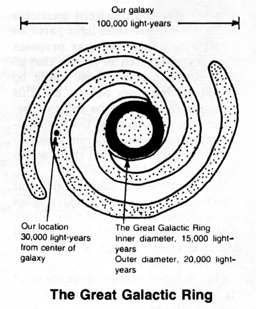 Combining this new information with previous data, Stecker concludes that the ring is a veritable hotbox of activity. It appears to be the "galactic nursery" where most of the large and bright stars are being born. Since these stars burn up relatively quickly, this ring is also the "galactic fireworks factory" where these stars become supernovae. These supernovae often leave behind rhythmically-ticking pulsars, so the ring might also be referred to as the "galactic clockworks".
Combining this new information with previous data, Stecker concludes that the ring is a veritable hotbox of activity. It appears to be the "galactic nursery" where most of the large and bright stars are being born. Since these stars burn up relatively quickly, this ring is also the "galactic fireworks factory" where these stars become supernovae. These supernovae often leave behind rhythmically-ticking pulsars, so the ring might also be referred to as the "galactic clockworks".
The ring would not appear to be a likely location for intelligent civilizations because of the short-lived stars and supernovas occurring there. On the other hand, the supernovas are spewing out the heavy elements necessary for the formation of life in other parts of the galaxy. We can take comfort from the fact that our sun is well outside the Great Galactic Ring.
Supernovas are not so common out here in the galactic boondocks.
Scientists Study Virus for Ancient Messages
*
(*Walter Sullivan, N.Y. Times, May 7, 1979.)
Two Japanese scientists, Hiromitsu Yokoo and Tairo Oshima, have investigated the genetic structure of the virus, PhiX-174, and believe it to contain a message planted there billions of years ago by some advanced civilization. Yokoo and Oshima chose
PhiX-174 because it is one of the simplest known viruses and hence easier to decode.
Each different life form on the Earth has a different genetic code, which may be written out as a long string of letters representing the chemical components of its DNA (deoxyribonucleic acid). Even for something as simple as a virus, the string is thousands of letters long. By comparison, a bacterium code requires millions of letters and the higher plant and animal codes are almost hopelessly long. A given code tends to persist for generations. A popular scenario in the formation of life on the earth is that "seeds" were planted here long long ago, from which all life eventually developed. If this were the case, Yokoo and Oshima believe it might not be unreasonable for the seed makers to use part of the original genetic code to send some form of message, knowing that it would be passed onward through time until someone would eventually comprehend it.
Thus far, the scientists have not been able to decipher the code, but their research is continuing.
Another Search for Extrasolar Planets
A new technique for finding planets associated with other stars is being employed in a search program underway at the University of Arizona. The technique is being used by K. Serkowski to measure the backward and forward movement of a star as seen by observers on earth.
As a planet and star revolve about their common center of mass, the motion of the star will produce a doppler shift in its spectral lines. If any periodic doppler shifts are detected, the existence of planets can be inferred. This technique differs from that of Gatewood (described in COSMIC SEARCH, Summer, 1979) since Gatewood's measurements involved side-to-side motion of the star.
Size Constraints on Living Organisms
*
(*Contributed by John H. Fadum)
Although the shapes and sizes of living organisms can vary enormously, there are constraints—both local (caused by environmental factors such as gravity) and global (caused by physiochemical laws) which seem to be universal.
While there is no example of extraterrestrial life now known, the possibilities and probabilities are sufficient to guarantee a spirited discussion in any group consisting of astronomers, biologists, physicists, and chemists.
Since it may be possible to have organisms smaller than earth viri, when a creature shrinks much below the molecular level, the Uncertainty Principle begins to dominate. (Under certain conditions, of course, the Uncertainty Principle is a major factor even for much larger objects.) But is there a maximum size limit? Certainly for planet-bound creatures there is the obvious fact that the larger the creature is, the heavier it will be. Even in the nearly-weightless state of water, the living organisms cannot be indefinitely large-though creatures of the sea can be much larger and more massive than landlubbers. The Great Whales, for example, are far bigger than the biggest dinosaur ever was.
There could conceivably be "energy creatures" or other beings living in empty space between the stars, as has been hypothesized by many science fiction writers; but these creatures have another constraint to contend with (as was pointed out by Arthur C. Clarke in his essay "God and Einstein"): a really large creature would have the speed-of-light time lag to contend with. If a creature of this sort sensed a danger/food/weather signal at one end, it would not have time to evoke the appropriate response at the other end, if it were more than a few tenths of a light-second long. Even if the reaction time were instantaneous, like that of a living geon (as discussed in J. A. Wheeler's Geometrodynamics, Academic Press, 1963), the creature would still have to be small by astronomical standards, or be very sluggish.
Note: The size constraints on organisms have been discussed in a very entertaining, although limited way, by J. B. S. Haldane in his article "On Being the Right Size." ("The World of Mathematics", Vol. 2, Simon and Shuster, 1956).
We Need Your Help
Many COSMIC SEARCH readers are in places where they learn first-hand about interesting things happening in SETI. While we make every effort to keep abreast of what is happening, we can't be everywhere. Please help us keep readers informed of the latest SETI happenings. If you hear about a relevant research project or conference, let us know. If you see an interesting magazine or newspaper article, please send us a copy (with name and date of publication). Don't be concerned if you don't know all the details—we will try to follow up appropriately. We will give credit in print for each item of information that we use.
|
SETI Popular in Colleges
By: Editors
[Article in magazine started on page 39]
Many colleges and universities are giving or planning to give courses about the Search for Extra-Terrestrial Intelligence (SETI). In the Summer 1979 issue we listed courses at five institutions as follows:
Consumnes River College, Sacramento, California
Menlo College, Menlo Park, California
Ohio State University, Columbus, Ohio
San Diego State University, San Diego, California
Stockton State College, Pomona, New Jersey
In this issue we list eleven courses at nine more institutions. We would like to list additional institutions with SETI courses. Please send information to Prof. John Kraus, Editor of COSMIC SEARCH, Ohio State University Radio Observatory, 2015 Neil Ave., Columbus, Ohio 43210. Years given, attendance, a syllabus (if available) and other information will be appreciated.
Institution: Leeward Community College, Kaneohe, Hawaii 96744
Instructor: Fritz Osell.
Title: Special Topics in Astronomy (Astronomy 111)
Content: The search for extraterrestrial intelligence.
Reference: COSMIC SEARCH
Year given: 1979 (spring)
Enrollment: 60 to 80.
Institution: Louisiana State University, Baton Rouge, Louisiana 70803
Instructor: Prof Howard E. Bond, Dept. of Astronomy.
Title: SETI and Other Current Topics in Astronomy.
References: Shklovskii and Sagan, "Intelligent Life in the Universe"; Sagan, "The Cosmic Connection"; Ridpath, "World's Beyond".
Given each spring.
Institution: Otterbein College, Westerville, Ohio 43081
Instructor: Dr. Philip E. Barnhart, Dept. of Physics and Astronomy.
Title: Man and the Universe (Introductory Astronomy).
Content: The concept of evolution is extended from that of the universe, to galaxies, stars, chemical elements, molecules, biological growth, human evolution and the evolution of intelligence.
Years given: 1974 to date.
Enrollment: 80 to 150 per year.
Institution: Otterbein College, Westerville, Ohio 43081
Instructor: Dr. Philip E. Barnhart, Dept. of Physics and Astronomy.
Title: Communication with Extraterrestrial Intelligence.
Content: Exploration of a wide range of methods of communication, value judgement relating to what is communicated, skill in model building and assessment to increase competence in writing, speaking and group interaction as an alternative to the traditional English composition course. Barnhart writes: "This course is one of the most enjoyable experiences I have
encountered in college teaching."
References: Sagan, "The Cosmic Connection"; Christian, "Extraterrestrial Intelligence: The First Encounter".
Years given: 1974 to date.
Enrollment: 15 to 20 per year.
Institution: University of San Francisco, San Francisco, California 94117
Instructor: Prof. Louis Berman, Dept. of Physics and Astronomy
Title: Intelligent Life on Other Worlds.
Content: This course is designed to acquaint the student with:
(1) the growing scientific interest and popular awareness being given to the possibility of discovering extraterrestrial intelligence;
(2) the techniques of search strategy that will ultimately lead to communication with advanced societies; and
(3) the profound consequences for our civilization when interstellar dialogue with an alien society is established.
Topics covered are: Speculations, old and new, on the plurality of other worlds; the formation and evolution of planetary systems; the physical and chemical nature of planetary life; the origin of life on the earth; biological, social and cultural evolution; intelligence on alien worlds and technical civilizations; exploration of the solar system: Pioneer, Mariner, Viking, Voyager, Galileo, etc.; artificial automata, interstellar probes and UFOs; interstellar space travel and communication, the search for extraterrestrial intelligence, Project Cyclops; some philosophical considerations should we make contact.
References: Sullivan, "We Are Not Alone"; Ponnamperuma and Cameron, "Interstellar Communication: Scientific Perspectives"; Bracewell, "The Galactic Club"; Christian, "Extraterrestrial Intelligence: The First Encounter", COSMIC SEARCH.
Years given: 1978, 1979.
Institution: Stanford University, Stanford, California 94305 Instructor: Prof. Peter Sturrock, Dept of Applied Physics.
Title: Extraterrestrial Intelligent Life (Applied Physics 25).
Content: Possible existence of extraterrestrial intelligent life and the prospects of contact. Galactic structure, stellar types and solar planets. Chemical and biological evolution. Radio communication, interstellar probes, interstellar travel and space colonization. No prerequisites.
Years given: 1978, 1979.
Enrollment: 60
Institution: Stanford University, Stanford, California 94305
Instructor: Prof. Ronald N. Bracewell, Dept. of Electrical Engineering.
Title: The Galactic Club: Intelligent Life in Outer Space (Engineering 25).
Content: Possible existence of intelligent life elsewhere in the galaxy and its significance for human values. Planetary formation, prebiological evolution, origin of life, radio communication, rocket travel, celestial mechanics and colonization of interplanetary space. Prerequisites: Introductory astronomy or consent of the instructor.
References: Bracewell, "The Galactic Club: Intelligent Life in Outer Space".
Years given: 1977, 1978.
Enrollment: 60
Institution: Washington and Jefferson College, Washington, Pennsylvania 15301
Instructor: Prof. Raymond M. Bell (now emeritus).
Title: Extraterrestrial Intelligence.
Content: Astronomy basics, biological and chemical considerations, probabilities of extraterrestrial intelligence, methods of communication, types of messages, coding and decoding, future prospects.
Years given: 1974, 1975.
Enrollment: 14 (1974), 27 (1975)
Institution: Wheaton College, Norton, Massachusetts 02766
Instructor: Timothy Barker, Dept. of Physics.
Title: Extraterrestrial Life (Astronomy 120a)
Content: The universe, galaxies and star formation. The nature and development of life, life in the solar system, life in other planetary systems, frequency and longevity of civilizations, communication with extraterrestrial life.
References: Shklovskii and Sagan, "Intelligent Life in the Universe"; Sagan, "The Cosmic Connection"; Berendzen, "Life Beyond the Earth and the Mind of Man".
Years given: 1975, 1977, 1979 (and to be yearly thereafter).
Enrollment: 30 (1975), 15 (1977).
Institution: John Carroll University, University Heights, Ohio
Instructor: J. Richard Keefe, Ph.D., Adjunct Professor of Biology
Title: Space Biology (Biology 460)
Content: Problems of biology encountered in the environment of space. A study of the biological principles and processes as they apply to life in a non-earth environment, with special emphasis on human adaptation to space travel and colonization. Current knowledge and recent advances in space biology from both U.S. and U.S.S.R. flight experiments are reviewed through a variety of literature searches.
References: Shklovskii and Sagan, "The Possibility of Intelligent Life Elsewhere in the Universe", U.S. Government Printing Office publication number 052-070-04332-6; "Foundations of Space Biology and Medicine", NASA Report 374, Govt. Printing Office pub. numbers vol. 1-033-000-00605-5, vol. 2/1-033-000-00606-3, vol. 2/2-033-000-00607-1, vol. 3-033-000-00608-0; "Soviet Space Programs, 1971-1975" vol. 1, Govt. Printing Office number 052-070-03657-5.
Years given: 1977 and 1979.
Enrollment: 11 (1977), 13 (1979)
Institution: Case Western Reserve University, Cleveland, Ohio 44106
Instructor: J. Richard Keefe, Ph.D., Assistant Professor of Anatomy, School of Medicine.
Title: Biological Problems of Man in Space (Anatomy 420)
Content: Space biology from a broad background including SETI.
References: Same as John Carroll University course (Biology 460) (see above) plus many others such as Walter Sullivan, "We Are Not Alone"; Oro, Miller, Ponnamperuma and Young, "Cosmochemical Evolution and the Origins of Life"; Edelson, "Who Goes There? The Search for Intelligent Life in the Universe"; Sagan, "Broca's Brain: Reflections on the Romance of Science"; Berendzen, "Life Beyond the Earth and the Mind of Man"; Roulet, "The Search for Intelligent Life in Outer Space" (English translation).
Years given: 1978, 1979
Enrollment: 6 (1978), 25 (anticipated number for fall 1979 semester).
|
The Possibilities of SETI from Space
By: Roy P. Basler
[Article in magazine started on page 41]
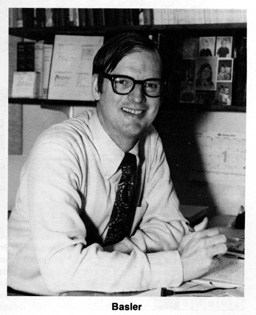 During 1975 and 1976, several of us at SRI (then known as the Stanford Research Institute) did a study for the SETI Program Office at the National Aeronautics and Space Administration (NASA) to find out what kind of antenna system would be best suited to searching for a radio signal from outer space. We developed a methodology that allowed us to compare such different concepts as antennas on earth, in space, and on the moon, and we found that space systems are the best if we need to examine more than a few hundred thousand stars in our search for an intelligent signal.
During 1975 and 1976, several of us at SRI (then known as the Stanford Research Institute) did a study for the SETI Program Office at the National Aeronautics and Space Administration (NASA) to find out what kind of antenna system would be best suited to searching for a radio signal from outer space. We developed a methodology that allowed us to compare such different concepts as antennas on earth, in space, and on the moon, and we found that space systems are the best if we need to examine more than a few hundred thousand stars in our search for an intelligent signal.
Thanks to the pioneering work of Frank Drake, Philip Morrison, and Bernard Oliver, among others, we now have a testable hypothesis about powerful microwave signals transmitted by other civilizations in our galaxy. First, the signal is assumed to be in the wavelength band from 18 to 21 centimeters. This band is known as the "water hole" because it is bounded by the natural-line wavelengths radiated by the dissociation products of water and because it is within the portion of the spectrum with the lowest background noise for an electromagnetic detection system. Second, it is assumed that the signal is being transmitted in our direction with an effective radiated power of one gigawatt (one billion watts). This assumption about the
transmitted power is somewhat arbitrary, but it is plausible in light of the fact that we are now developing detailed designs for our own solar power satellites that will each transmit 10 gigawatts of microwave energy toward the earth from geosynchronous orbit. Finally, it is assumed that the search should be directed toward individual stars judged likely to be associated with transmitting civilizations.
How Do We Choose a System?
The type of radio equipment we need will vary depending on the number of stars we decide to examine. The optimum system for searching hundreds or thousands of stars is quite different from one designed to search millions. In our entire galaxy, there are billions of stars that are enough like our sun to be good candidates for SETI. With our present limited resources, though, there is no point in talking about extending the search beyond our local galactic neighborhood. There are more than two million candidate stars within 1000 light-years of earth, and if we do no detect a signal from one of these, we clearly should reconsider our hypothesis.
A number of technical parameters, such as sky coverage, system temperature, antenna size and efficiency, and dwell time on a given star, must be considered in evaluating interstellar search systems. However, we can compensate for weak parameters in any system by building larger antennas. In this way, all systems can be made to achieve the same performance, as measured in such terms as detection sensitivity and probability of receiving a signal. With technical issues thus conveniently set aside, we are able to choose a system on the basis of only two considerations with which everyone is familiar: time and money.
Although time is in some ways related to money, it requires individual attention here because all of us, being mortal, are to some degree impatient. We want our answer soon, and the prospect of not receiving a signal in our lifetime can drastically dampen our enthusiasm for getting a search underway now. In the hope of minimizing the search time, our approach should be to start examining the individual candidate stars that are closest to earth, and then to extend the search to include stars at greater and greater ranges. If we were to spend only half an hour searching each star, which is a practical value for the
search or dwell period, it would take about 57 years to examine a million stars one by one. If we are limited to looking at one star at a time, and if we are unfortunate enough to have to examine millions of stars before we receive a signal, the search will thus require a century or more. Thus, for large-scale searches, a premium is placed on the ability to operate with several simultaneous antenna beams, each directed toward a different star. Of course, we could change our assumption about the effective radiated power of the transmitted signal and use a low-gain antenna with broad enough beam to include several stars simultaneously. However, this low-gain approach transfers a much heavier burden to the transmitting civilization; so for purposes of this discussion, let's stick with the strategy of searching individual stars instead of patches of sky.
With regard to money, there are various ways of discussing the cost of a system. We could talk simply in terms of the procurement cost, which is what we have to pay for the equipment itself, but some systems that are cheap to buy are expensive to operate and maintain. Also, some exotic systems might be cheap to buy, operate, and maintain, but they require a tremendous investment in research and development before they can be made available. For these reasons, I compare different system concepts on the basis of overall cost, defined as the sum of the costs for research and development, procurement, and operation and maintenance for the duration of the time required to search a given number of stars. By applying the basic methodology of adjusting antenna size until all systems achieve the same level of performance, we can use considerations of time and money to show how such far-out concepts as interstellar search systems on the moon or in space compare with more
conventional systems on earth.
Earth-based Systems
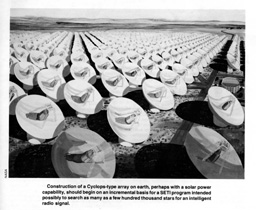 There are only two viable alternatives for an interstellar search system on earth. One is an array of fully-steerable
parabolic dishes such as that described in the Cyclops study conducted by NASA in the summer of 1971. The other is an
array of fixed spherical dishes similar to the one in operation near Arecibo, Puerto Rico, in a natural sinkhole in the
Karst topography of that region. A 305-meter Arecibo dish, compared to a 100-meter Cyclops dish, costs less per unit
area, but covers less sky because of its more limited steering capability. When arrays of these dishes are compared
on the basis of the number of stars they can examine, it is found that they do not differ significantly in terms of overall cost. Cyclops is thus suggested as the preferred design for an earth-based SETI system because it has fewer constraints on its operation and its possible location than an Arecibo-type system.
There are only two viable alternatives for an interstellar search system on earth. One is an array of fully-steerable
parabolic dishes such as that described in the Cyclops study conducted by NASA in the summer of 1971. The other is an
array of fixed spherical dishes similar to the one in operation near Arecibo, Puerto Rico, in a natural sinkhole in the
Karst topography of that region. A 305-meter Arecibo dish, compared to a 100-meter Cyclops dish, costs less per unit
area, but covers less sky because of its more limited steering capability. When arrays of these dishes are compared
on the basis of the number of stars they can examine, it is found that they do not differ significantly in terms of overall cost. Cyclops is thus suggested as the preferred design for an earth-based SETI system because it has fewer constraints on its operation and its possible location than an Arecibo-type system.
One possible way of reducing the costs of an earth-based SETI program would be to modify the dishes so they can be used as solar collectors during the day and to sell the electrical power they produce. Although the details have not been worked out, preliminary estimates indicate that a system with this dual function may be both technically feasible and economically attractive.
Space Systems
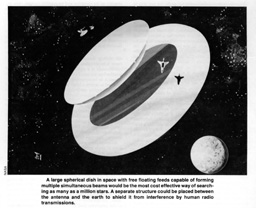 An orbiting antenna system has several attractive features. It has complete sky coverage, it can track a given star continuously if a signal is detected, and the weightless, weatherless environment in space gives it long life and allows it to be structurally simple. In addition, the time required to search a large number of stars can be substantially reduced by using multiple free-floating feed systems with a single primary receiving dish to form several simultaneous beams.
An orbiting antenna system has several attractive features. It has complete sky coverage, it can track a given star continuously if a signal is detected, and the weightless, weatherless environment in space gives it long life and allows it to be structurally simple. In addition, the time required to search a large number of stars can be substantially reduced by using multiple free-floating feed systems with a single primary receiving dish to form several simultaneous beams.
Another possible advantage of a space system is its freedom from interference produced by human radio transmissions. It may be possible for an earth-based system to avoid this interference problem through appropriate international agreements to keep the water hole quiet, but a space system could provide its own protection in the form of a separate structure to shield it from the earth.
Although there are many uncertainties in estimating the costs of space antennas, it seems clear that small space-systems will be more expensive than comparable systems on earth. However, very large systems designed to search more than a few hundred thousand stars will probably be cheaper if located in space. In other words, if we ever do decide to undertake a really large-scale search, we could save substantial amounts of both time and money by using a large space antenna with multiple beams. Of course, lots of research and development effort will be needed before we will have the capability to deploy a large SETI antenna in space, but this effort would be a straightforward extension of the programs that several aerospace companies now
have underway for the development of space antennas for terrestrial communications applications.
Moon-based Systems
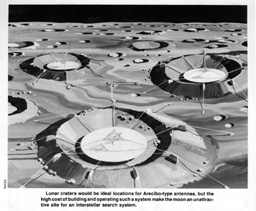 The far side of the moon is an attractive site for an interstellar search system primarily because it is always facing away from the earth and is thus completely free from radio frequency interference from transmitters either on earth or in orbit around the earth. The absence of a substantial atmosphere and the relatively weak gravitational force also provide an advantage for lunar systems because they can be much less massive than similar structures on earth. A serious disadvantage, however, is the high cost of building and operating a system on the moon.
The far side of the moon is an attractive site for an interstellar search system primarily because it is always facing away from the earth and is thus completely free from radio frequency interference from transmitters either on earth or in orbit around the earth. The absence of a substantial atmosphere and the relatively weak gravitational force also provide an advantage for lunar systems because they can be much less massive than similar structures on earth. A serious disadvantage, however, is the high cost of building and operating a system on the moon.
When antennas on the moon are compared on the basis of the number of stars they can examine, it is found that the overall cost of Arecibo-type systems on the moon is much lower than the cost of Cyclops-type systems, whereas the costs of these two different systems are virtually the same on earth. This advantage for Arecibo-type antennas on the moon results from the possibility of using lunar craters to make a significant improvement in antenna design. In particular, the towers that support the feed, which are a major component of the cost of the actual antenna in Arecibo, can be eliminated on the moon by choosing large craters and filling only a portion with the reflector. Both the feed and the dish can thus be suspended on long cables
extended from the crater rim. The abundance of lunar craters of a suitable size (about 700 meters in diameter) makes this design improvement feasible.
Nevertheless, when antennas on the moon are compared with antennas on earth or in space, even these improved lunar systems are found to be much more expensive than either of the other systems. Furthermore, the primary attraction of a moon-based system is freedom from radio frequency interference, but this freedom is also available with space systems, so there seems to be no point to giving serious consideration to the moon as a potential base for SETI activities.
An Incremental SETI Program
It is probably safe to assume that all of us who read COSMIC SEARCH would like to start right away on a substantial SETI program that can be sustained until we are satisfied that we have not overlooked any easily detectable signals from any galactic neighbors we may have. I would like to suggest that a sensible strategy for a SETI program could be based on a trade-off between systems on earth and in space. In particular, research and development efforts could begin immediately for systems both on earth and in space. If effective protection against radio frequency interference can be assured, procurement of an
earth-based system, perhaps with a solar power capability, could begin within 5 years, and it could proceed at a rate of perhaps 50 dishes per year for a maximum of about 10 to 15 years. The search could begin as soon as the first dish is operational, and each new dish could join the search when it is ready.
If the interim search has not been successful, and if preliminary prototype tests have proved the feasibility of the space system concept, the procurement of the earth-based system could stop after a few hundred dishes have been constructed. At this time, a susbstantial commitment could be made to the procurement of a large space system. The procurement period would extend over perhaps 5 to 10 years, during which time the earth-based system could continue its search. Ultimately, the entire cost of the earth-based system might be recovered from its profitable operation as a solar power plant.
Once the large space system becomes operational, its multibeam design would allow it to complete a search of all the candidate stars out to a range of 1000 light-years within a few years. Thus, before the end of the second decade of the next century, we could make a definitive test of the hypothesis that at least one civilization within our thousand-light-year neighborhood is transmitting an effective radiated power of one gigawatt in our direction in the wavelength band from 18 to 21 centimeters.
I will personally have to be pretty lucky to live long enough to see the conclusion of such an ambitious program. However, no one can calculate how long the search will have to be continued, since it is entirely possible that we could detect a signal early in the program. For this reason, I have not said anything here about what the actual overall cost of such a program might be. It is more appropriate to say that as a long-term average, the expenditures would represent only about ten percent of the present annual NASA budget.
Opportunities for Man in Space
If we want to mount a large-scale search effort, we should plan to carry it out eventually with an antenna in space in accordance with the SETI program outlined above. For many reasons, I think it is important to emphasize that a SETI program should be considered as part of our space program. Not only do we look to space as the region that may harbor other life-forms, but we can assume that any civilizations that are broadcasting a detectable beacon signal have probably developed a considerable space technology of their own, from which we might have much to learn. The most effective way for them to establish a beacon would be to put it in orbit around their star, to collect energy from the star's radiation in the visible portion of the spectrum, and to reradiate it omnidirectionally as microwaves.
Of course, if other civilizations have a space capability, we are faced with the paradox that we see no solid evidence that they have traveled to our solar system. Unless we are impeded in some way, I expect that we ourselves will eventually travel throughout the galaxy, and if we would do it, surely others would be similarly inclined. There are basically two reasons that we might undertake expeditions to other stars. One would be to explore, to find out what is there. The other would be to extend our domain to include regions of space around other suns. However, one thing that might decrease our desire for such a journey would be to learn that other civilizations are already established at our intended destinations. If they tell us about themselves in detail over high data-rate communication channels, what would then be the point of transporting matter when
information can be transmitted faster and cheaper? Here we see time and money again appearing as compelling considerations controlling our choices.
It is reasonable that we should look before we leap, but what if no one is transmitting? In fact, why should anyone ever establish a beacon? For one thing, they might want to try to attract a response that could save them time and expense of a journey, but I submit there may also be a more fundamental motivation. All intelligent creatures will share an uncertainty about what the future holds. In an attempt to preserve something of their life-form as a hedge against this uncertainty, they might broadcast a message in the hope that somewhere, sometime, it might be received and understood. In fact, we have already attached messages to spacecraft leaving our solar system, and we have transmitted a message from the Arecibo dish.
What attracts us to the search for extraterrestrial intelligence is the rare opportunity to combine technology and philosophy. The crucial philosophical point for me has been to appreciate SETI as a legitimate endeavor within the framework of the classical scientific method. The essence of the scientific method is hypothesis testing. It is used to improve our understanding of reality by comparing observations with predictions, but it also operates beyond this intellectual sphere. Life itself evolves by engaging in its own version of the scientific method, in the sense that individual organisms are specific hypotheses that are advanced by their species for testing. Abraham Lincoln recognized that the process operates even in the political sphere when he said, "We are a new nation dedicated to the proposition that all men are created equal. We are testing whether that nation can long endure."
In a sense, our SETI program is testing whether intelligent life can long endure. If we fail to find a signal, the sobering implication will be that advanced technological civilizations in our galaxy have not yet found a way to prolong their existence.
 Roy P. Basler is a specialist in the design and evaluation of large-scale systems such as the SETI systems he discusses in his article. Born in Florence, Alabama, in 1935, he received an A.B. degree from Hamilton College, Clinton, New York, in 1956, and an M.S. in geophysics in 1961 and Ph.D. in physics in 1964 from the University of Alaska. Since 1973 he has been at the Stanford Research Institute (SRI), now SRI International, Menlo Park, California 94025, where he is senior physicist in the Radio Physics Laboratory of the Systems Research and Analysis Division. He is author of numerous technical articles, many dealing with ionospheric and auroral phenomena.
Roy P. Basler is a specialist in the design and evaluation of large-scale systems such as the SETI systems he discusses in his article. Born in Florence, Alabama, in 1935, he received an A.B. degree from Hamilton College, Clinton, New York, in 1956, and an M.S. in geophysics in 1961 and Ph.D. in physics in 1964 from the University of Alaska. Since 1973 he has been at the Stanford Research Institute (SRI), now SRI International, Menlo Park, California 94025, where he is senior physicist in the Radio Physics Laboratory of the Systems Research and Analysis Division. He is author of numerous technical articles, many dealing with ionospheric and auroral phenomena.
Readers interested in more details on some of the results presented in this article may refer to Dr. Basler's article in
Radio Science, vol. 12, pages 845-858, 1977 and to NASA Contract Final Report NAS2-8938, 1976. Copies of both publications are available from the author.

|
In Review:
By: John Kraus
[Article in magazine is found on page 46]
Some Kings and Presidents were Interested in Astronomy
In The View from a Distant Star, Harlow Shapley* (*Dell Publishing Co., Inc., New York, 1963. Harlow Shapley (1885-1972) was Director of Harvard Observatory from 1921 to 1952 and Paine Professor of Astronomy at Harvard until his retirement in 1956. He was widely regarded as the dean of American astronomers.) writes informally and perceptively about many facets of human existence and of mankind's relation to the cosmos.
In Chapter 8, "The One World of Stars", he notes that the sixth President of the United States, John Quincy Adams, said that the culture of a nation can be judged by the condition of its astronomical observatories. Unfortunately, Shapley continues, Adams was succeeded in the White House by men "whose devotion to culture did not include active promotion of national efforts to take care of the stars," although Franklin D. Roosevelt did participate in ceremonies on the 400th anniversary of the death of Copernicus. Shapley goes on to quote F.D.R.'s whimsical disagreement with Copernicus: "He (Copernicus) looked through the right end of the telescope, thus magnifying his problems. I use the wrong end because it makes things much easier."
"Governments and stars have long been associated," continues Shapley. "In ancient times rulers made use of astrologers to guide their acts and justify their sins." Babylonian, Egyptian, Chaldean, Greek and Roman rulers supported observatories. The famous astronomers Tycho Brahe and Johannes Kepler were supported by the German Emperor Rudolph II, and Sir William Herschel was private astronomer to King George II of England.
King Charles II of England established the Royal Greenwich Observatory, King Christian IV of Denmark the Copenhagen Observatory, Czar Nicholas I of Russia the Pulkovo Observatory, Prince Friedrich of Germany the Potsdam Observatory, and President Avila Camacho established the modern Tonanzintla Observatory with his own personal funds.
However, since John Quincy Adams took part in founding the Harvard Observatory, no U.S. President has been so involved.
Why were some heads of state so keen on astronomical exploration? They may have had practical reasons — for navigation and time keeping — or, perhaps, Shapley concludes, they realized they had inherited from their ancestors a great unfilled curiosity about the stars which they wanted to satisfy.
— John Kraus
|
Off the Shelf
By: Mirjana Gearhart
[Article in magazine is found on page 47]
Space, the Future, and the Search for Extraterrestrial Intelligence have always fascinated Man, as can be seen by the thousands upon thousands of books and articles written since the days of ancient Greece. In this, and future issues of COSMIC SEARCH, selected books and other publications are presented for interested readers. Space prevents inclusion of more than a few in each issue, but we believe that in these references, both old and new, you will find much that will add to your knowledge, understanding and enjoyment.
N. J. Berrill, WORLDS WITHOUT END: A REFLECTION ON PLANETS, LIFE AND TIME, 1964, The Macmillan Company, New York, N.Y. (232 pg., hardbound). An interesting account of the possibilities of extraterrestrial intelligence, as it concerns life and its evolution, time and space.
Preston Cloud, COSMOS, EARTH AND MAN, 1978, Yale University, New Haven, Conn. (363 pg., paperbound). A short history of the universe and its inhabitants by one of America's distinguished biogeologists. From the evolution of the cosmos to man's future on earth and beyond.
William C. Day, GENESIS ON PLANET EARTH: THE SEARCH FOR LIFE'S BEGINNING, 1979, House of Talos Publishers, East Lansing, Mich. (408 pg., hardbound). A comprehensive account of life—how it began—and how it has evolved chemically and biologically toward its present-day state of complexity. Written by a research chemist.
Timothy Ferris, THE RED LIMIT: THE SEARCH FOR THE EDGE OF THE UNIVERSE, 1977, William Morrow and Company, New York, N.Y. (275 pg., hardbound). A fascinating, easy-to-read discussion of the major advances in astronomy and cosmology; about the men and women of science who made these contributions.
Larry Geis and Fabrice Florin, eds., WORLDS BEYOND: THE EVERLASTING FRONTIER, 1978, And/Or Press, Berkeley, Cal. (294 pg., paperbound). First hand accounts of science fact in a survey of the field of space and all its many ramifications.
Jerome Clayton Glenn and George S. Robinson, SPACE TREK: THE ENDLESS MIGRATION, 1978, Stackpole Books, Harrisburg, Pa. (223 pg., hardbound). The detailed story of the political climate prevailing as space migration and the industrialization of space become accepted ideas, not only on technological grounds, but due to societal pressures.
Frederic Golden, QUASARS, PULSARS AND BLACK HOLES, 1976, Charles Scribner's Sons, New York, New York (205 pg., hardbound). From the beginnings of astronomy to the search for the elusive black hole, this book provides a glimpse into the mysteries confronting astronomers today.
Jerry Grey, ENTERPRISE, 1979, William Morrow and Company, New York, New York (279 pg., paperbound). An insider vividly describes the behind-the-scenes story of the Space Shuttle, christened Enterprise. Science and politics go hand-in-hand as the world awaits the launch of the Enterprise, scheduled for later this year.
Joachim Herrmann, LEBEN AUF ANDEREN STERNEN? 1963, Bertelsmann-Verlag, Gutersloh, West Germany (190 pg., hardbound). A popular account about the possibilities of life on other worlds and the first steps mankind is taking toward interstellar communication. In German.
Joachim Herrmann, ASTROBIOLOGIE, 1974, Frankh'sche Verlagshandlung, W. Keller and Company, Stuttgart, West Germany (176 pg., paperbound). A glimpse into the beginnings of life, how it came to exist on earth, and what programs we might undertake to contact other worlds. In German.
William Graves Hoyt, LOWELL AND MARS, 1979, The University of Arizona Press, Tucson, Ariz. (376 pg., paperbound). An authoritative discussion of the career of the famous astronomer Percival Lowell. Lowell's theory on the existence of life on
Mars and many other thought-provoking ideas are treated in this informative book.
Charles W. Misner, Kip S. Thorne, and John Archibald Wheeler, GRAVITATION, 1973, W. H. Freeman and Company, San Francisco, Ca. (1219 pg., paperbound). A comprehensive text on gravitational physics, presenting two tracks—one designed to deal with the basic physical concepts, the other presenting a rigorous mathematical treatment. A classic in the field.
E. A. Schneour and E. A. Ottesen, EXTRATERRESTRIAL LIFE—AN ANTHOLOGY AND BIBLIOGRAPHY, 1966, National Academy of Science-National Research Council Publication #1296A (478 pg., paperbound). A comprehensive index of SETI literature, including books and articles.
Viking Lander Imaging Team 9, THE MARTIAN LANDSCAPE, 1978, Scientific and Technical Office, NASA, Washington, D.C. (160 pg., hardbound). The narrative of the Viking exploration of the Martian surface. Contains 202 photographs of the landing sight and surroundings and a detailed account of the entire Viking program.
Gordon Wolstenholme, ed. MAN AND HIS FUTURE, 1963, Little, Brown and Company, Boston, Mass. (400 pg., hardbound). A Ciba Foundation symposium attended by 27 distinguished world citizens who discuss and consider the present and imminent possibilities of biological research—as well as man's future on this planet.
|
SETI Meetings
By: Editors
[Article in magazine started on page 48]
The great interest in SETI is evidenced by the many meetings and conferences held on this subject. In this and future issues of COSMIC SEARCH we will report on all of the conferences of which we are aware and, wherever possible, to list the titles of papers given and the authors presenting them. Many of these papers have been and will be reported in more detail in individual SEnTlnel items.
1. International Scientific Radio Union (URSI) Conference on SETI at Helsinki, Finland, August 2, 1978, K. I. Kellerman and N. S. Kardashev, Organizers. See below for paper listings.
2. Congress of the International Astronautical Federation (IAF) at Dubrovnik, Yugoslavia, October 1978. Rudolph Pesek and John Billingham, Organizers. Three papers from this meeting have been summarized in the SEnTlnel section of COSMIC SEARCH for Summer 1979 (Vol. 1, No. 3, pages 26 and 27).
3. National Aeronautics and Space Administration (NASA) Ames Research Center Conference on "Life in the Universe" at Moffett Field, California, June 19 and 20, 1979, John Billingham, NASA Ames, General Chairman.
In his speech of introduction Robert Frosch, Administrator of NASA, emphasized the profound philosophical and scientific importance of SETI.
Frosch pointed out that if our logic is correct, we must search for others and, if it turns out that there are no others, then we must explain why and plan the future carefully. He noted further that those who say we should postpone the search until after we save the human race are incorrect for how can we save the race unless we first understand its place in the universe. Regarding "golden fleeces", Frosch said,
"The idea that searches, gropings for knowledge whose purpose we don't understand are silly and some kind of a ripoff, results from sheer lack of understanding, lack of imagination and lack of perception of the meaning of the history of the human race."
In his remarks which concluded the two-day conference, pioneer SETI-scientist Philip Morrison said that the meeting was the largest and most wide-ranging SETI conference ever held.
The purpose of the conference was to lay the foundation for comprehensive, multidisciplinary research into the problem of the nature and distribution of life in the universe. Papers presented at the conference dealt with two complementary approaches to this problem: (1) an attempt to directly identify and study extraterrestrial life-sites by astronomical techniques and (2) an attempt to formulate a theory of the origin and evolution of life in terms of environmental phenomena responsible for them. See below for paper listings.
4. International Astronomical Union (IAU) Conference on "Strategies for the Search for Life in the Universe" at Montreal, Canada, August 15, 1979, Michael Pappagiannis, Boston University, Organizer. This conference involves a joint session of
three commissions of the IAU: Commission 16 on Planets and Satellites, Commission 40 on Radio Astronomy and Commission 44 on Astronomy from Space. See page 49 (i.e., below) for paper listings.
5. Conference on "Where Are They? A Symposium on the Implications of Our Failure to Observe Extraterrestrials" at College Park, Maryland, November 2 and 3, 1979, Michael H. Hart, Trinity University, Ben Zuckerman, University of Maryland, and Michael Pappagiannis, Boston University, Organizers. See page 49 (i.e., below) for paper listings.
Meeting Details:
Papers and Authors
1. URSI Helsinki Meeting, August 2, 1978
B. M. Oliver, "Review of SETI and Current Ames Proposals"
S. Gulkis, "The JPL All-Sky Search"
J. Tarter, "SETI Observations of 201 Nearby Stars Using a 100,000-channel Spectrum Analyzer"
F. Drake, "SETI Programs at the Arecibo Observatory"
F. Biraud, "Wide-Band Signals as Call Signals for Interstellar Communication"
R. Wielebinski and J. Seiradakis, "Observations of Some Nearby Stars for Pulsed Signals". (For details see this issue's SEnTlnel).
M. Morimoto, "Preferred Frequencies for Interstellar Communications"
W. Sullivan III, "Eavesdropping: The Radio Signature of the Earth"
S. Gorgolewski, "SETI at Very Low Frequencies"
B. F. Burke, "A Skeptic's View"
2. AF Dubrovnik Meeting, October 1978. See COSMIC SEARCH, Summer 1979, Vol. 1, No. 3, pages 26 and 27, for reports on three papers.
3. NASA Ames Meeting, June 19 and 20, 1979.
Opening Session
Welcome by A. Thomas Young, Deputy Director NASA Ames Research Center
Introduction by Robert Frosch, NASA Administrator
"An Overview of Cosmic Evolution" by Eric Chaisson, Harvard University
Session I: The Origin of Life
Sherwood Chang, NASA Ames Research Center, "Organic Chemical Evolution"
Benton C. Clark, Martin Marietta Aerospace Corp., "Sulfur: Fountainhead of Life in the Universe"
Duwayne M. Anderson, State University of New York at Buffalo, "The Role of Interfacial Water and Water in Thin Films in the Origin of Life"
Session II: Life Supporting Environments
Lynn Margulis, Boston University, "Evolution of the Biosphere"
Karl Turekian, Yale University, "The Origin and Evolution of Continents and Oceans"
Donald Hunten, University of Arizona, "Climatological Stability"
Martin Cohen, University of California at Berkeley, "Stellar Influences"
Robert Harrington, U.S. Naval Observatory, "Planetary Orbits in Multiple Stars"
Gustaf Arrhenius, Scripps Institution of Oceanography, "Constraints on Early Life by Earth's Accretional and Pre-Accretional Development"
Stephen Schneider, National Center for Atmospheric Research, and Starley Thompson, University of Washington, "Cosmic Conclusions from Climatic Models: Can They be Justified?"
James Kasting and Thomas Donahue, University of Michigan, "Evolution of Oxygen and Ozone in the Earth's Atmosphere"
David Black, NASA Ames Research Center, "A Review of Prospects for Detecting Other Planetary Systems"
Simon P. Worden, Sacramento Peak Observatory, "Detecting Planets in Binary Systems with Single Aperture Interferometry"
J. William Schopf, University of California at Los Angeles, "Biogeocosmopoetry: Major Events in the Evolution of Life on Earth and Speculations Regarding their Possible Relevance to Extraterrestrial Evolution"
Panel Discussion
Session III: The Evolution of Complex Life in the Galaxy
Alexander Rich, Massachusetts Institute of Technology, "The Origins of the Protein Synthetic System"
James Valentine, University of California at Santa Barbara, "The Emergence and Radiation of Multicellular Organisms"
Dale ussell, National Museums of Canada, "Speculations on the Evolution of Intelligence in Multicellular Organisms"
Bernard Campbell, L. S. B. Leakey Foundation, "Evolution of Technological Species"
Wallace Tucker, Harvard-Smithsonian and U.S. International University, "Astrophysical Crises in the Evolution of Life in the Galaxy"
Kenneth Towe, Smithsonian Institution, "Biochemical Keys to the Emergence of Complex Life."
Sanford Siegel and B. Z. Siegel, University of Hawaii, "Gravity, Liquification and Land Plant Evolution: A Study of Chemo-Mechanical Adaptation and Its Concomitants"
Owen Lovejoy, Kent State University, "The Evolution of Man and Its Implications for General Principles of the Evolution of Intelligent Life"
Session IV: The Detectability of Technological Civilizations
Kenneth Janes, Boston University, "The Identifiability of Suitable Stars"
Ronald Bracewell, Stanford University, "Manifestations of Advanced Civilizations"
Bernard Oliver, Hewlett-Packard Corporation, "Search Strategies"
Woodruff Sullivan III, University of Washington, "The Radio Signature of Earth"
Robert Edelson, Jet Propulsion Laboratory, "A Sky and Frequency SETI Survey: Plans, Rationale and Status"
John Wolfe, NASA Ames Research Center, "High Sensitivity Observations"
Philip Morrison, Massachusetts Institute of Technology, "Reflections"
4. IAU Montreal Meeting, August 15, 1979.
Session I: Strategies for the Search for Planetary Systems
G. Gatewood, "Astrometric Methods"
D. Currie, "Interferometric Methods"
Session II: Strategies for the Search for Early Life Forms
C. Sagan, "Search in Our Solar System"
J. Ribes, "Search in Other Solar Systems"
Session III: Alternative Views on the Number (N) of Civilizations
M. Hart, "N Is Very Small"
T. Kuiper, "N Is Very Large"
F. Drake, "N is Neither Very Small Nor Very Large"
M. Papagiannis, "N Is Either Very Small or Very Large"
Session IV: Strategies for the Search for ETI Through Radio Waves
B. Zuckerman, "Programs in the U.S. and Canada"
V. Troitsky, "Programs in the U.S.S.R."
S. Gulkis, "Large and Small Alternatives for the Future"
Session V: Manifestations and Achievements of Cosmic Technologies
N. Kardashev, "Astroengineering"
F. Dyson, "Interstellar Travel and Energy Sources"
C. Townes, "Search for Ultra-violet and Infra-red Lasar Signals"
Session VI: Open Forum
Presentation of new ideas and panel discussion.
Session VII: Summary of Discussions and Conclusions from the Joint Session
F. Drake and M. Papagiannis, "Review"
5. College Park, Maryland, Meeting, November 2 and 3, 1979.
Session I: Overview
Session II: Possible Sites for Development of Life
Session III: Biological Considerations
Session IV: Feasibility of Interstellar Travel and Colonization
|
Index to Volume 1
By: Editors
[Index in magazine started on page 50]
This index for Volume 1 (numbers 1, 2, 3, and 4 inclusive) of COSMIC SEARCH includes all articles, authors, topics included in ABCs of SETI, ABCs of SPACE, SEnTInel (SETI News) and all books listed in Off the Shelf. Many cross references exist to help in locating articles, topics, authors and books. The bold-face numeral identifies issue numbers 1, 2, 3 or 4 and is followed by the respective page number for that issue.
Issue 1 = January 1979
Issue 2 = March 1979
Issue 3 = Summer 1979
Issue 4 = Fall (Oct., Nov., Dec.) 1979
A
ABCs of SETI, Kraus, John 1, 32; 2, 39.
ABCs of SPACE, Kraus, John 3, 36; 4, 25.
About COSMIC SEARCH and SETI, Dixon, Robert S. and Kraus, John (editorial) 1, 2.
All Things Both Great and Small (ABCs of SPACE) 4, 27.
Allen, Tom, THE QUEST: A REPORT ON EXTRATERRESTRIAL LIFE 3, 42.
Anderson, P., IS THERE LIFE ON OTHER WORLDS? 1, 46.
Arbib, Michael A., Minds and Millenia: The Psychology of Interstellar Communication 3, 21.
Are We Alone? Quest Beyond the Stars: von Puttkamer, Jesco 4, 30.
Asimov, Isaac, THE WELLSPRINGS OF LIFE 1, 46.
ASTROBIOLOGIE, Herrmann, Joachim 4, 47.
B
Basler, Roy P., The Possibilities of SETI from Space 4, 41.
Berendzen, Richard, The Case for SETI 1, 25.
_____________, LIFE BEYOND THE EARTH AND THE MIND OF MAN 2, 52.
_____________, Science and the Multitudes (editorial) 1, 3.
_____________, Time and a Cosmic Perspective 1, 36.
Berman, Louis, What It Was Like Before Ozma 4, 17.
Berrill, N.J., WORLDS WITHOUT END: A REFLECTION ON PLANETS, LIFE AND TIME 4, 47.
Big Bang Background (ABCs of SPACE) 4, 27.
BIG EAR, Kraus, John 1, 46.
Billingham, John and Oliver, Bernard, eds. CYCLOPS: PROJECT CYCLOPS, A DESIGN STUDY OF A SYSTEM FOR DETECTING EXTRATERRESTRIAL LIFE 1, 46.
_____________, Wolfe, John, and Morrison, Philip, eds., THE SEARCH FOR EXTRATERRESTRIAL LIFE 1, 46.
Bio-Cosmology: A New NASA Thrust, Oliver, B.M. 3, 16.
Boeke, Kees, COSMIC VIEW 1, 46.
Bova, Ben, PLANETS, LIFE AND LGM 3,42.
Bracewell, R.N., Man's Role in the Galaxy 2, 48.
_____________, THE GALACTIC CLUB: INTELLIGENT LIFE IN OUTER SPACE 1, 46.
Briggs, Michael H. and Mamikunian, Gregg, eds., CURRENT ASPECTS OF EXOBIOLOGY 1, 46.
Broadband and Narrowband Signals (ABCs of SETI) 2, 42.
Burnell, S. Jocelyn Bell, Little Green Men, White Dwarfs or Pulsars? 1, 16.
C
Cameron, A.G.W., INTERSTELLAR COMMUNICATION 1, 46.
_____________ and Ponnamperuma, Cyril, INTERSTELLAR COMMUNICATION: SCIENTIFIC PERSPECTIVES 1, 46.
Case for SETI, The, Berendzen, Richard 2, 25.
CETI Focus of Special Issue 4, 24.
Circles of Stone and Circles of Steel, Lago, Don 2, 10.
Clarke, Arthur C., Trouble in Aquila 1, 22.
Cloud, Preston, COSMOS, EARTH AND MAN 4, 47.
Cocconi, Giuseppe and Morrison, Philip, Searching for Interstellar Communications 1, 4.
COLONIES IN SPACE, Heppenheimer, T.A. 3, 42.
COMMUNICATION, INTERSTELLAR: SCIENTIFIC PERSPECTIVES, Cameron, A.G.W. and Ponnamperuma, Cyril 1, 46.
Communication, Neutrinos for Interstellar, Pasachoff, Jay M. and Kutner, Marc L. 3, 2.
COMMUNICATION WITH EXTRATERRESTRIAL INTELLIGENCE (CETI), Sagan, Carl, ed. 1, 47.
COSMIC CATASTROPHE, Verschuur, Gerritt 1, 47.
COSMIC CONNECTION, Sagan, Carl 1, 47.
Cosmic Perspective (ABCs of SETI) 1, 33.
COSMIC VIEW, Boeke, Kees 1, 46.
COSMOS, EARTH AND MAN, Cloud, Preston 4, 47.
Cottrell, Ken, Summertime Wisdom 3, 48.
Cousins, Norman, Rendezvous with Infinity 1, 30.
CURRENT ASPECTS OF EXOBIOLOGY, Mamikunian, Gregg and Briggs, Michael H., eds. 1, 46.
CYCLOPS: PROJECT CYCLOPS, A DESIGN STUDY OF A SYSTEM FOR DETECTING EXTRATERRESTRIAL LIFE, Oliver, Bernard and Billingham, John, eds. 1, 46.
D
Day, William C. GENESIS ON PLANET EARTH: THE SEARCH FOR LIFE'S BEGINNING 4,47.
Dempster, Derek and Gatland, Kenneth W., WORLDS IN CREATION 3, 42.
DESIGN OF A LANGUAGE FOR COSMIC INTERCOURSE, LINCOS, Freudenthal, Hans 3, 42.
Dixon, Robert S., SEnTInel (SETI News) 3, 26; 4, 36.
_____________ and Kraus, John About COSMIC SEARCH and SETI (editorial) 1, 2.
Dole, Stephen, H., HABITABLE PLANETS FOR MAN 2, 52.
Doppler Effect (ABCs of SPACE) 4, 25.
DRAGONS OF EDEN: SPECULATIONS ON THE EVOLUTION OF HUMAN INTELLIGENCE, Sagan, Carl 2, 52.
Drake, Frank D., INTELLIGENT LIFE IN SPACE 1, 46.
_____________, A Reminiscence of Project Ozma 1, 10.
E
Ehrensvard, Gosta, MAN ON ANOTHER WORLD 3, 42.
ENTERPRISE, Grey, Jerry 4, 47.
Engdahl, Sylvia Louise, THE PLANET-GIRDED SUNS 2, 52.
EXOBIOLOGY, Ponnamperuma, Cyril 3, 42.
EXOBIOLOGY, CURRENT ASPECTS OF, Briggs, Michael and Mamikunian, Gregg, eds. 1, 46.
EXOBIOLOGY: A RESEARCH GUIDE, Sable, Martin 2, 52.
EXTRATERRESTRIAL CIVILIZATIONS, Kaplan, S.A., ed. 2, 52.
EXTRATERRESTRIAL CIVILIZATIONS, Tovmasyan, G.M. 3, 42.
EXTRATERRESTRIAL INTELLIGENCE, THE SEARCH FOR, Hanrahan, Stephen, ed. 3, 42.
EXTRATERRESTRIAL INTELLIGENCE AND UNIDENTIFIED FLYINGOBJECTS: A SELECTED ANNOTATED BIBLIOGRAPHY, Smith, Marcia 1, 47.
EXTRATERRESTRIAL LIFE AND ITS DETECTION METHODS, Imshenetsky, A.A. 1, 46.
EXTRATERRESTRIAL LIFE: AN ANTHOLOGY AND BIBLIOGRAPHY, Schneour, E.A. and Ottesen, E.A. 4, 47.
Extraterrestrial Life: Where is Everybody?, von Puttkamer, Jesco 3, 43.
Extraterrestrial Politics, Michaud, Michael A.G. 3, 11.
EVOLUTION AND THE DIVERSITY OF LIFE, Mayer, Ernst 3, 42.
F
Ferris, Timothy, THE RED LIMIT: THE SEARCH FOR THE EDGE OF THE UNIVERSE 4,47.
Firsoff, V. Axel, LIFE, MIND AND GALAXIES 3, 42.
FIRST THREE MINUTES: A MODERN VIEW OF THE ORIGIN OF THE UNIVERSE, Weinberg, Stephen 2, 52.
Florin, Fabrice and Geis, Larry, eds., WORLDS BEYOND: THE EVER-LASTING FRONTIER 4, 47.
Freudenthal, Hans, LINCOS, DESIGN OF A LANGUAGE FOR COSMIC INTERCOURSE 3,42.
From the Big Bang to the Big Crunch, An Interview with John A. Wheeler 4, 2.
G
GALACTIC CLUB, THE: INTELLIGENT LIFE IN OUTER SPACE, Bracewell, Ronald N. 1, 46.
Galactic Neighborhood (ABCs of SETI) 2, 40.
Galactic Perspective (ABCs of SETI) 1, 32.
Gatland, Kenneth W. and Dempster, Derek, WORLDS IN CREATION 3, 42.
Gearhart, Mirjana R., Off the Shelf 1, 46; 2, 52; 3, 42; 4, 46.
_____________, John A. Wheeler—From the Big Bang to the Big Crunch (interview) 4, 2.
_____________, The Planet-Girded Suns (In Review) 2, 47.
_____________, von Hoerner on SETI (interview) 1, 40.
Geis, Larry and Florin, Fabrice, eds., WORLDS BEYOND: THE EVER-LASTING FRONTIER 4, 47.
Generalized Life, Rothstein, Jerome 2, 35.
GENESIS ON PLANET EARTH: THE SEARCH FOR LIFE'S BEGINNING, Day, William C. 4, 47.
Glenn, Jerome Clayton and Robinson, George S., SPACE TREK: THE ENDLESS MIGRATION 4, 47.
Glossary 1, 45; 2, Inside Front Cover; 3, Inside Front Cover; 4, 23.
Golden, Frederic, QUASARS, PULSARS AND BLACK HOLES 4, 47.
Grand Designs of the Past, Present and Future, Kraus, John (editorial) 4,11.
GRAVITATION, Misner, Charles W., Thorne, Kip S., and Wheeler, John A. 4, 47.
Grey, Jerry, ENTERPRISE 4, 47.
H
HABITABLE PLANETS FOR MAN, Dole, Stephen H. 2, 52.
Hanrahan, Stephen, ed., THE SEARCH FOR EXTRATERRESTRIAL LIFE 3, 42.
Hartman, William K., MOON AND PLANETS: AN INTRODUCTION TO PLANETARY SCIENCE 2, 52.
Heppenheimer, T.A., COLONIES IN SPACE 3, 42.
Hermann, Joachim, ASTROBIOLOGIE 4, 47.
_____________, LEBEN AUF ANDEREN STERNEN? 4, 47.
Hey, H.S., THE RADIO UNIVERSE 1, 46.
HIGH FRONTIER, THE: HUMAN COLONIES IN SPACE, O'Neill, Gerald K. 2, 52.
Hoyt, William Graves, LOWELL AND MARS 4, 47.
Hymn to Life in the Universe, A, Lago, Don 4, 21.
I
Imshenetsky, A.A., EXTRATERRESTRIAL LIFE AND ITS DETECTION METHODS 1, 46.
In Review 2, 47; 3, 40; 4, 46.
INTELLIGENCE IN THE UNIVERSE, MacGowan, Roger A. and Ordway III, Frederick I. 1, 46.
INTELLIGENT LIFE IN SPACE, Drake, Frank D. 1, 46.
INTELLIGENT LIFE IN THE UNIVERSE, Shklovsky, I.S. and Sagan, Carl, eds., 1, 47.
Interstellar Communication, Neutrinos for, Pasachoff, Jay M. and Kutner, Marc L. 3, 2.
Interstellar Communication, The Psychology of: Minds and Millenia, Arbib, Michael A. 3, 21.
INTERSTELLAR COMMUNICATION: SCIENTIFIC PERSPECTIVES, Ponnamperuma, Cyril and Cameron, A.G.W. 1, 46.
Interstellar Communications, Searching for, Cocconi, Giuseppe and Morrison, Philip 1, 4.
J
Jaki, Stanley L., PLANETS AND PLANETARIANS: A HISTORY OF THEORIES OF THE ORIGIN OF PLANETARY SYSTEMS 2, 52.
Jansky Jr., C.M., My Brother Karl Jansky and his Discovery of Radio Waves from Beyond the Earth 4, 12.
Jonas, David and Jonas, Doris, OTHER SENSES, OTHER WORLDS 3, 42.
Jonas, Doris and Jonas, David, OTHER SENSES, OTHER WORLDS 3, 42.
K
Kaplan, S.A., ed., EXTRATERRESTRIAL CIVILIZATION 2, 52.
Kraus, John, ABCs of SETI 1, 32; 2, 39.
_____________, ABCs of SPACE 3, 36; 4, 25.
_____________, BIG EAR 1, 46.
_____________, Grand Designs of the Past, Present and Future (editorial) 4, 11.
_____________, MURMURS OF EARTH (In Review) 3, 40.
_____________, Some Kings and Presidents were Interested in Astronomy (In Review) 4, 46.
_____________, Space Colonization and SETI—An Interview with Gerard K. O'Neill 2, 16.
_____________, We Wait and Wonder 3, 31.
_____________, Why is the Universe the Way it is? (In Review) 2, 47.
_____________ and Dixon, Robert S., About COSMIC SEARCH and SETI (editorial) 1, 2.
Kutner, Marc L. and Pasachoff, Jay M., Neutrinos for Interstellar Communication 3, 2.
L
Lago, Don, Circles of Stone and Circles of Steel 2, 10.
_____________, A Hymn to Life in the Universe 4, 21.
LEBEN AUF ANDEREN STERNEN?, Hermann, Joachim 4, 47.
Let's Get SETI Through Congress, Oliver, Bernard (editorial) 2, 15.
LIFE BEYOND THE EARTH AND THE MIND OF MAN, Berendzen, Richard 2, 52.
LIFE IN THE UNIVERSE: A SPECIFIC DISCUSSION, Ovenden, Michael W. 2, 52.
LIFE IN OTHER SOLAR SYSTEMS, Ordway III, Frederick I. 3, 42.
LIFE, ITS NATURE, ORIGIN AND DEVELOPMENT, Oparin. A.I. 1, 46.
LIFE, MIND AND GALAXIES, Firsoff, V. Axel 3, 42.
LIFE, THE WELLSPRINGS OF, Asimov, Isaac 1, 46.
LINCOS, DESIGN OF A LANGUAGE FOR COSMIC INTERCOURSE, Freudenthal, Hans 3, 42.
Little Green Men, White Dwarfs or Pulsars?, Burnell, S. Jocelyn Bell 1, 16.
LOWELL AND MARS, Hoyt, William Graves 4, 47.
M
MacGowan, Roger A. and Ordway III, Frederick I., INTELLIGENCE IN THE UNIVERSE 1, 46.
Mamikunian, Gregg and Briggs, Michael H., eds., CURRENT ASPECTS OF EXOBIOLOGY 1, 46.
MAN AND HIS FUTURE, Wolstenholme, Gordon, 4, 47.
MAN ON ANOTHER WORLD, Ehrensvard, Gosta 3, 42.
MAN'S PLACE IN THE UNIVERSE, Wallace, Alfred R. 3, 42.
Man's Role in the Galaxy, Bracewell, Ronald N. 2, 48.
MARTIAN LANDSCAPE, THE, Viking Lander Imaging Team Number 9, 4, 47.
Mayr, Ernst, EVOLUTION AND THE DIVERSITY OF LIFE 3, 42.
McVey, John W., WHISPERS FROM SPACE 2, 42.
MESSAGES FROM THE STARS, Ridpath, Ian 1, 46.
Michaud, Michael A.G., Extraterrestrial Politics 3, 11.
Miller, Roy, SPACE ART 2, 52.
Minds and Millenia: The Psychology of Interstellar Communication, Arbib, Michael A. 3, 21.
Misner, Charles W., Thorne, Kip S., and Wheeler, John A., GRAVITATION 4, 47.
MOONS AND PLANETS: AN INTRODUCTION TO PLANETARY SCIENCE, Hartman, William K. 2, 52.
Morrison, Philip, Twenty Years After 1, 7.
_____________, Billingham, John and Wolfe, John, eds., THE SEARCH FOR EXTRATERRESTRIAL INTELLIGENCE (SETI) 1, 46.
_____________ and Cocconi, Giuseppe, Searching for Interstellar Communications 1, 4.
Murmurs of Earth (In Review), Kraus, John 3, 40.
MURMURS OF EARTH, Sagan, Carl and Others 2, 52.
My Brother Karl Jansky and his Discovery of Radio Waves from Beyond the Earth, Jansky Jr., C.M. 4, 12.
N
NASA Thrust, Bio-Cosmology: A New, Oliver, B.M. 3, 16.
Neutrinos for Interstellar Connunication, Pasachoff, Jay M. and Kutner, Marc L., 3, 2.
Numbers and the SETI Probability Game (ABCs of SETI) 1, 34.
O
Off the Shelf, Gearhart, Mirjana R. 1, 46; 2, 52; 3, 42; 4, 47.
Oliver, Bernard, Let's Get SETI Through Congress (editorial) 2, 15.
_____________, Bio-Cosmology: A New NASA Thrust 3, 16.
_____________ and Billingham, John, eds., CYCLOPS: PROJECT CYCLOPS, A DESIGN STUDY OF A SYSTEM FOR DETECTING EXTRATERRESTRIAL LIFE 1, 46.
O'Neill, Gerard, THE HIGH FRONTIER: HUMAN COLONIES IN SPACE 2, 52.
O'Neill, Gerard K., Space Colonization and SETI, Kraus, John (interview) 2, 16.
Oparin, A.I., LIFE, ITS NATURE, ORIGIN AND DEVELOPMENT 1, 46.
Ordway III, Frederick I., LIFE IN OTHER SOLAR SYSTEMS 3, 42.
_____________ and MacGowan, Roger A., INTELLIGENCE IN THE UNIVERSE 1, 46.
OTHER SENSES, OTHER WORLDS, Jonas, David and Jonas, Doris 3, 42.
OTHER WORLDS, OTHER UNIVERSES, Steiger, Brad and White, John, eds., 3, 42.
OTHER WORLDS THAN OURS, Proctor, Richard A. 2, 52.
Ottesen, E.A. and Schneour, E.A., EXTRATERRESTRIAL LIFE—AN ANTHOLOGY AND BIBLIOGRAPHY 4, 47.
Ovenden, Michael W., LIFE IN THE UNIVERSE: A SPECIFIC DISCUSSION 2, 52.
Ozma, A Reminiscence of Project, Drake, Frank D. 1, 10.
Ozma, What It Was Like Before, Berman, Louis 4, 17.
P
Pasachoff, Jay M. and Kutner, Marc L., Neutrinos for Interstellar Communication 3, 2.
PLANET-GIRDED SUNS, THE, Engdahl, Sylvia Louise 2, 52.
Planet-Girded Suns, The (In Review), Gearhart, Mirjana R. 2, 47.
PLANETS AND LIFE, Sneath, P.H.A. 2, 52.
PLANETS AND PLANETARIANS: A HISTORY OF THEORIES OF THE ORIGIN OF PLANETARY SYSTEMS, Jaki, Stanley L. 2, 52.
PLANETS, LIFE AND LGM, Bova, Ben 3, 42.
Ponnamperuma, Cyril, EXOBIOLOGY 3, 42.
_____________ and Cameron, A.G.W., INTERSTELLAR COMMUNICATION: SCIENTIFIC PERSPECTIVES 1, 46.
Politics, Extraterrestrial, Michaud, Michael A.G. 3, 11.
Possibilities of SETI from Space, The Basler, Roy P. 4, 41.
POSSIBILITY OF INTELLIGENT LIFE ELSEWHERE IN THE UNIVERSE, U.S. Government Printing Office 1, 47.
Proctor, Richard A., OTHER WORLDS THAN OURS 2, 52.
Project Ozma, A Reminiscence of, Drake, Frank D. 1, 10.
Psychology of Interstellar Communication, The: Minds and Millenia, Arbib, Michael A. 3, 21.
Q
QUASARS, PULSARS, AND BLACK HOLES, Golden, Frederic 4, 47.
QUEST, THE: A REPORT ON EXTRATERRESTRIAL LIFE, Allen, Tom 3, 42.
Quest Beyond the Stars: Are We Alone? von Puttkamer, Jesco 4, 12.
Quest for Extraterrestrial Intelligence, The, Sagan, Carl 2, 2.
R
Radio, The Stars on, Washington Post (editorial) 3, 14.
Radio Telescope Range (ABCs of SPACE) 3, 39.
RADIO UNIVERSE, Hey, J.S. 1, 46.
Radio Waves from Beyond the Earth, My Brother Karl Jansky and his Discovery of, Jansky Jr., C.M. 4, 12.
Range, Radio Telescope (ABCs of SPACE) 3, 39.
RED LIMIT, THE: THE SEARCH FOR THE EDGE OF THE UNIVERSE, Ferris, Timothy 4, 47.
Reminiscence of Project Ozma, A., Drake, Frank D. 1, 10.
Rendezvous with Infinity, Cousins, Norman 1, 30.
Ridpath, Ian, MESSAGES FROM THE STARS 1, 46.
_____________, WORLDS BEYOND: A REPORT ON THE SEARCH FOR LIFE IN SPACE 1, 47.
Robinson, George S. and Glenn, Jerome Clayton, SPACE TREK: THE ENDLESS MIGRATION 4,47.
Rothstein, Jerome, Generalized Life 2, 35.
S
Sable, Martin H., EXOBIOLOGY: A RESEARCH GUIDE 2, 52.
Sagan, Carl, ed., COMMUNICATION WITH EXTRATERRESTRIAL INTELLIGENCE (CETI) 1, 47.
_____________, COSMIC CONNECTION 1, 47.
_____________, DRAGONS OF EDEN: SPECULATIONS ON THE EVOLUTION OF HUMAN INTELLIGENCE 2, 52.
_____________ and others, MURMURS OF EARTH 2, 52.
_____________ and Shklovsky, I.S., INTELLIGENT LIFE IN THE UNIVERSE 1, 47.
Science and the Multitudes, Berendzen, Richard (editorial) 1, 3.
SEARCH FOR EXTRATERRESTRIAL INTELLIGENCE, THE, Morrison, Philip, Billingham, John and Wolfe, John eds., 1, 46.
SEARCH FOR EXTRATERRESTRIAL LIFE, THE, Hanrahan, Stephen, ed., 3, 42.
Schneour, E.A. and Ottesen, E.A., EXTRATERRESTRIAL LIFE: AN ANTHOLOGY AND BIBLIOGRAPHY 4, 47.
Searching for Interstellar Communications, Cocconi, Giuseppe, and Morrison, Philip 1, 4.
Second Waterhole (ABCs of SETI) 2, 42.
SEnTInel (SETI News)
SETI is Exploration 1, 25.
More Stars Apt to Have Planets says Abt 1, 25.
Intelligent Life Near the Earth Unlikely; Man's Mission is to Colonize Says Shklovsky 1, 26.
SETI Funding Ups and Downs 1, 26.
United Nations Agency Promotes SETI 1, 26.
Protection of SETI Frequency Bands in Jeopardy 1, 27.
Bracewell Proposes Spinning Infrared Interferometer for Detection of Planets 1, 28.
Holography or 3-Dimensional Mapping of Entire Universe Possible with Bold Soviet Concept 1, 28.
Davies Suggests That a Civilization Might Live Longerby Harnessing a Black Hole 1, 28.
Space Solar Power Stations and SETI 1, 28.
The Need for Protection of Frequencies for SETI (contributed by Mark Stull and Charles Seeger) 2, 30.
Life Believed to Originate in Space 2, 31.
Penzias and Wilson Receive Nobel Prize 2, 32.
Infinite Radio Ranges not Possible 2, 32.
Ultra-Narrowband SETI 2, 33.
A New Type of Dish Antenna 2, 33.
SETI Considered Enterprising 2, 33.
Navy Takes Over NRAO Interferometer 2, 33.
Detection of Planets near Distant Stars 3, 26.
Mars Life Search Still Inconclusive 3, 26.
Chemotons-the Fundamental Particles of Life 3, 27.
Ionizing Radiation May have Started Life 3, 27.
Computer Program Exhibits Life-Like Behavior 3, 27.
Large Space Antenna Planned 3, 28.
Signal-Seeking System to be Designed 3, 28.
SETI Hearings in Washington (contributed by Michael A.G. Michaud) 3, 28.
New Evidence for Gravity Waves 4, 36.
Search for Pulsed Signals on Nearby Stars 4, 36.
ETI Pros and Cons Debated 4, 36.
Search for Faster-than-Light Particles 4, 37.
Does the Universe Always Run Downhill? 4, 38.
Existence of the Great Galactic Ring 4, 38.
Scientists Study Virus for Ancient Messages 4, 38.
Another Search for Extrasolar Planets 4, 38.
Size Constraints on Living Organisms 4, 38.
SETI, ABCs of, Kraus, John 1, 32; 2, 39.
SETI, About COSMIC SEARCH and, Dixon, Robert S. and Kraus, John (editorial) 1, 2.
SETI, The Case for, Berendzen, Richard 2, 25.
SETI Meetings 4, 48.
SETI News (SEnTInel) 1, 25; 2, 30; 3, 26; 4, 36.
SETI Popular in Colleges 4, 39.
SETI Popular Topic in Colleges 3, 41.
SETI, The Possibilities of, from Space, Basler, Roy P. 4, 41.
SETI Wavelengths (ABCs of SPACE) 3, 38.
Shapley, Harlow, VIEW FROM A DISTANT STAR 4, 46.
Shklovsky, I.S. and Sagan, Carl, eds., INTELLIGENT LIFE IN THE UNIVERSE 1, 47.
Smith, Marcia, EXTRATERRESTRIAL INTELLIGENCE AND UNIDENTIFIED FLYING OBJECTS: A SELECTED ANNOTATED BIBLIOGRAPHY 1, 47.
Sneath, P.H.A., PLANETS AND LIFE 2, 52.
Some Kings and Presidents were Interested in Astronomy, Kraus, John (In Review) 4, 46.
SOLAR SYSTEMS, LIFE IN OTHER, Ordway III, Frederick I. 3, 42.
Solar System Neighborhood (ABCs of SETI) 2, 39.
SPACE, ABCs of, Kraus, John 3, 36; 4, 25.
SPACE ART, Miller, Roy 2, 52.
SPACE, COLONIES IN, Heppenheimer, T.A. 3, 42.
Space Colonization and SETI: An Interview with Gerard K. O'Neill, Kraus, John 2, 16.
SPACE TREK: THE ENDLESS MIGRATION, Glenn, Jerome Clayton and Robinson, George S. 4, 47.
Spectra, Stars and their: The Sun-Like Stars (ABCs of SPACE) 3, 36.
Stars on Radio, The Washington Post (editorial) 3, 14.
Stars and their Spectra: The Sun-Like Stars (ABCs of SPACE) 3, 36.
Steiger, Brad and White, John, eds., OTHER WORLDS, OTHER UNIVERSES 3, 42.
Sullivan, Walter, WE ARE NOT ALONE, THE SEARCH FOR INTELLIGENT LIFE ON OTHER WORLDS 1, 47.
What if We Succeed? 1, 37.
Summertime Wisdom, Cottrell, Ken 3, 48.
T
Telescope Range, Radio (ABCs of SPACE) 3, 39.
Thorne, Kip S., Wheeler, John A., and Misner, Charles W., GRAVITATION 4, 46.
Time and a Cosmic Perspective, Berendzen, Richard 1, 36.
Tovmasyan, G.M., ed., EXTRATERRESTRIAL CIVILIZATION 3, 42.
Trouble in Aquila, Clarke, Arthur C. 1, 22.
Twenty Years After, Morrison, Philip 1, 4.
U
Unique or Average Question (ABCs of SETI) 2, 42.
U.S. Government Printing Office, POSSIBILITY OF INTELLIGENT LIFE ELSEWHERE IN THE UNIVERSE 1, 47.
V
Verschuur, Gerritt, COSMIC CATASTROPHIES 1, 46.
VIEW FROM A DISTANT STAR, Shapley, Harlow 4, 46.
Viking Lander Imaging Team 9, THE MARTIAN LANDSCAPE 4, 47.
von Hoerner, Sebastian on SETI, Gearhart, Mirjana R. (interview), 1, 40.
von Puttkamer, Jesco, Extraterrestrial Life: Where is Everybody? 3, 43.
Quest Beyond the Stars: Are We Alone? 4, 30.
W
Wald, George in "Fitness in the Universe: Choices and Necessities" from ORIGINS OF LIFE, Ponnamperuma, Cyril (In Review) 2, 47.
Wallace, Alfred R., MAN'S PLACE IN THE UNIVERSE 3, 42.
Washington Post. The, The Stars on Radio (editorial) 3, 14.
Waterhole, The Second (ABCs of SETI) 2, 42.
Wavelength Picture, The (ABCs of SETI) 1, 35.
Wavelengths, SETI (ABCs of SPACE) 3, 38.
WE ARE NOT ALONE: THE SEARCH FOR INTELLIGENT LIFE ON OTHER WORLDS, Sullivan, Walter 1, 47.
We Wait and Wonder, Kraus, John 3, 31.
Weinberg, Stephen, THE FIRST THREE MINUTES: A MODERN VIEW OF THE ORIGIN OF THE UNIVERSE 2, 52.
WELLSPRINGS OF LIFE, THE, Asimov, Isaac 1, 46.
What if We Succeed? Sullivan, Walter, 1, 37.
What It was Like Before Ozma, Berman, Louis 4, 17.
Wheeler, John A.-From the Big Bang to the Big Crunch, Gearhart, Mirjana R. (interview) 4, 2.
Wheeler, John A., Misner, Charles, W. and Thorne, Kip S., GRAVITATION 4, 46.
Where is Everybody?: Extraterrestrial Life, von Puttkamer, Jesco 3, 43.
WHISPERS FROM SPACE, McVey, John W. 2, 52.
White, John and Steiger, Rod,eds. OTHER WORLDS, OTHER UNIVERSES 3, 42.
Wolfe, John, Morrison, Philip, and Billingham, John, eds., THE SEARCH FOR EXTRATERRESTRIAL INTELLIGENCE 1, 46.
Wolstenholme, Gordon, ed., MAN AND HIS FUTURE 4, 47.
WORLDS BEYOND: A REPORT ON THE SEARCH FOR LIFE IN SPACE, Ridpath, Ian 1, 47.
WORLDS BEYOND: THE EVERLASTING FRONTIER, Geis, Larry and Fabrin, Fabrice, eds. 4, 47.
WORLDS IN CREATION, Gatland, Kenneth W. and Dempster, Derek 3, 42.
WORLDS WITHOUT END: A REFLECTION ON PLANETS, LIFE AND TIME, Berrill, N.J. 4, 47.
|
Miscellaneous Items
Webpage Table of Contents (Bookmarks)
(Internal links to categories of items in this webpage)
[Miscellaneous items found throughout the magazine]
Information About the Publication
(Editorial Board, Editors, Table of Contents)

Editors, and Others Involved in the Publication
Editor: John Kraus, Director, Ohio State University Radio Observatory.
Co-Editor: Mirjana R. Gearhart, Research Astronomer, Ohio State University Radio Observatory.
Co-Editor: Robert S. Dixon, Assistant Director, Ohio State University Radio Observatory
Business Manager: Sylvia Raub
Controller: Lesly Arnold
Assistants: David Raub, Norman Gearhart, Alice Kraus, Harold DeVries, Ann Cole, Janice Kraus, Richard Arnold, Wendy McKenna, Jerry Ehman, Elsa Damon
Editorial Board
- Richard Berendzen, University Provost, The American University
- John Billingham, Director SETI Program, NASA-AMES Research Center
- Ronld Bracewell, Director, Radio Astronomy Observatory, Stanford University
- Thomas A. Clark, NASA-Goddard Space Flight Center
- Arthur C. Clarke, Sri Lanka, author of "2001, A Space Odyssey"
- Norman Cousins, Chairman, Editorial Board, SATURDAY REVIEW
- Frank D. Drake, Director, National Astronomy and Ionosphere Center (Arecibo), Cornell University
- Robert E. Edelson, SETI Project Manager, Jet Propulsion Laboratory, California Institute of Technology
- Donald S. Hall, Director, Strasenburgh Planetarium, Rochester, New York; Past President, International Planetarium Society
- Theodore M. Hesburgh, President, University of Notre Dame
- Nikolai Kardashev, Space Research Institute, Academy of Sciences, Moscow, USSR
- Philip Morrison, Physics Department, Massachusetts Institute of Technology
- Bernard Oliver, Vice President, Hewlett-Packard Company; Director of NASA-Ames Cyclops Project
- Cyril Ponnamperuma, Director, Laboratory of Chemical Evolution, University of Maryland
- Martin Rees, Director, Institute of Astronomy, Cambridge University, England
- Carl Sagan, Director, Laboratory for Planetary Studies, Cornell University
- Walter Sullivan, Science Editor, New York Times
- Vasevolod S. Troitsky, Radiophysical Scientific Research Institute, Gorky, USSR
- Sebastian von Hoerner, National Radio Astronomy Observatory
About COSMIC SEARCH
COSMIC SEARCH is published by Cosmic-Quest, Inc. Copyright © 1979 by Cosmic-Quest, Inc. All rights reserved.
Cosmic Quest, Inc., is a non-profit educational-scientific (tax-exempt) organization dedicated to the promotion and support of SETI endeavors.
Subscription price: $10 for 4 issues in U.S. (and possessions), $13 elsewhere. Single copies: $2.50 in U.S. (and possessions), $3 elsewhere.
Address subscriptions and all other correspondence to: Radio Observatory, Box 293, Delaware, Ohio 43015.
Application to mail at second-class postage rates is pending at Delaware, Ohio, and at additional mailing offices.
The Covers (front and inside back):
The Covers: Grote Reber's dish antenna at Wheaton, Illinois, in 1938, the prototype of the modern radio telescope with which he made the first maps of the radio sky (Front cover). See article by Louis Berman.
Karl Jansky and his rotating antenna at Holmdel, New Jersey, with which he discovered radio waves from beyond the earth in 1932 (Inside back cover). See articles by C. M. Jansky, Jr.
Table of Contents (in magazine)
| Item | Pg |
|---|
| FORUM: Exclusive Interview with John A. Wheeler — From the Big Bang to the Big Crunch | 2 |
|---|
| My Brother Karl Jansky and his Discovery of Radio Waves from Beyond the Earth by C. M. Jansky, Jr. | 12 |
|---|
| What It Was Like Before Ozma by Louis Berman | 17 |
|---|
| A Hymn to Life in the Universe by Don Lago | 21 |
|---|
| Quest Beyond the Stars: Are We Alone? by Jesco von Puttkamer | 30 |
|---|
| The Possibility of SETI From Space by Roy P. Basler | 41 |
|---|
| Features | |
|---|
| Letters | 9 |
|---|
| Editorial | 11 |
|---|
| We are a Quarterly | 11 |
|---|
| Next Issues | 16 |
|---|
| Glossary | 23 |
|---|
| CETI Focus of Special Issue | 24 |
|---|
| ABCs of SPACE | 25 |
|---|
| SenTInel (SETI News) | 36 |
|---|
| SETI Popular in Colleges | 39 |
|---|
| In Review | 46 |
|---|
| We are Tax Exempt | 46 |
|---|
| Off the Shelf | 47 |
|---|
| SETI Meetings | 48 |
|---|
| Index to Volume 1 (nos. 1, 2, 3, and 4) | 50 |
|---|
Berendzen New President of American University
Dr. Richard Berendzen, Provost of American University and a member of the COSMIC SEARCH Editorial Board, has been elected President of the university to become effective in January 1980, succeeding Dr. Joseph Sisco, who becomes University Chancellor.
When Berendzen's new appointment becomes effective, there will be two university presidents on the COSMIC SEARCH Editorial Board: Berendzen and The Reverend Theodore M. Hesburgh, President of the University of Notre Dame.
COSMIC SEARCH now a Quarterly
With this Fall (October, November, December) 1979 issue, COSMIC SEARCH becomes a quarterly magazine. Since there are four rather than the six issues originally planned for 1979, current subscriptions will automatically be extended so that 6 issues
will be received for a one-year subscription and 12 issues for a two-year subscription.
Volume 2 of COSMIC SEARCH will begin with the Winter (January, February, March) 1980 issue. The index for Volume 1 (nos. 1, 2, 3 and 4) begins on page 50 of this issue.
How You Can Help
Although COSMIC SEARCH has over 3000 subscribers in over 50 countries, its largest circulation is via stores and newsstands. However, this distribution is spotty.
If there is a store or outlet in your area that you think should sell COSMIC SEARCH, show the manager your copy. Advise the manager that COSMIC SEARCH can be supplied on consignment at $1 off the cover price (40 percent discount). Consignment means the store pays only for copies sold. We also pay the shipping charges. If the manager is interested, then please write to:
Sylvia Raub, Business Manager
COSMIC SEARCH Magazine
P.O. Box 293
Delaware, Ohio 43015
giving the following information:
Name of store
Name of manager
Full address and telephone number
Number of copies desired
Sylvia Raub will take it from there.
We need more outlets not only in the U.S. but world wide. Your help will be greatly appreciated.
We Are Tax Exempt
Cosmic-Quest, Inc., the non-profit scientific-educational organization publishing COSMIC SEARCH, has been granted tax-exempt status by the U.S. Internal Revenue Service. Accordingly, donations or contributions are tax deductible. Subscriptions and renewals are not tax deductible.
On a combination donation-subscription or donation-renewal, the amount over and above the magazine cost is tax deductible. For example, if a donor sends $30 which includes an 8 issue subscription or renewal at $18, the $12 difference is tax deductible. Contributions will be gratefully accepted in any amount.
Coming in COSMIC SEARCH
- "Gravity Waves for Interstellar Communication" by David H. Douglass
- "The Grand Analogy: History of the Idea of Extraterrestrial Life" by Trudy Bell
- "Cosmic Languages" by Hans Freudenthal
- "Strategies of Searching for Extraterrestrial Civilizations" by Nikolai Kardashev
- "Space Travel and Life" by E. J. Öpik
- "Chief Entities" by I. J. Good
- "Not as We Know It" by Isaac Asimov
- FORUM:
- Interview with NASA's SETI Director John Billingham on "SETI"
- Discussion with Patrick Palmer and Lee Rickart on "SETI Perspectives"
- ABCs of Space will explain in simple terms:
- Gravity Waves. A revolutionary new way of communicating with the stars?
- The Solar System Signature. How our solar system would appear to a distant star.
- Signals versus Noise. How to hear what you want amid a lot of noise.
- The Electromagnetic Spectrum. Light, x-rays and radio waves are all the same except for wavelength.
- More SEnTlnel news reports. "Off the Shelf" highlights more literature on Space, the Future and SETI, and many other special features.
Glossary
- Anthropocentric:
- Man-centered.
- Astronomical Unit:
- A unit of length equal to the distance of the earth from the sun, about 150 million kilometers.
- Bandwidth:
- The wavelength or frequency range to which a receiver responds. Bandwidths can be described as narrow or wide, according to their range.
- Big Bang:
- The beginning event in the Universe. The explosion of this primordial fireball some 15 billion years ago caused the initial outward expansion of gas and dust which formed the universe.
- Big Crunch:
- The end of a closed-model universe collapsing in on itself.
- Black Hole:
- An end state of matter of a massive star. Once trapped within the gravitational field of a black hole, nothing can escape.
- CETI:
- An acronym for Communication with Extra-Terrestrial Intelligence.
- Closed-model universe:
- A theoretical model of the universe which dictates that one day the universe will stop expanding and begin falling back on itself.
- Cosmic Background Radiation:
- The residual, all pervading radiation remaining from the Big Bang. Proposed by George Gamov as a consequence of the Big Bang, this energy is present at a reduced level because of the expansion of the universe. Experimentally confirmed by Penzias and Wilson to have a value of about 3 degrees (kelvin).
- Cosmological Principle:
- The assumption that the universe is essentially the same everywhere. Observers see galaxies in all directions in space and find them receding from one another as a result of the expansion of the universe.
- Cosmology:
- The study of the origin of the universe and how it has developed and what its future will be.
- Electromagnetic radiation:
- Energy which is propagated by changing magnetic and electric fields, and in a vacuum, moving at the speed of light. Electromagnetic radiation covers the entire spectrum from long-wavelength radio radiation to short-wave gamma
radiation.
- Event Horizon:
- The boundary of a black hole. Matter inside the event horizon can never escape.
- Galaxy:
- A large system of stars. Our galaxy, the Milky Way, is a spiral galaxy containing some 100,000 million stars, 100,000 light years in diameter and 10,000 light years thick.
- Gigahertz:
- A unit of frequency equal to 1,000 million hertz.
- Hertz:
- A unit of frequency equal to one cycle per second.
- Hydrogen:
- The most abundant element in the universe. It radiates naturally at a wavelength of 21 centimeters.
- Kelvin degrees:
- Absolute temperature measured in the celsius scale. Ten degrees kelvin equals ten degrees celsius above absolute zero.
- Light Year:
- The distance traveled by light in one year, about 10 trillion kilometers.
- Light (speed of):
- In empty space: 300,000 kilometers per second.
- Megahertz:
- A unit of frequency equal to one million hertz.
- Nanosecond:
- One billionth of a second.
- Nucleon:
- A proton or a neutron, especially in the nucleus of an atom.
-
Open-model universe:
- A theoretical model of the universe in which the universe is destined to expand forever.
- Pulsar:
- A relatively small, rapidly rotating radio source which is believed to have a neutron star at its center.
- Radio Astronomy:
- The science of making astronomical observations using instruments sensitive to radio wavelengths.
- Redshift:
- A shift toward the longer wavelengths of the optical spectrum due to recessional velocity (Doppler effect).
- SETI:
- An acronym for Search for Extra-Terrestrial Intelligence.
- Universe:
- The amalgam of Time, Space, Matter and Energy.
COSMIC SEARCH AWARDS
For best papers on SETI
Category 1. Undergraduate students
Category 2. Graduate students
Category 3. Anyone else under 30 years of age
Papers may be on any aspect of the Search for Extra-Terrestrial Intelligence (SETI). Papers must be double-spaced typewritten with one inch margins on 8 1/2 by 11 inch bond paper and less than 2000 words in length. Any illustrations must be clearly executed.
Authors of best papers will be given a SEARCH AWARD of $100 and the paper will be published in COSMIC SEARCH. Authors should include their full address and telephone number. Authors should enclose a self-addressed stamped envelope if they wish to have their manuscripts returned.
Manuscripts may be submitted at any time. Their review is a continuous, on-going process. Each article received is reviewed by a special committee and if judged worthy, either in its original form or after revisions, will be given a COSMIC SEARCH AWARD. The opinion of the committee is final.
A contestant may submit and have under review only one manuscript at a time and be eligible for only one COSMIC SEARCH AWARD in one category. However, it is possible for one person to achieve COSMIC SEARCH AWARDS sequentially in each of the three categories.
Address COSMIC SEARCH AWARD Committee, Radio Observatory, P.O. Box 293, Delaware, Ohio 43015.
Solution to Summer 1979 Puzzle
SETI Puzzle (Summer 1979, page 30) answer: Sent by C3PO.
Miscellaneous Quotes
The following quotes are not directly associated with any article. They are listed here in the order in which they appear in the magazine; page numbers are given. Uncredited quotes should be credited to the Editors of COSMIC SEARCH magazine.
Quotes on page 11
"The invariable mark of wisdom is to see the miraculous in the common."
Ralph Waldo Emerson
Murphy's law: "If something can go wrong, it will."
O'Brien's corollary: "Murphy was an optimist."
"Lo," quoth he, "cast up thine eye, See yonder, lo! the galaxie."
Geoffrey Chaucer (1340-1400)
On first reading Chapman's (translation of) Homer:
"Then I felt like some watcher of the skies,
When a new planet swims into his ken." John Keats (1795-1821).
Astronomy and SETI
One thing we have in common with alien civilizations, if such exist, is our universe. The more we know about it through
astronomy, the better are our chances of finding such a civilization. If you're looking for a needle in a haystack, it helps to know more about the haystack.
Sedgewick Seti
Quotes on page 16
It requires a very unusual mind to undertake the analysis of the obvious.
—Alfred North Whitehead
Although the myriad things are many, their order is one.
—Chuang-Tzu
"The complexity and diversity of life on the earth, the awesome vastness, mystery and grandeur of the cosmos inspire the greatest wonder and contemplation."
Sedgewick Seti
Now, my suspicion is that the universe is not only queerer than, we suppose, but queerer than we can suppose.
—J. B. S. Haldane
Quotes on page 20
"The effort to understand the universe is one of the very few things that lifts human life a little above the level of farce, and gives it some of the grace of tragedy."
—Steven Weinberg
"So deep is the conviction that there must be life out there beyond the dark, one thinks that if they are more advanced than ourselves they may come across space at any moment, perhaps in our generation. Later, contemplating the infinity of time, one wonders if perchance their messages came long ago, hurtling into the swamp muck of the steaming coal forests, the bright projectile clambered over by hissing reptiles, and the delicate instruments running mindlessly down with no report."
—Loren Eiseley
Quotes on page 29
What led me to my science and from my youth filled me with enthusiasm, is the fact—not at all self-evident—that our laws of thinking conform with the lawfulness in the passage of impressions which we receive from the other world, thus making it possible for man to gain information about that lawfulness by mere thinking.
—Max Planck
Infinity Divinity
There was a young fellow from Trinity
Who took the square root of infinity,
But the number of digits
Gave him the fidgits;
He dropped Math and took up Divinity.
George Gamow
Quote on page 35
SETI Yeti
A young man, a student of SETI,
Said, I've heard them, I know, and then bet he
Could unscramble their chatter,
But the fact of the matter,
Was he'd tuned his dipole on a yeti.
W. R. C. Shedenhelm
Quote on page 40
A poll of persons coming to planetariums reveals that they are mostly interested in three things: extraterrestrial intelligence, UFOs and astrology.
Quote on page 46
Seek simplicity, and distrust it.
—Alfred North Whitehead
Miscellaneous Photos
The following photo is not directly associated with any article. It is shown on this webpage at a relatively small size; click on it to obtain a larger size version.
Photo on Outside Back Cover
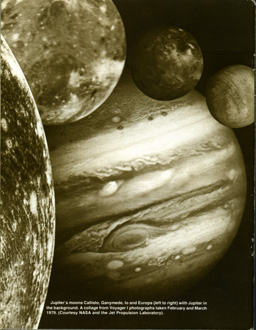
|
![[NAAPO Logo]](../../Images/NAAPOsm.jpg)
 Scientist-philosopher, teacher-cosmologist, father of the Black Hole, Wheeler's thoughts encompass the entire cosmos from the Big Bang to the Big Crunch.
Scientist-philosopher, teacher-cosmologist, father of the Black Hole, Wheeler's thoughts encompass the entire cosmos from the Big Bang to the Big Crunch.
 Wheeler: It was an act of desperation, to force people to believe in it. It was in 1968, at the time of the discussion of whether pulsars were related to neutron stars or to these completely collapsed objects. I wanted a way of emphasizing that these objects were real. Thus, the name "black hole".
Wheeler: It was an act of desperation, to force people to believe in it. It was in 1968, at the time of the discussion of whether pulsars were related to neutron stars or to these completely collapsed objects. I wanted a way of emphasizing that these objects were real. Thus, the name "black hole".
 Wheeler: As a student in 1934, I applied for a fellowship to go to Copenhagen to study with Bohr. I remember writing down my reason on the application:
Wheeler: As a student in 1934, I applied for a fellowship to go to Copenhagen to study with Bohr. I remember writing down my reason on the application:
 My fellowship was granted and the next year I went to study with Bohr, the great leader of physics and father-figure of all physicists. There in Copenhagen, Christian Møller, just back from Rome, reported Fermi's results on the capture of slow neutrons. Bohr immediately became terribly concerned, and interrupting Møller, talked and talked while walking back and forth. All the while you could see the liquid drop model of the nucleus taking shape right there before your eyes. For him no physics was of any interest unless it yielded some paradox or some beautiful way of seeing things simply.
My fellowship was granted and the next year I went to study with Bohr, the great leader of physics and father-figure of all physicists. There in Copenhagen, Christian Møller, just back from Rome, reported Fermi's results on the capture of slow neutrons. Bohr immediately became terribly concerned, and interrupting Møller, talked and talked while walking back and forth. All the while you could see the liquid drop model of the nucleus taking shape right there before your eyes. For him no physics was of any interest unless it yielded some paradox or some beautiful way of seeing things simply.
 During the war I met Bohr in Washington at the time he was dividing his time between Los Alamos and Washington. He told me confidentially about his discussions with President Roosevelt about the future of nuclear energy. He told me about his efforts to work out some kind of control of nuclear energy after the war.
During the war I met Bohr in Washington at the time he was dividing his time between Los Alamos and Washington. He told me confidentially about his discussions with President Roosevelt about the future of nuclear energy. He told me about his efforts to work out some kind of control of nuclear energy after the war.
 Let me put it this way. If you'll permit, let's imagine ourselves as in an ice cave, and let's think of time as pointing upward from the floor. The floor of ice represents the Big Bang. The roof of ice represents the Big Crunch—and some spikes hanging down, icicles, represent black holes. Think of water gradually filling the cave as it comes up, representing the advance of time. No water, and you're back at the Big Bang; a little water, and you're in the early days of the universe. More water and your time level is where we are now. As the water rises—as time goes on—it engulfs a few of the spikes, the icicles—that's the moment when black holes are formed. Keep the water level going on up and you get to the point where the spikes are completely immersed and the water even reaches to the top of the cave. Then you have arrived at the Big Crunch. From this point of view, you can see that the Big Crunch or final Gate of Time is not distinct in nature from the black hole. They're the same kind of animal. In that sense, learning about a black hole is learning about the final stages of the universe.
Let me put it this way. If you'll permit, let's imagine ourselves as in an ice cave, and let's think of time as pointing upward from the floor. The floor of ice represents the Big Bang. The roof of ice represents the Big Crunch—and some spikes hanging down, icicles, represent black holes. Think of water gradually filling the cave as it comes up, representing the advance of time. No water, and you're back at the Big Bang; a little water, and you're in the early days of the universe. More water and your time level is where we are now. As the water rises—as time goes on—it engulfs a few of the spikes, the icicles—that's the moment when black holes are formed. Keep the water level going on up and you get to the point where the spikes are completely immersed and the water even reaches to the top of the cave. Then you have arrived at the Big Crunch. From this point of view, you can see that the Big Crunch or final Gate of Time is not distinct in nature from the black hole. They're the same kind of animal. In that sense, learning about a black hole is learning about the final stages of the universe.

 John Archibald Wheeler has been at the forefront of theoretical physics for nearly five decades. In the 1930's, with
Niels Bohr, he developed the first general theory of nuclear fission. In the 1940's, with a student, Richard Feynman, he discovered a new approach to electrodynamics which has proven to be of great value. In the 1950's he found new solutions to Einstein's gravitational equations of importance in astrophysics. In the 1960s he pioneered studies involving gravitational collapse, neutron stars and Black Holes (a name he invented). More recently Wheeler has proposed and analyzed "delayed
choice" experiments. In them a difference in what one measures on the particle—or photon—now makes an irretrievable difference in what one has the right to say the particle already did in the past. This effect, which makes it impossible to monitor the events of nature with complete detachment, he calls "observer-participancy".
John Archibald Wheeler has been at the forefront of theoretical physics for nearly five decades. In the 1930's, with
Niels Bohr, he developed the first general theory of nuclear fission. In the 1940's, with a student, Richard Feynman, he discovered a new approach to electrodynamics which has proven to be of great value. In the 1950's he found new solutions to Einstein's gravitational equations of importance in astrophysics. In the 1960s he pioneered studies involving gravitational collapse, neutron stars and Black Holes (a name he invented). More recently Wheeler has proposed and analyzed "delayed
choice" experiments. In them a difference in what one measures on the particle—or photon—now makes an irretrievable difference in what one has the right to say the particle already did in the past. This effect, which makes it impossible to monitor the events of nature with complete detachment, he calls "observer-participancy".



























 Karl Guthe Jansky was born on October 22, 1905, in what was then the Territory of Oklahoma where his father, Cyril M. Jansky, was Dean of the College of Engineering at the University of Oklahoma at Norman. Dean Jansky, born in Wisconsin of Czech immigrants, had started teaching at the age of sixteen. He was a teacher throughout his active life, retiring as Professor of Electrical Engineering at the University of Wisconsin. Karl Jansky's mother, nee Nellie Moreau, was of French and English parentage.
Karl Guthe Jansky was born on October 22, 1905, in what was then the Territory of Oklahoma where his father, Cyril M. Jansky, was Dean of the College of Engineering at the University of Oklahoma at Norman. Dean Jansky, born in Wisconsin of Czech immigrants, had started teaching at the age of sixteen. He was a teacher throughout his active life, retiring as Professor of Electrical Engineering at the University of Wisconsin. Karl Jansky's mother, nee Nellie Moreau, was of French and English parentage.
 Karl Jansky was no bookworm. He was an excellent tennis player and an outstanding star on the University of Wisconsin's ice hockey team. Later, while with Bell Telephone Laboratories, he became the table tennis champion of Monmouth County, New Jersey.
Karl Jansky was no bookworm. He was an excellent tennis player and an outstanding star on the University of Wisconsin's ice hockey team. Later, while with Bell Telephone Laboratories, he became the table tennis champion of Monmouth County, New Jersey.
 It is unrealistic and, therefore, unscientific to underestimate the impact of the element of chance on human destiny or as a factor affecting man's acquisition of knowledge concerning the universe in which he lives. This in no way detracts from the credit due those who take the fullest advantage of the opportunity chance affords. When Karl Jansky applied for a position with Bell Telephone Laboratories in 1928 he was at first turned down for physical reasons. It so happened that ten years previously I had been a member of the staff of the Bell System Laboratories and more recently, while a member of the faculty of the University of Minnesota, I had spent summers at the Laboratories. Therefore, by chance, I happened to be in a position to argue with members of the personnel department, with whom I was well acquainted, that Karl Jansky was a good risk. This may have had some small influence in the Laboratories' decision to hire him. Certainly, Bell Telephone Laboratories and the world of science never had reason to regret this decision.
It is unrealistic and, therefore, unscientific to underestimate the impact of the element of chance on human destiny or as a factor affecting man's acquisition of knowledge concerning the universe in which he lives. This in no way detracts from the credit due those who take the fullest advantage of the opportunity chance affords. When Karl Jansky applied for a position with Bell Telephone Laboratories in 1928 he was at first turned down for physical reasons. It so happened that ten years previously I had been a member of the staff of the Bell System Laboratories and more recently, while a member of the faculty of the University of Minnesota, I had spent summers at the Laboratories. Therefore, by chance, I happened to be in a position to argue with members of the personnel department, with whom I was well acquainted, that Karl Jansky was a good risk. This may have had some small influence in the Laboratories' decision to hire him. Certainly, Bell Telephone Laboratories and the world of science never had reason to regret this decision.
 About March 1929, Karl Jansky began the design of a 14.6 meter rotatable, directional antenna system and the development of the associated receiving apparatus. Construction of the antenna was started in August 1929. At the same time he was still working on the study of static on long wavelengths. In 1930, the Laboratories' field station with which he was connected was moved from Cliffwood to Holmdel, New Jersey. Therefore, it was not until the fall of 1930 that the 14.6 meter rotatable antenna and its associated receiving and recording equipment were in good working order. Next came the long period of time devoted to the unimpressive, prosaic and laborious taking of data, that is, data on the characteristics and intensity of static received on 14.6 meters as a function of two variables—(a) time, and (b) direction.
About March 1929, Karl Jansky began the design of a 14.6 meter rotatable, directional antenna system and the development of the associated receiving apparatus. Construction of the antenna was started in August 1929. At the same time he was still working on the study of static on long wavelengths. In 1930, the Laboratories' field station with which he was connected was moved from Cliffwood to Holmdel, New Jersey. Therefore, it was not until the fall of 1930 that the 14.6 meter rotatable antenna and its associated receiving and recording equipment were in good working order. Next came the long period of time devoted to the unimpressive, prosaic and laborious taking of data, that is, data on the characteristics and intensity of static received on 14.6 meters as a function of two variables—(a) time, and (b) direction.
 In a paper titled, "Directional Studies of Atmospherics at High Frequencies", presented at Washington, D.C. in April 1932 before the International Scientific Radio Union, Karl Jansky described his equipment and classified the types of static he was receiving on 14.6 meters into three distinct groups. The first group he described as static from local thunderstorms, and the second as static from thunderstorms some distance away. Then he stated, "the third group is composed of a very steady hiss static the origin of which is not yet known." While he speculated on the possible source of this new type of static, it is important to note his comment that "the data as yet only cover observations taken over a few months and more observations are necessary before any hard and fast deductions can be drawn."
In a paper titled, "Directional Studies of Atmospherics at High Frequencies", presented at Washington, D.C. in April 1932 before the International Scientific Radio Union, Karl Jansky described his equipment and classified the types of static he was receiving on 14.6 meters into three distinct groups. The first group he described as static from local thunderstorms, and the second as static from thunderstorms some distance away. Then he stated, "the third group is composed of a very steady hiss static the origin of which is not yet known." While he speculated on the possible source of this new type of static, it is important to note his comment that "the data as yet only cover observations taken over a few months and more observations are necessary before any hard and fast deductions can be drawn."

 C. M. Jansky, Jr. (1895-1975) was born in Barry County, Michigan. After receiving the B.S. and M.S. degrees in physics from the University of Wisconsin in 1917 and 1919, respectively, he taught radio communications and electronics at the University of Minnesota from 1920 to 1929, becoming associate professor of radio engineering. In 1920 he established the first radio broadcasting station west of the Mississippi River at Minneapolis, Minnesota.
C. M. Jansky, Jr. (1895-1975) was born in Barry County, Michigan. After receiving the B.S. and M.S. degrees in physics from the University of Wisconsin in 1917 and 1919, respectively, he taught radio communications and electronics at the University of Minnesota from 1920 to 1929, becoming associate professor of radio engineering. In 1920 he established the first radio broadcasting station west of the Mississippi River at Minneapolis, Minnesota.
 The search for extraterrestrials has quite a history prior to the advent of Project Ozma in 1960. Long ago, the idea of communicating with inhabitants of other worlds was regarded as fantasy, forever unattainable. But as telescopes grew in size and knowledge of the heavens increased, and as our technology improved, the time at last seemed opportune to consider seriously the problem of extraterrestrial communication. A century or more ago, in the absence of adequate techniques, attempts to communicate with extraterrestrial beings were confined to modest goals within the solar system and Mars was selected as the most appropriate candidate.
The search for extraterrestrials has quite a history prior to the advent of Project Ozma in 1960. Long ago, the idea of communicating with inhabitants of other worlds was regarded as fantasy, forever unattainable. But as telescopes grew in size and knowledge of the heavens increased, and as our technology improved, the time at last seemed opportune to consider seriously the problem of extraterrestrial communication. A century or more ago, in the absence of adequate techniques, attempts to communicate with extraterrestrial beings were confined to modest goals within the solar system and Mars was selected as the most appropriate candidate.
 Some of these are still in use.
Some of these are still in use.
 In 1932 came the serendipitous discovery by Karl Jansky of radio waves from the center of the Milky Way in the constellation Sagittarius. Here was the first evidence that celestial bodies could emit waves other than light, thus giving birth to radio astronomy. Jansky, a radio engineer at the Bell Telephone Laboratories in New Jersey, had been assigned the task of identifying the static noises plaguing trans-Atlantic radio telephone communications. He constructed a 30 meter antenna system tuned to 14.5 meters. It was mounted on a rotatable wooden frame which rolled on four wheels running on a circular track (see photo to the right; from inside back cover). He employed a very sensitive receiver coupled to a continuous recorder. In addition to registering the crackling noises arising from local and distant thunderstorms, he later succeeded in singling out a weak static noise that was hardly distinguishable from the receiver's internal noise. In headphones he could hear a faint hissing whenever the antenna pointed toward the direction of Sagittarius in the sky.
In 1932 came the serendipitous discovery by Karl Jansky of radio waves from the center of the Milky Way in the constellation Sagittarius. Here was the first evidence that celestial bodies could emit waves other than light, thus giving birth to radio astronomy. Jansky, a radio engineer at the Bell Telephone Laboratories in New Jersey, had been assigned the task of identifying the static noises plaguing trans-Atlantic radio telephone communications. He constructed a 30 meter antenna system tuned to 14.5 meters. It was mounted on a rotatable wooden frame which rolled on four wheels running on a circular track (see photo to the right; from inside back cover). He employed a very sensitive receiver coupled to a continuous recorder. In addition to registering the crackling noises arising from local and distant thunderstorms, he later succeeded in singling out a weak static noise that was hardly distinguishable from the receiver's internal noise. In headphones he could hear a faint hissing whenever the antenna pointed toward the direction of Sagittarius in the sky.
 It remained for the radio engineer, Grote Reber, to carry on where Jansky had left off. In 1937 Reber constructed the first large parabolic radio dish, 10 meters in diameter, in his back yard at Wheaton, Illinois. This radio telescope operated at a wavelength of about 2 meters and could distinguish more detail than Jansky's antenna. After several years of observing Reber was able to put together a map of the radio sky (see below right) which revealed the presence of several discrete radio sources as well as the diffuse radio emission coming from the direction of the center of the Milky Way, previously discovered by Jansky. His results, published in 1940 in the Proceedings of the Institute of Radio Engineers and in the Astrophysical Journal, attracted the attention of a few astronomers but World War II intervened and many astronomers became involved in the war effort.
It remained for the radio engineer, Grote Reber, to carry on where Jansky had left off. In 1937 Reber constructed the first large parabolic radio dish, 10 meters in diameter, in his back yard at Wheaton, Illinois. This radio telescope operated at a wavelength of about 2 meters and could distinguish more detail than Jansky's antenna. After several years of observing Reber was able to put together a map of the radio sky (see below right) which revealed the presence of several discrete radio sources as well as the diffuse radio emission coming from the direction of the center of the Milky Way, previously discovered by Jansky. His results, published in 1940 in the Proceedings of the Institute of Radio Engineers and in the Astrophysical Journal, attracted the attention of a few astronomers but World War II intervened and many astronomers became involved in the war effort.
 However, some serendipitous radio astronomy observations occurred during the war. Late in February 1942 the 5 meter wavelength British early-warning radar system overlooking the English channel suddenly became inoperative because of a very strong noise-type signal. Enemy jamming was suspected but further investigation by British radio physicist J. S. Hey identified the sun, then undergoing a flare outburst, as the source of the noise. Later a radar installation used to detect incoming V-2s picked up radio noises from various celestial sources. This information was kept confidential until after the war. When the war ended in 1945, radio engineers, physicists and astronomers rapidly expanded the field of radio astronomy with the construction of ever larger radio telescopes. At the National Radio Astronomy Observatory in Green Bank, West Virginia, scientist Frank Drake, with the support of Director Otto Struve, began to entertain the idea that the time was ripe to look for intelligent signals from outer space although many scientists were not so disposed and some were scathingly critical. The idea gained respectability with the historic publication in the September 19, 1959, issue of Nature of an article by Giuseppe Cocconi and Philip Morrison who recommended that a search for intelligent signals from beyond the solar system should be instituted with existing large radio telescopes in the microwave region around 21 centimeters wavelength. At that time the largest radio telescope was the 76 meter dish at Jodrell Bank, England, but its director, Sir Bernard Lovell, expressed no enthusiasm in using it to search for extrasolar intelligence. He later changed his mind about the Cocconi-Morrison suggestion, but the telescope was never used in that capacity. This is where COSMIC SEARCH comes in and takes over the story in its first issue of January 1979.
However, some serendipitous radio astronomy observations occurred during the war. Late in February 1942 the 5 meter wavelength British early-warning radar system overlooking the English channel suddenly became inoperative because of a very strong noise-type signal. Enemy jamming was suspected but further investigation by British radio physicist J. S. Hey identified the sun, then undergoing a flare outburst, as the source of the noise. Later a radar installation used to detect incoming V-2s picked up radio noises from various celestial sources. This information was kept confidential until after the war. When the war ended in 1945, radio engineers, physicists and astronomers rapidly expanded the field of radio astronomy with the construction of ever larger radio telescopes. At the National Radio Astronomy Observatory in Green Bank, West Virginia, scientist Frank Drake, with the support of Director Otto Struve, began to entertain the idea that the time was ripe to look for intelligent signals from outer space although many scientists were not so disposed and some were scathingly critical. The idea gained respectability with the historic publication in the September 19, 1959, issue of Nature of an article by Giuseppe Cocconi and Philip Morrison who recommended that a search for intelligent signals from beyond the solar system should be instituted with existing large radio telescopes in the microwave region around 21 centimeters wavelength. At that time the largest radio telescope was the 76 meter dish at Jodrell Bank, England, but its director, Sir Bernard Lovell, expressed no enthusiasm in using it to search for extrasolar intelligence. He later changed his mind about the Cocconi-Morrison suggestion, but the telescope was never used in that capacity. This is where COSMIC SEARCH comes in and takes over the story in its first issue of January 1979.

 Louis Berman is adjunct professor of astronomy at the University of San Francisco. He has taught courses in mathematics, physics and astronomy at the City College of San Francisco and the history of rocketry at the State University of San Francisco. Born in 1903 in London, England, he received his bachelor's and master's degrees at the University of Minnesota (1925, 1927) and his doctorate as a Lick Observatory Fellow from the University of California at Berkeley (1929).
Louis Berman is adjunct professor of astronomy at the University of San Francisco. He has taught courses in mathematics, physics and astronomy at the City College of San Francisco and the history of rocketry at the State University of San Francisco. Born in 1903 in London, England, he received his bachelor's and master's degrees at the University of Minnesota (1925, 1927) and his doctorate as a Lick Observatory Fellow from the University of California at Berkeley (1929).
 Wind too had yielded its fury to the needs of life. The air had roamed wildly over the land, madly stirring the dust and scattering the clouds, yet now some of its molecules left that world for one that contained its own landscape of winds, a self-contained whirlwind that sucked in matter and twirled it into greater and greater order, up the winding staircase of DNA, up the interwoven patterns of cells, up to the superstructure of leaves and roots. The molecules that could only riot across the land began a fine weaving and interweaving with other molecules that had come out of the same chaos, together producing the matchless fabric of life.
Wind too had yielded its fury to the needs of life. The air had roamed wildly over the land, madly stirring the dust and scattering the clouds, yet now some of its molecules left that world for one that contained its own landscape of winds, a self-contained whirlwind that sucked in matter and twirled it into greater and greater order, up the winding staircase of DNA, up the interwoven patterns of cells, up to the superstructure of leaves and roots. The molecules that could only riot across the land began a fine weaving and interweaving with other molecules that had come out of the same chaos, together producing the matchless fabric of life.
 In the distance beyond the desert plant stood another structure whose form revealed it to be a work of life. It too was a leaf, pointing towards the sky to absorb the energies of the stars. Yet this leaf was vastly larger than those of the plant, and was composed not of the whirling molecules of cells, but of firm steel. The plant captured energy in chloroplasts, while the metal leaf used a more massive form of electronics. The plant only wanted to fill itself with the sun, but the larger leaf wanted to absorb the energies of the farthest galaxies, many of them so old that they had died a billion years before, leaving only their electromagnetic ghosts to haunt the universe.
In the distance beyond the desert plant stood another structure whose form revealed it to be a work of life. It too was a leaf, pointing towards the sky to absorb the energies of the stars. Yet this leaf was vastly larger than those of the plant, and was composed not of the whirling molecules of cells, but of firm steel. The plant captured energy in chloroplasts, while the metal leaf used a more massive form of electronics. The plant only wanted to fill itself with the sun, but the larger leaf wanted to absorb the energies of the farthest galaxies, many of them so old that they had died a billion years before, leaving only their electromagnetic ghosts to haunt the universe.

 Referring to the Doppler Effect Diagram, suppose a source of waves is moving to the right. When it was at position 1, it sent out the crest of a wave, by the time the source reached position 2 it sent out another crest and so on. By the time it reached position 5, the previously emitted crests had expanded to the circles shown. The wavelength (or crest to crest) distance is less in the direction toward which the source is traveling (to the right) and greater in the direction from which it is receding (left). This is the Doppler effect. Perpendicular to the direction the source is traveling, the wavelength is normal (no Doppler effect). Suppose that the source is sending out a sound wave in air at middle-C. Then an observer to the right hears high-C (wavelength halved), while an observer to the left hears F-below-middle-C (wavelength 50 percent longer).
Referring to the Doppler Effect Diagram, suppose a source of waves is moving to the right. When it was at position 1, it sent out the crest of a wave, by the time the source reached position 2 it sent out another crest and so on. By the time it reached position 5, the previously emitted crests had expanded to the circles shown. The wavelength (or crest to crest) distance is less in the direction toward which the source is traveling (to the right) and greater in the direction from which it is receding (left). This is the Doppler effect. Perpendicular to the direction the source is traveling, the wavelength is normal (no Doppler effect). Suppose that the source is sending out a sound wave in air at middle-C. Then an observer to the right hears high-C (wavelength halved), while an observer to the left hears F-below-middle-C (wavelength 50 percent longer).
 The change in the temperature of the universe with time is shown in the accompanying Cosmic Temperature Graph. The present age of the universe is taken as 15 billion years, with galaxies forming 5 billion years after the big bang (time zero) and the solar system (with the earth) forming 10 billion years after time zero (see the Cosmic Calendar).
The change in the temperature of the universe with time is shown in the accompanying Cosmic Temperature Graph. The present age of the universe is taken as 15 billion years, with galaxies forming 5 billion years after the big bang (time zero) and the solar system (with the earth) forming 10 billion years after time zero (see the Cosmic Calendar).
 Everything in the universe from enormous galaxies to tiny atoms has a size, which can be expressed as a maximum length or diameter and a mass. The accompanying Mass-Size displays objects from a helium nucleus to clusters of galaxies and the universe itself, each point on the chart indicating the mass of an object (in kilograms) and its size (in meters).
Everything in the universe from enormous galaxies to tiny atoms has a size, which can be expressed as a maximum length or diameter and a mass. The accompanying Mass-Size displays objects from a helium nucleus to clusters of galaxies and the universe itself, each point on the chart indicating the mass of an object (in kilograms) and its size (in meters).

 Two Voyager spacecraft are currently heading out toward the planets Jupiter, Saturn and points beyond, to leave the Solar System in 1989 when they cross the orbit of distant Pluto. Plodding through the interstellar abyss at 17 kilometers per second, they will take at least 40,000 years before either spacecraft approaches another star, passing it at a distance of about one light-year, travelling for eternity into infinity. Each carries a 12-inch copper disk with a recording of greetings in 54 human languages, one whale language, sounds of Earth, photographs and drawings, and musical selections. The printed words include a message from President Jimmy Carter which reads in part:
Two Voyager spacecraft are currently heading out toward the planets Jupiter, Saturn and points beyond, to leave the Solar System in 1989 when they cross the orbit of distant Pluto. Plodding through the interstellar abyss at 17 kilometers per second, they will take at least 40,000 years before either spacecraft approaches another star, passing it at a distance of about one light-year, travelling for eternity into infinity. Each carries a 12-inch copper disk with a recording of greetings in 54 human languages, one whale language, sounds of Earth, photographs and drawings, and musical selections. The printed words include a message from President Jimmy Carter which reads in part:






 Combining this new information with previous data, Stecker concludes that the ring is a veritable hotbox of activity. It appears to be the "galactic nursery" where most of the large and bright stars are being born. Since these stars burn up relatively quickly, this ring is also the "galactic fireworks factory" where these stars become supernovae. These supernovae often leave behind rhythmically-ticking pulsars, so the ring might also be referred to as the "galactic clockworks".
Combining this new information with previous data, Stecker concludes that the ring is a veritable hotbox of activity. It appears to be the "galactic nursery" where most of the large and bright stars are being born. Since these stars burn up relatively quickly, this ring is also the "galactic fireworks factory" where these stars become supernovae. These supernovae often leave behind rhythmically-ticking pulsars, so the ring might also be referred to as the "galactic clockworks".




 During 1975 and 1976, several of us at SRI (then known as the Stanford Research Institute) did a study for the SETI Program Office at the National Aeronautics and Space Administration (NASA) to find out what kind of antenna system would be best suited to searching for a radio signal from outer space. We developed a methodology that allowed us to compare such different concepts as antennas on earth, in space, and on the moon, and we found that space systems are the best if we need to examine more than a few hundred thousand stars in our search for an intelligent signal.
During 1975 and 1976, several of us at SRI (then known as the Stanford Research Institute) did a study for the SETI Program Office at the National Aeronautics and Space Administration (NASA) to find out what kind of antenna system would be best suited to searching for a radio signal from outer space. We developed a methodology that allowed us to compare such different concepts as antennas on earth, in space, and on the moon, and we found that space systems are the best if we need to examine more than a few hundred thousand stars in our search for an intelligent signal.
 There are only two viable alternatives for an interstellar search system on earth. One is an array of fully-steerable
parabolic dishes such as that described in the Cyclops study conducted by NASA in the summer of 1971. The other is an
array of fixed spherical dishes similar to the one in operation near Arecibo, Puerto Rico, in a natural sinkhole in the
Karst topography of that region. A 305-meter Arecibo dish, compared to a 100-meter Cyclops dish, costs less per unit
area, but covers less sky because of its more limited steering capability. When arrays of these dishes are compared
on the basis of the number of stars they can examine, it is found that they do not differ significantly in terms of overall cost. Cyclops is thus suggested as the preferred design for an earth-based SETI system because it has fewer constraints on its operation and its possible location than an Arecibo-type system.
There are only two viable alternatives for an interstellar search system on earth. One is an array of fully-steerable
parabolic dishes such as that described in the Cyclops study conducted by NASA in the summer of 1971. The other is an
array of fixed spherical dishes similar to the one in operation near Arecibo, Puerto Rico, in a natural sinkhole in the
Karst topography of that region. A 305-meter Arecibo dish, compared to a 100-meter Cyclops dish, costs less per unit
area, but covers less sky because of its more limited steering capability. When arrays of these dishes are compared
on the basis of the number of stars they can examine, it is found that they do not differ significantly in terms of overall cost. Cyclops is thus suggested as the preferred design for an earth-based SETI system because it has fewer constraints on its operation and its possible location than an Arecibo-type system.
 An orbiting antenna system has several attractive features. It has complete sky coverage, it can track a given star continuously if a signal is detected, and the weightless, weatherless environment in space gives it long life and allows it to be structurally simple. In addition, the time required to search a large number of stars can be substantially reduced by using multiple free-floating feed systems with a single primary receiving dish to form several simultaneous beams.
An orbiting antenna system has several attractive features. It has complete sky coverage, it can track a given star continuously if a signal is detected, and the weightless, weatherless environment in space gives it long life and allows it to be structurally simple. In addition, the time required to search a large number of stars can be substantially reduced by using multiple free-floating feed systems with a single primary receiving dish to form several simultaneous beams.
 The far side of the moon is an attractive site for an interstellar search system primarily because it is always facing away from the earth and is thus completely free from radio frequency interference from transmitters either on earth or in orbit around the earth. The absence of a substantial atmosphere and the relatively weak gravitational force also provide an advantage for lunar systems because they can be much less massive than similar structures on earth. A serious disadvantage, however, is the high cost of building and operating a system on the moon.
The far side of the moon is an attractive site for an interstellar search system primarily because it is always facing away from the earth and is thus completely free from radio frequency interference from transmitters either on earth or in orbit around the earth. The absence of a substantial atmosphere and the relatively weak gravitational force also provide an advantage for lunar systems because they can be much less massive than similar structures on earth. A serious disadvantage, however, is the high cost of building and operating a system on the moon.
 Roy P. Basler is a specialist in the design and evaluation of large-scale systems such as the SETI systems he discusses in his article. Born in Florence, Alabama, in 1935, he received an A.B. degree from Hamilton College, Clinton, New York, in 1956, and an M.S. in geophysics in 1961 and Ph.D. in physics in 1964 from the University of Alaska. Since 1973 he has been at the Stanford Research Institute (SRI), now SRI International, Menlo Park, California 94025, where he is senior physicist in the Radio Physics Laboratory of the Systems Research and Analysis Division. He is author of numerous technical articles, many dealing with ionospheric and auroral phenomena.
Roy P. Basler is a specialist in the design and evaluation of large-scale systems such as the SETI systems he discusses in his article. Born in Florence, Alabama, in 1935, he received an A.B. degree from Hamilton College, Clinton, New York, in 1956, and an M.S. in geophysics in 1961 and Ph.D. in physics in 1964 from the University of Alaska. Since 1973 he has been at the Stanford Research Institute (SRI), now SRI International, Menlo Park, California 94025, where he is senior physicist in the Radio Physics Laboratory of the Systems Research and Analysis Division. He is author of numerous technical articles, many dealing with ionospheric and auroral phenomena.







